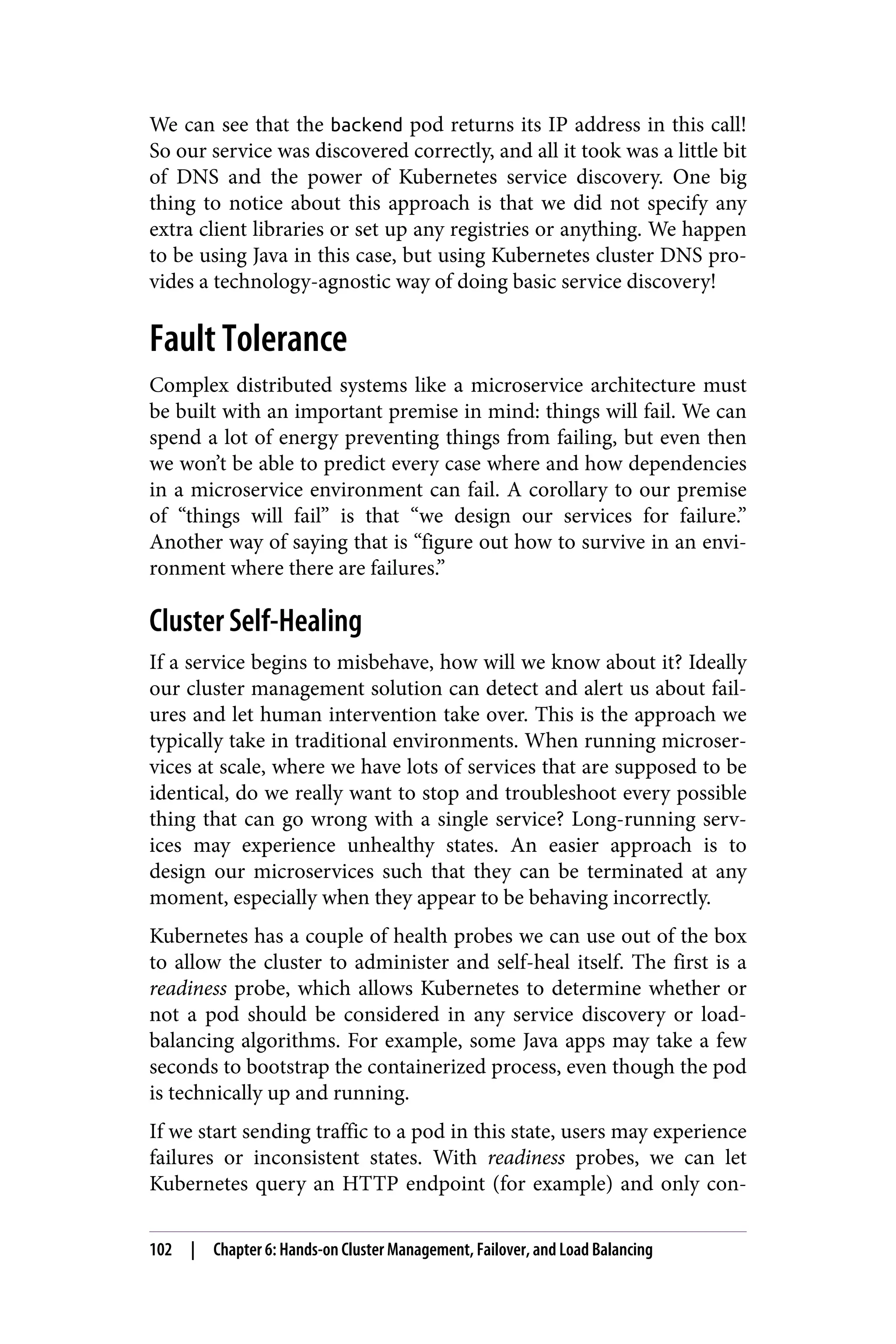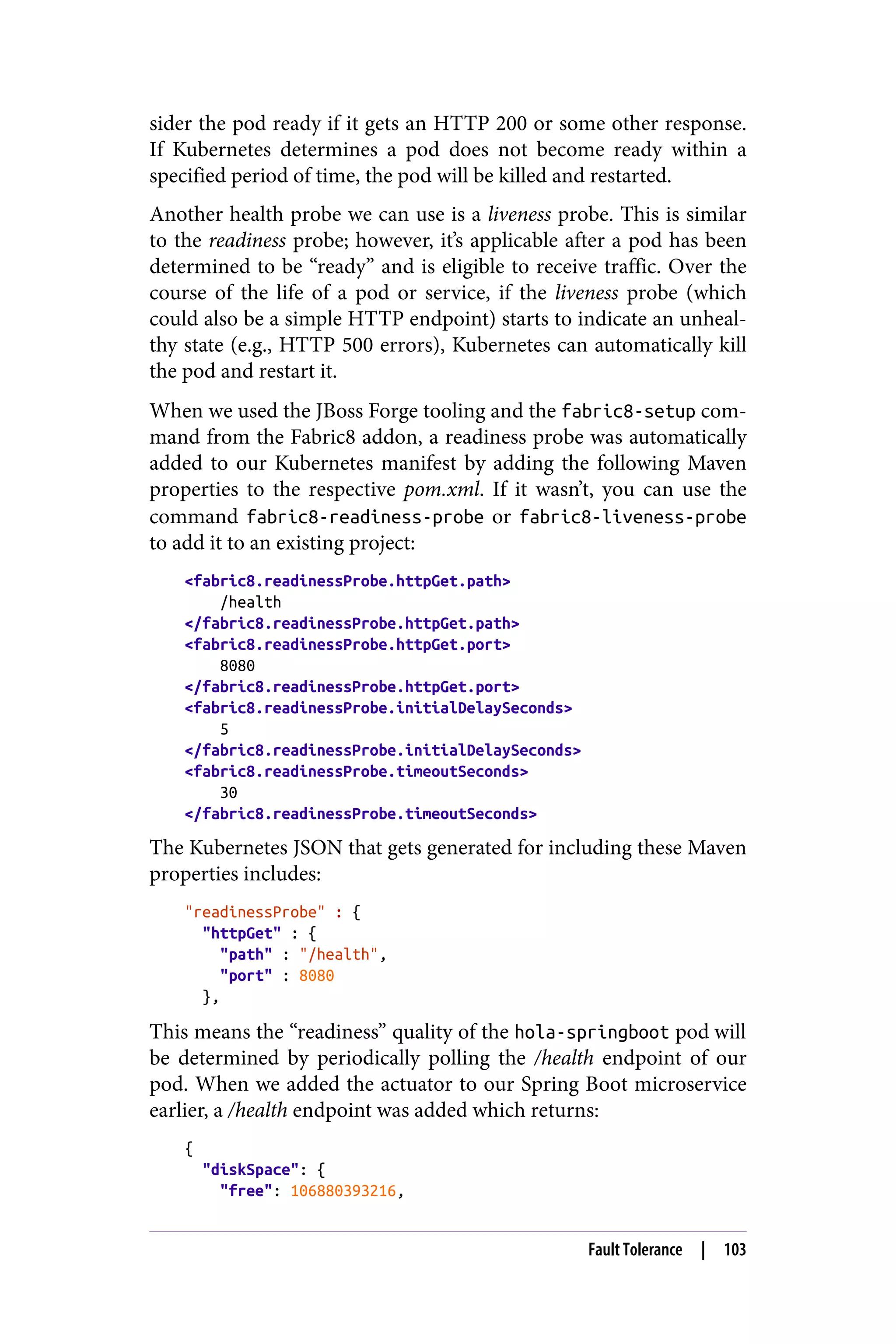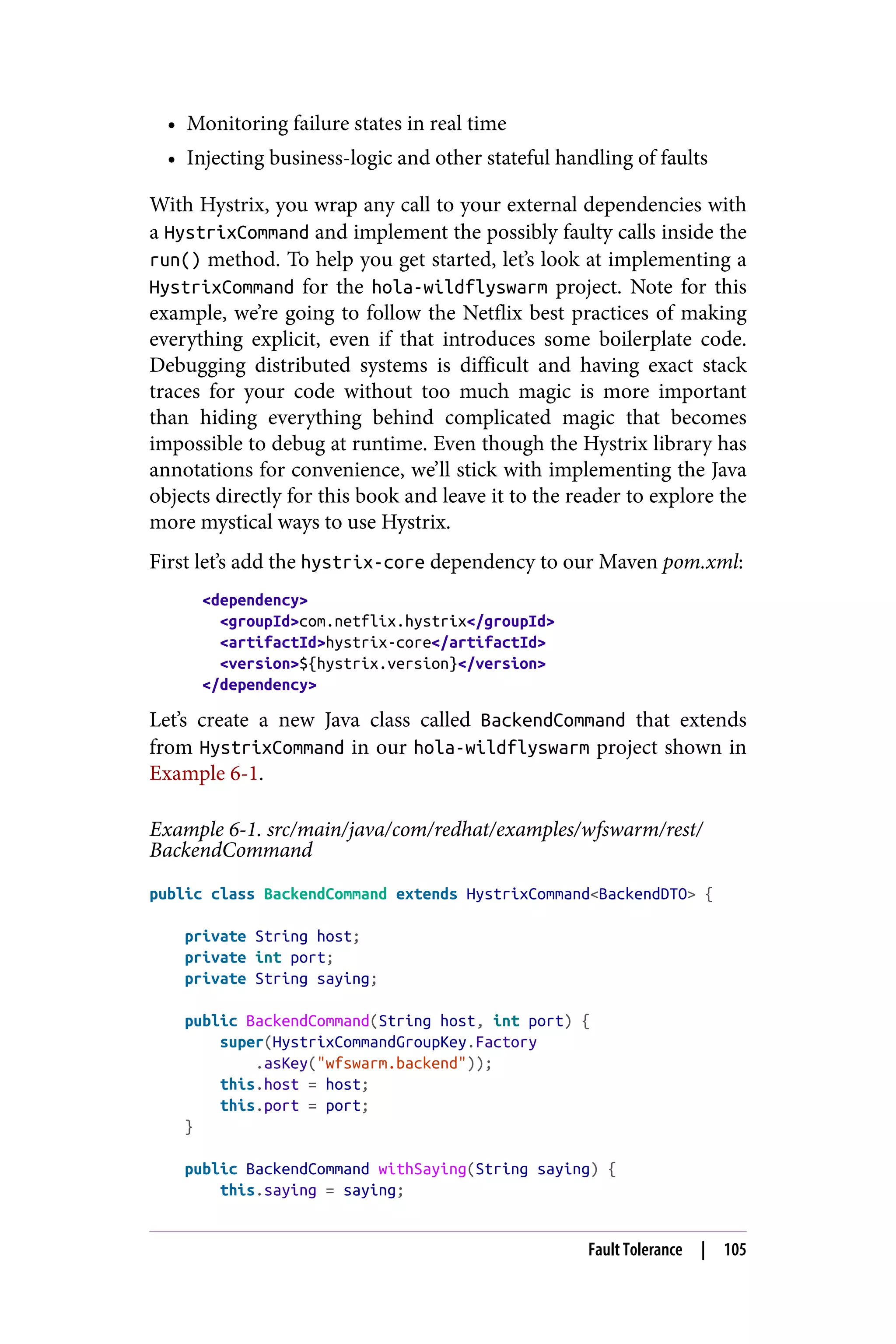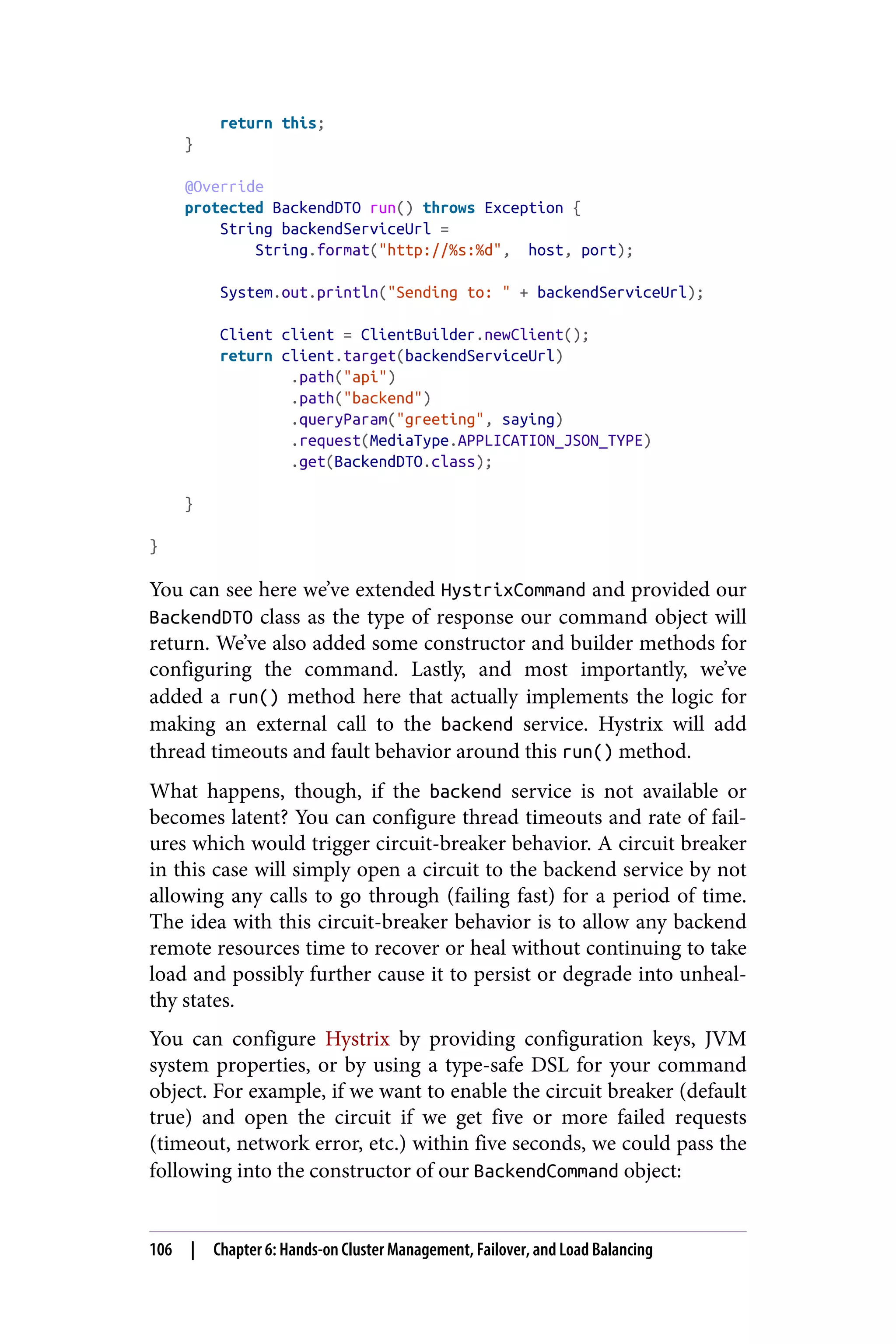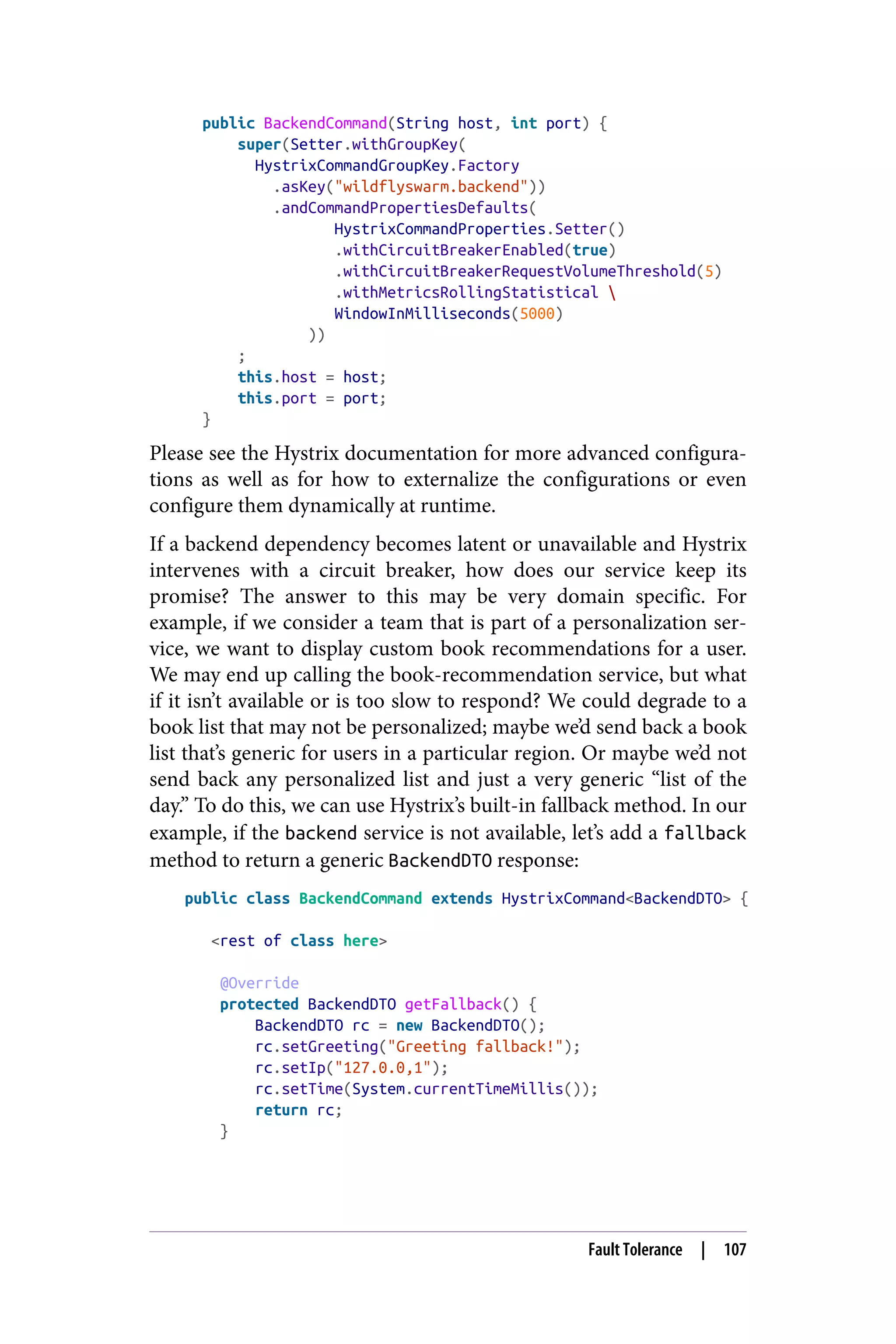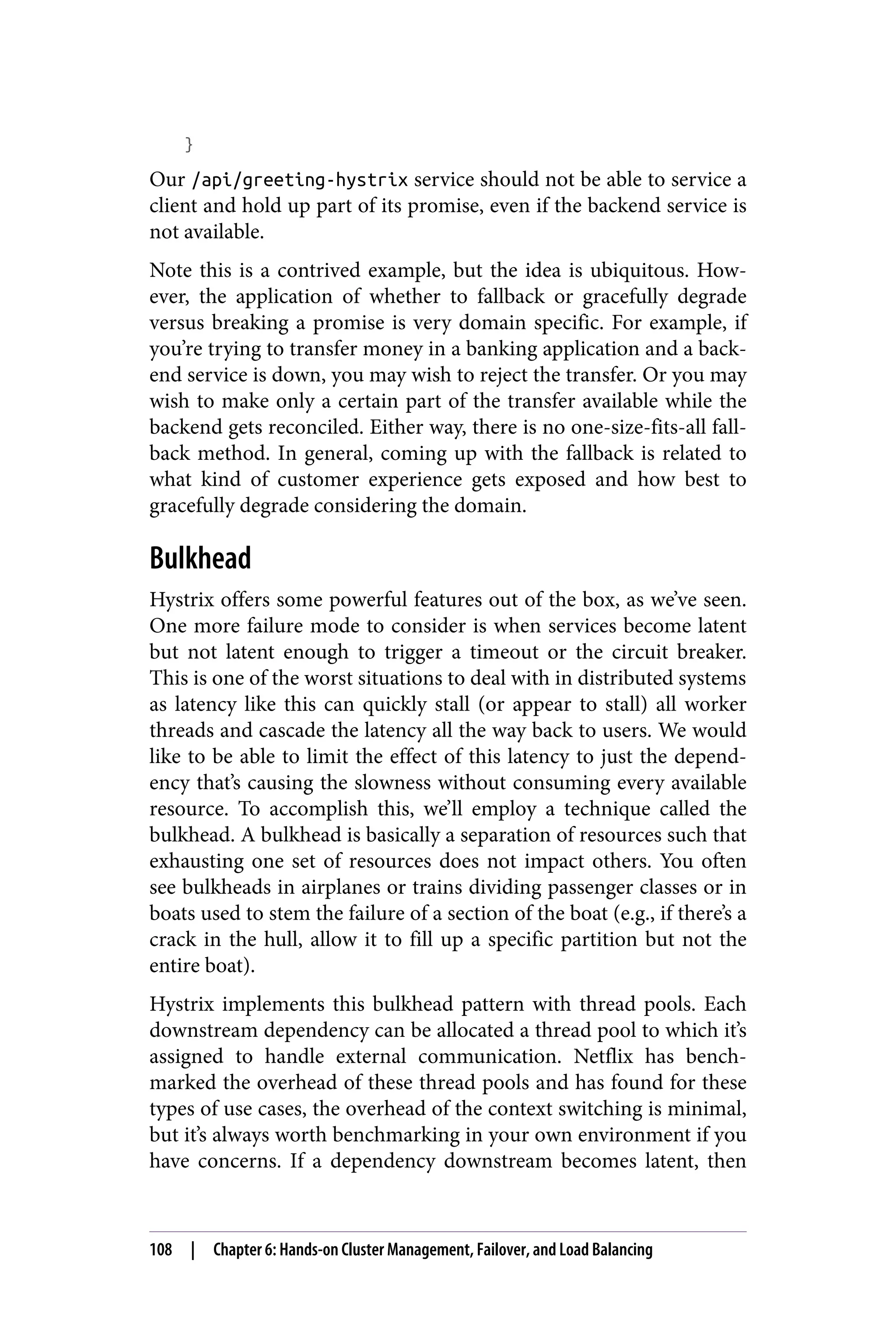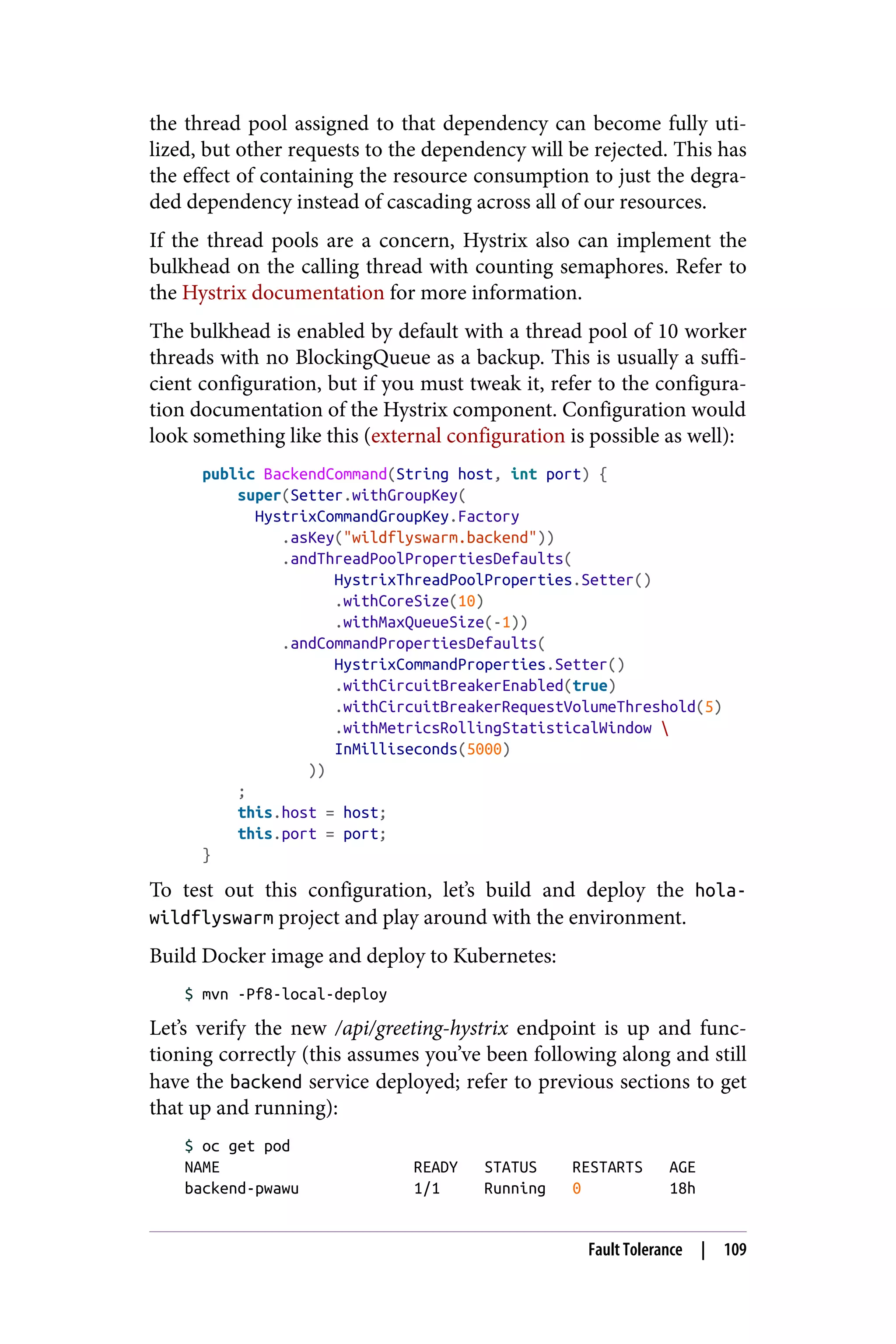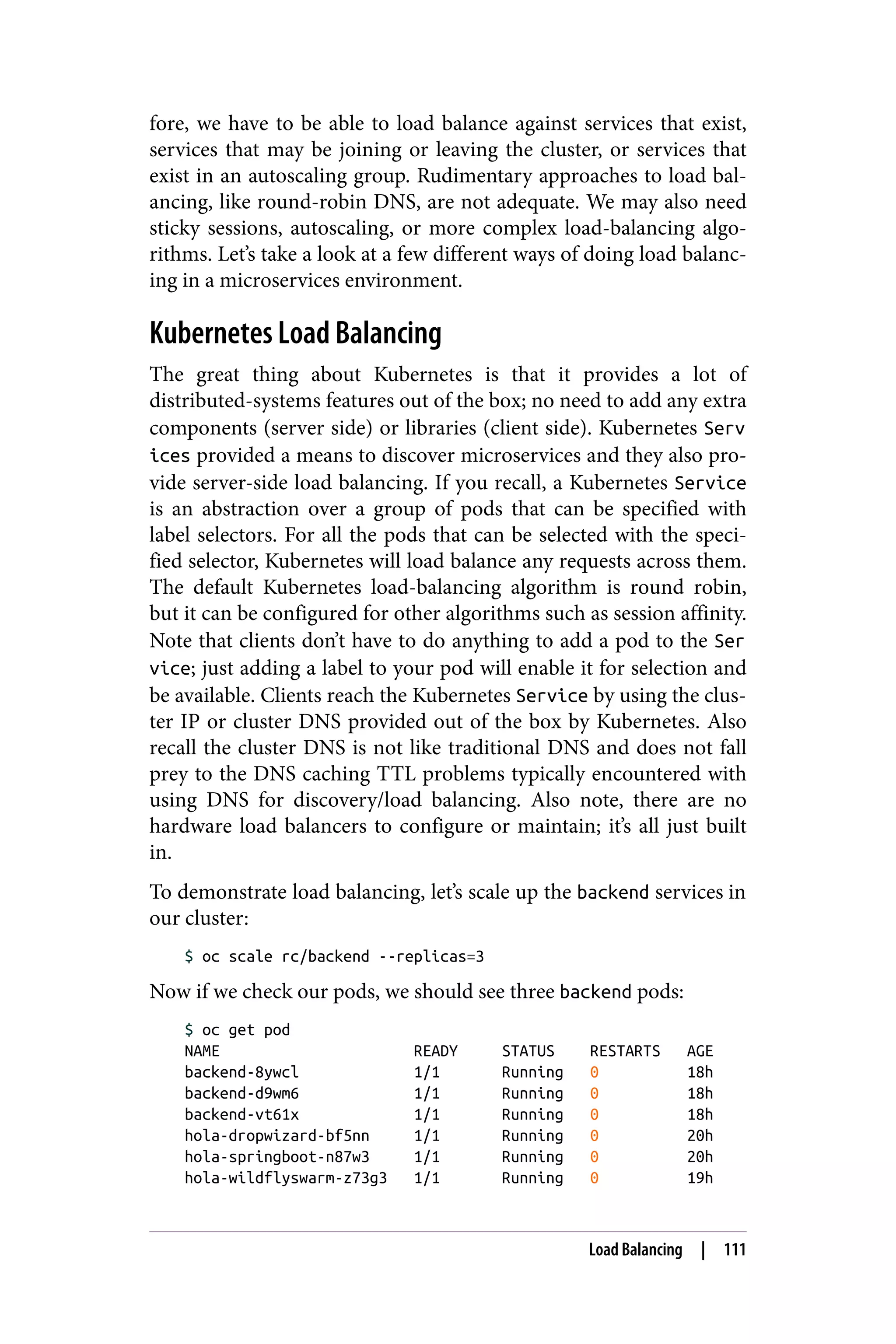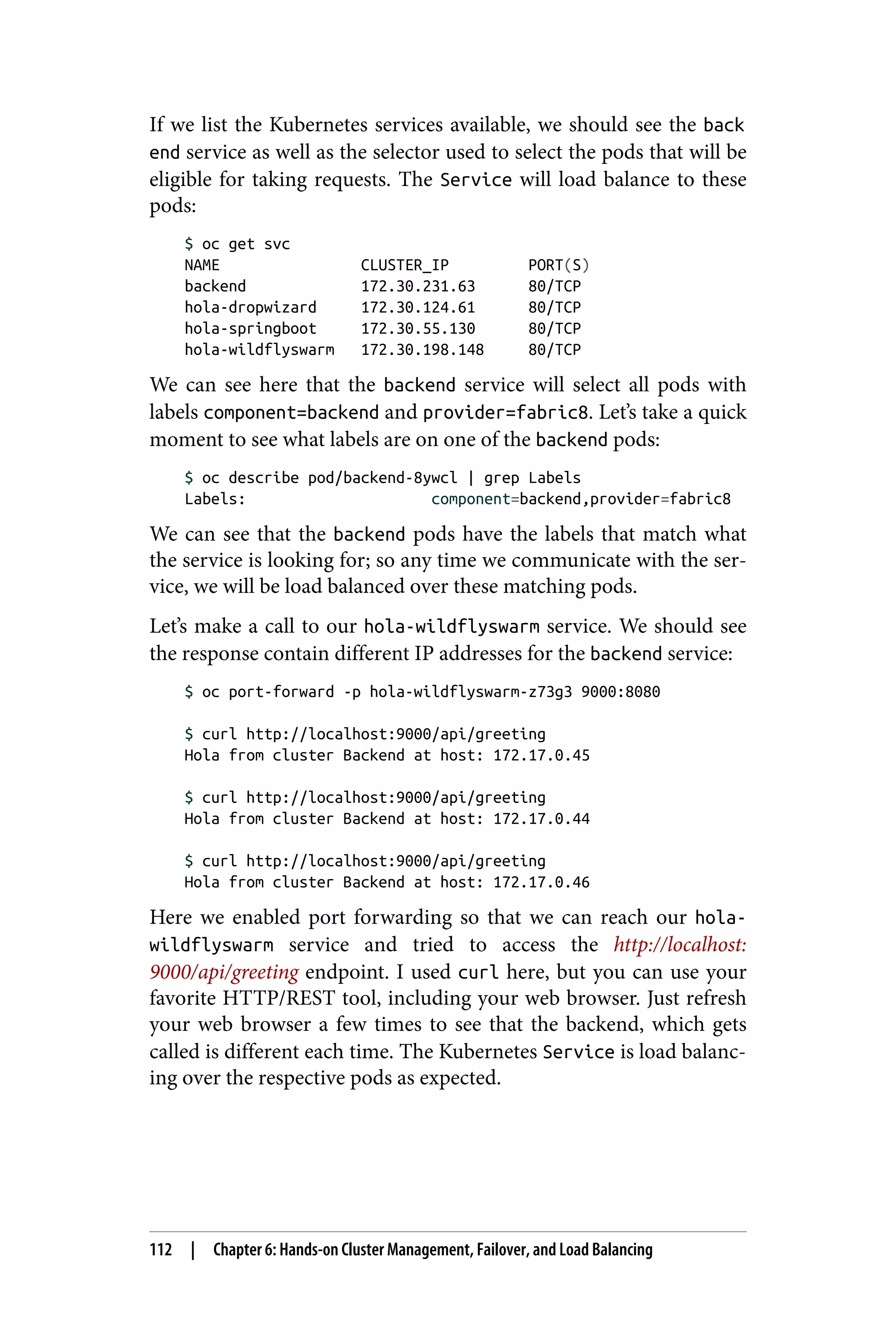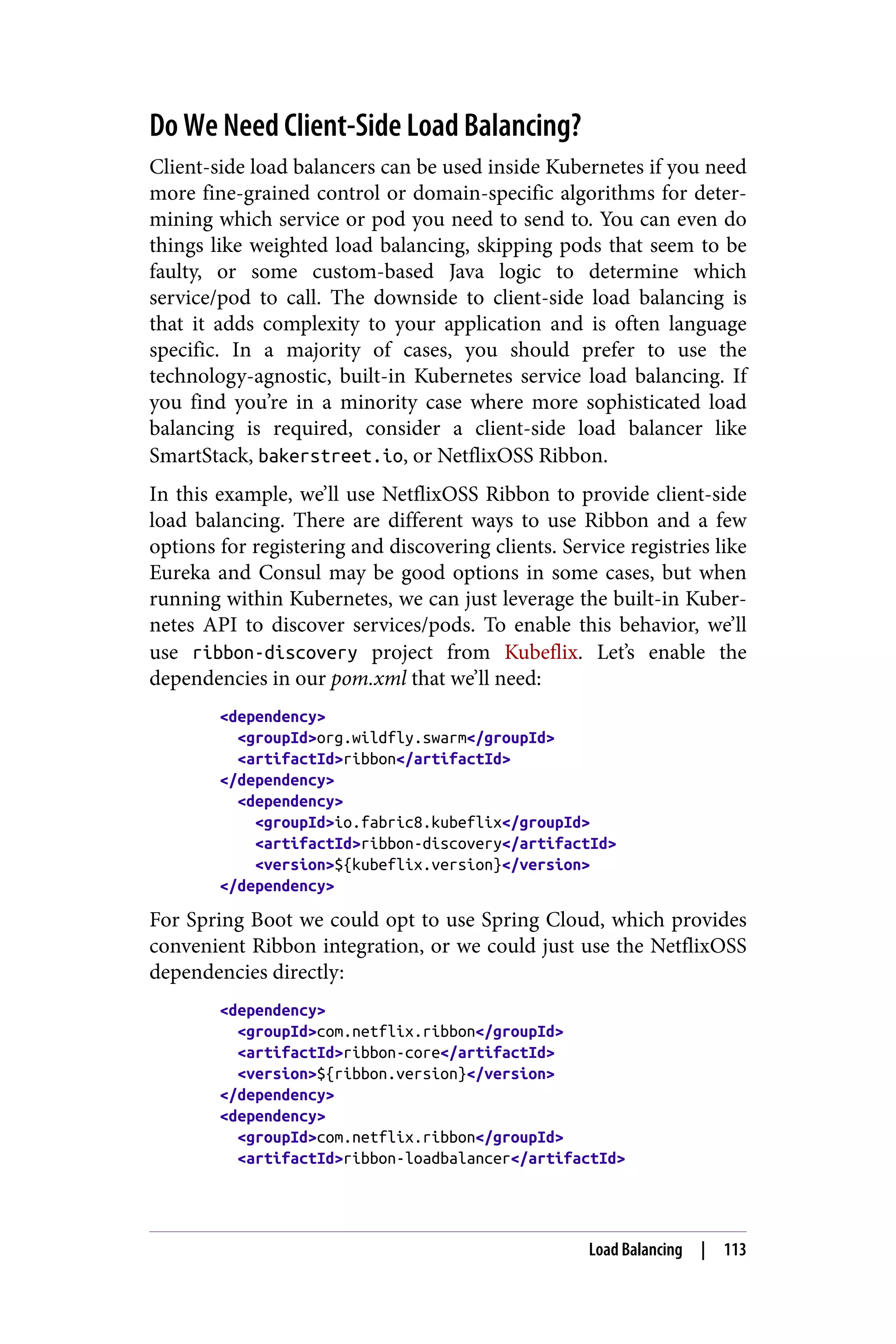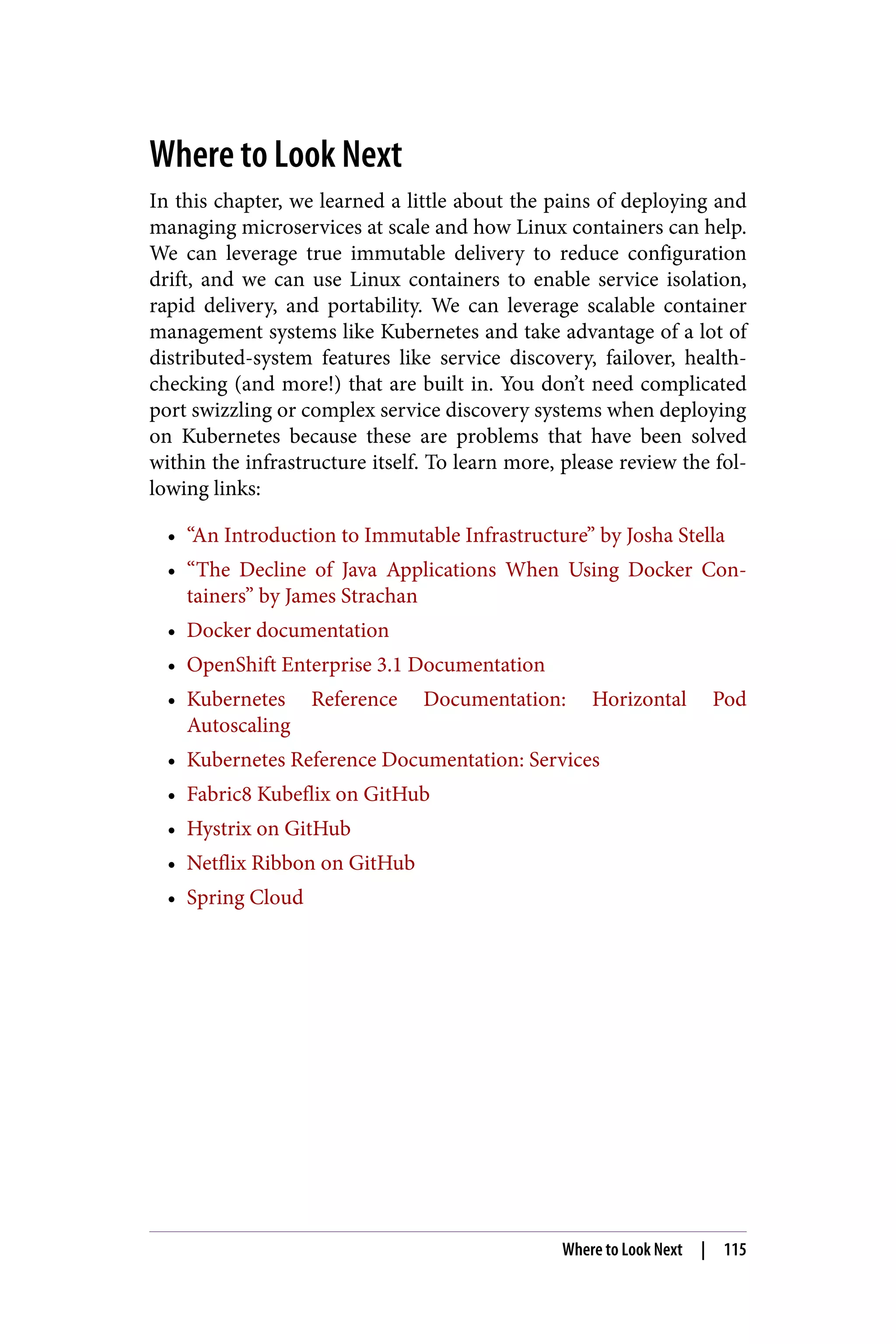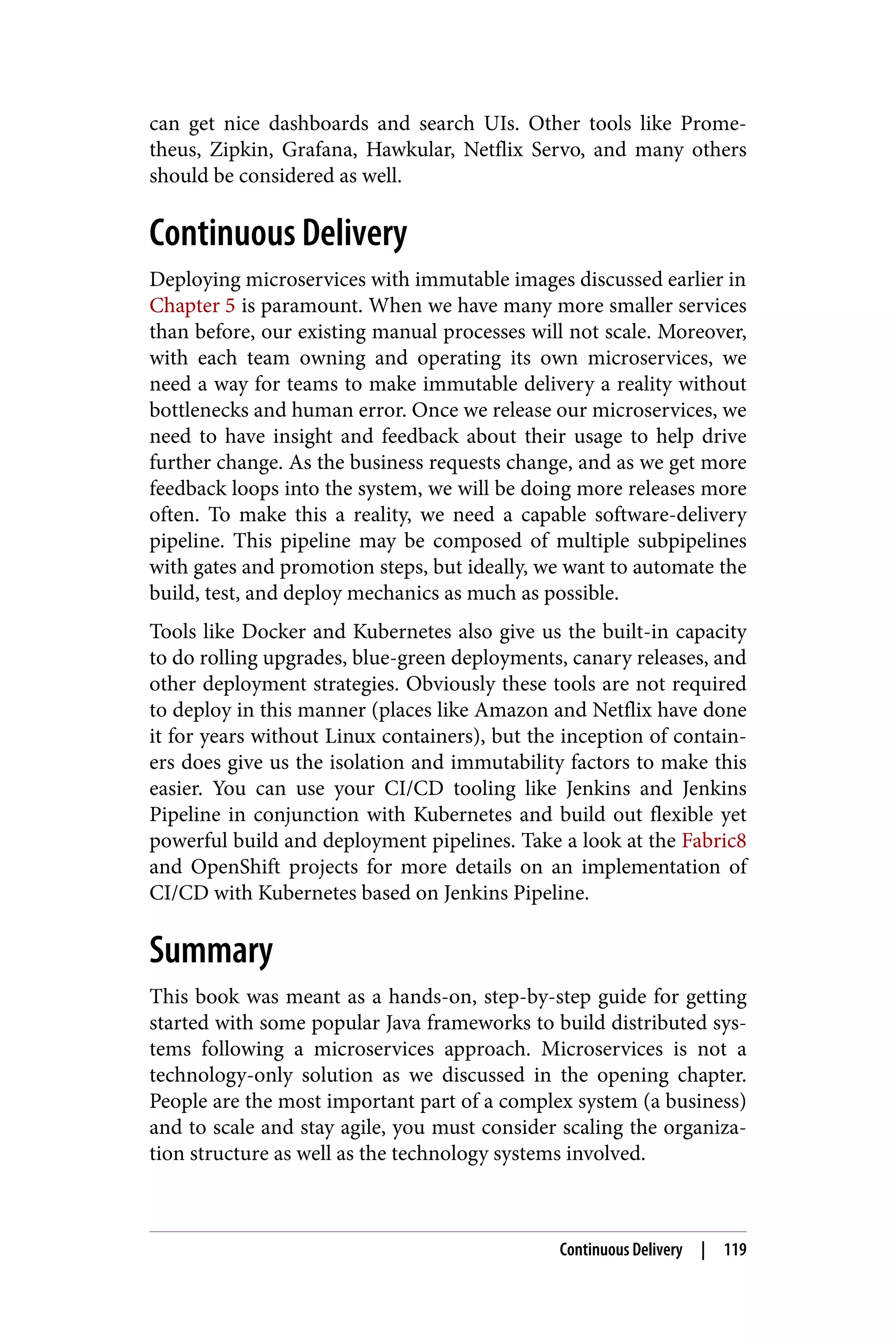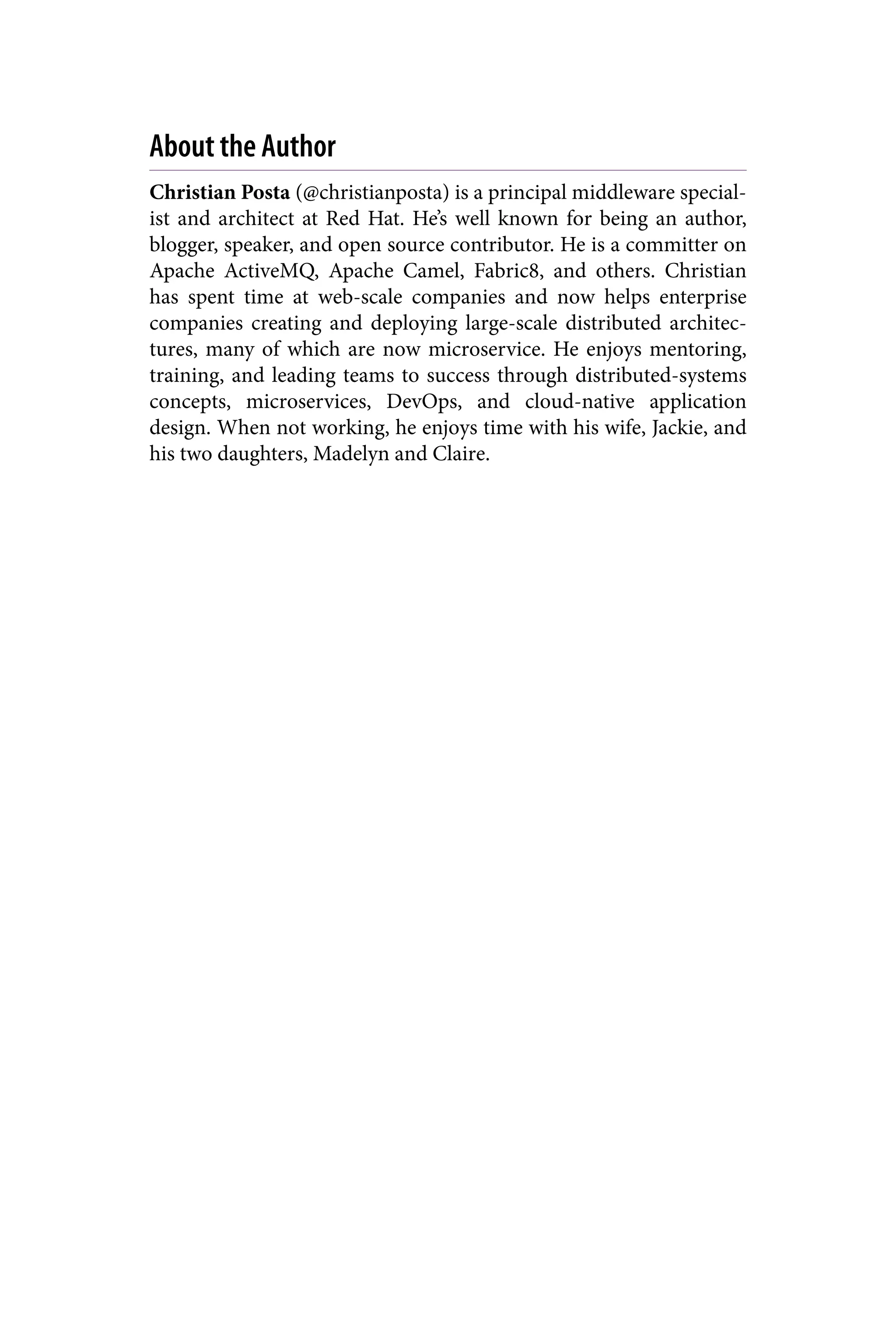This document provides an introduction to microservices for Java developers. It discusses the benefits of a microservices architecture, including allowing teams to focus on providing individual services and making changes independently. It also covers some of the challenges of building distributed systems using a microservices approach. Finally, it provides an overview of some Java frameworks that can be used to implement microservices, including Spring Boot, Dropwizard, and WildFly Swarm, and technologies like Docker and Kubernetes that can be used to deploy microservices at scale.

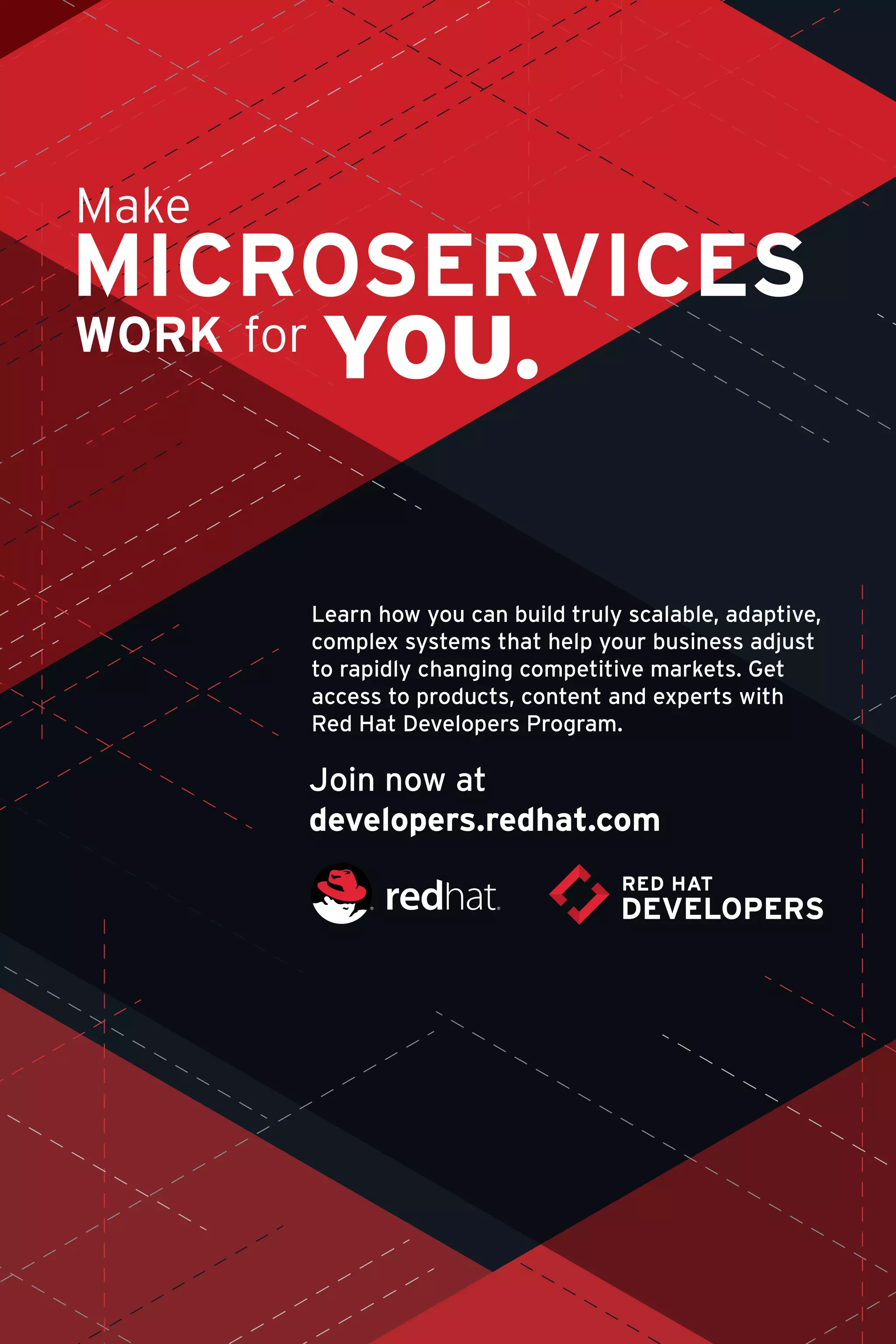

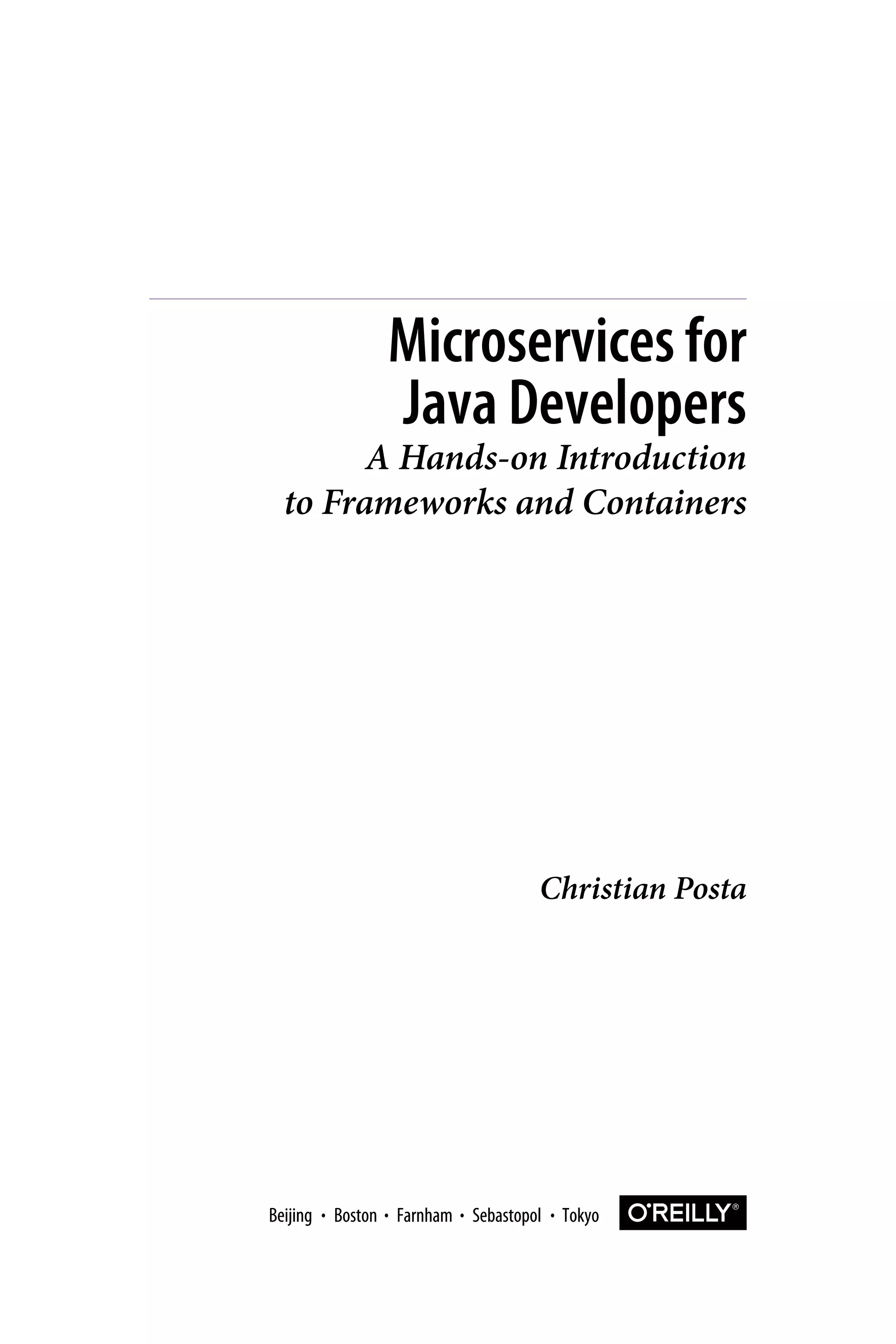
![978-1-491-96308-1
[LSI]
Microservices for Java Developers
by Christian Posta
Copyright © 2016 Red Hat, Inc. All rights reserved.
Printed in the United States of America.
Published by O’Reilly Media, Inc., 1005 Gravenstein Highway North, Sebastopol, CA
95472.
O’Reilly books may be purchased for educational, business, or sales promotional use.
Online editions are also available for most titles (http://safaribooksonline.com). For
more information, contact our corporate/institutional sales department:
800-998-9938 or corporate@oreilly.com.
Editors: Nan Barber and Susan Conant
Production Editor: Melanie Yarbrough
Copyeditor: Amanda Kersey
Proofreader: Susan Moritz
Interior Designer: David Futato
Cover Designer: Randy Comer
Illustrator: Rebecca Demarest
June 2016: First Edition
Revision History for the First Edition
2016-05-25: First Release
The O’Reilly logo is a registered trademark of O’Reilly Media, Inc. Microservices for
Java Developers, the cover image, and related trade dress are trademarks of O’Reilly
Media, Inc.
While the publisher and the author have used good faith efforts to ensure that the
information and instructions contained in this work are accurate, the publisher and
the author disclaim all responsibility for errors or omissions, including without limi‐
tation responsibility for damages resulting from the use of or reliance on this work.
Use of the information and instructions contained in this work is at your own risk. If
any code samples or other technology this work contains or describes is subject to
open source licenses or the intellectual property rights of others, it is your responsi‐
bility to ensure that your use thereof complies with such licenses and/or rights.](https://image.slidesharecdn.com/microservicesforjavadevelopers-190704170017/75/Microservices-for-Java-Developers-5-2048.jpg)
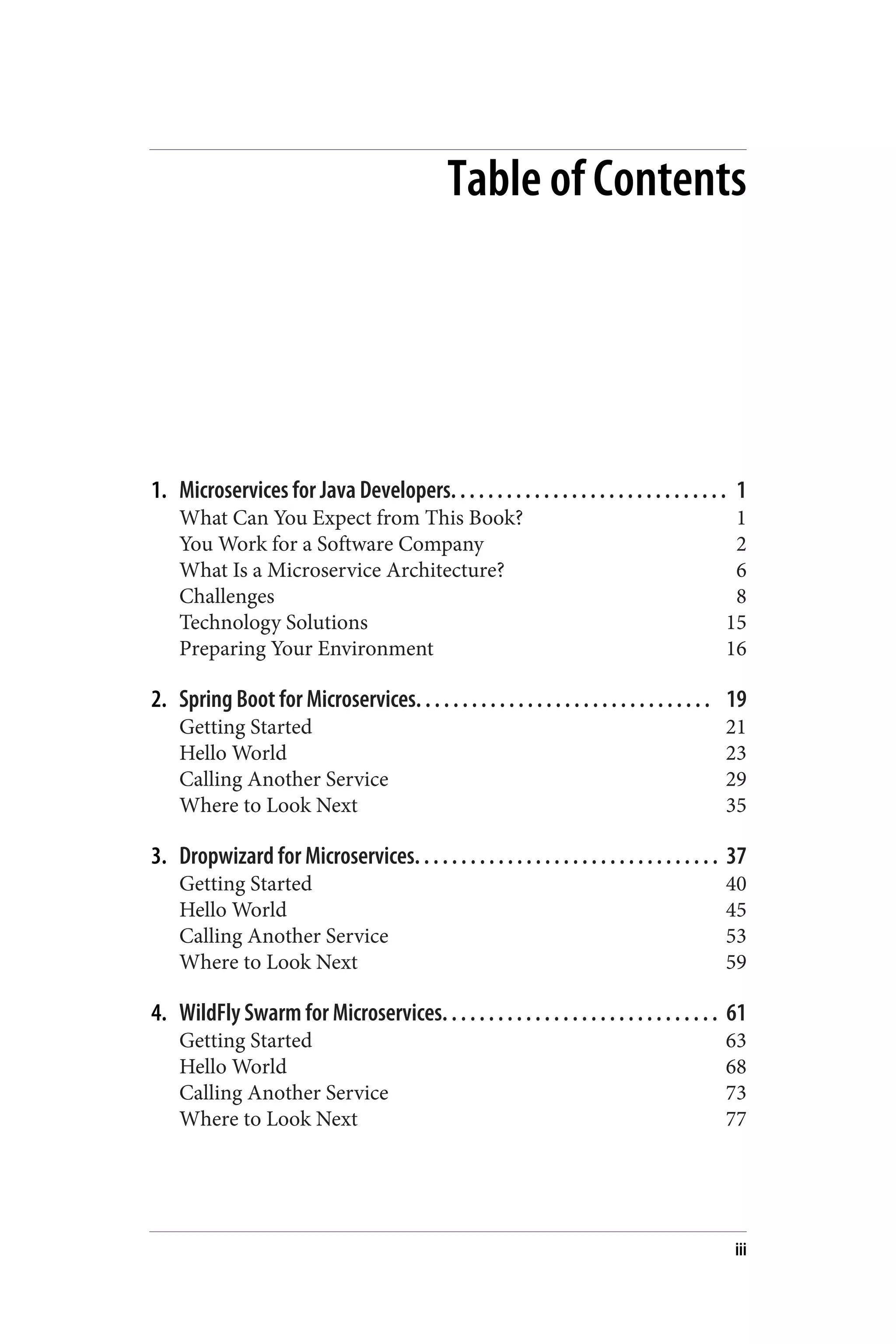
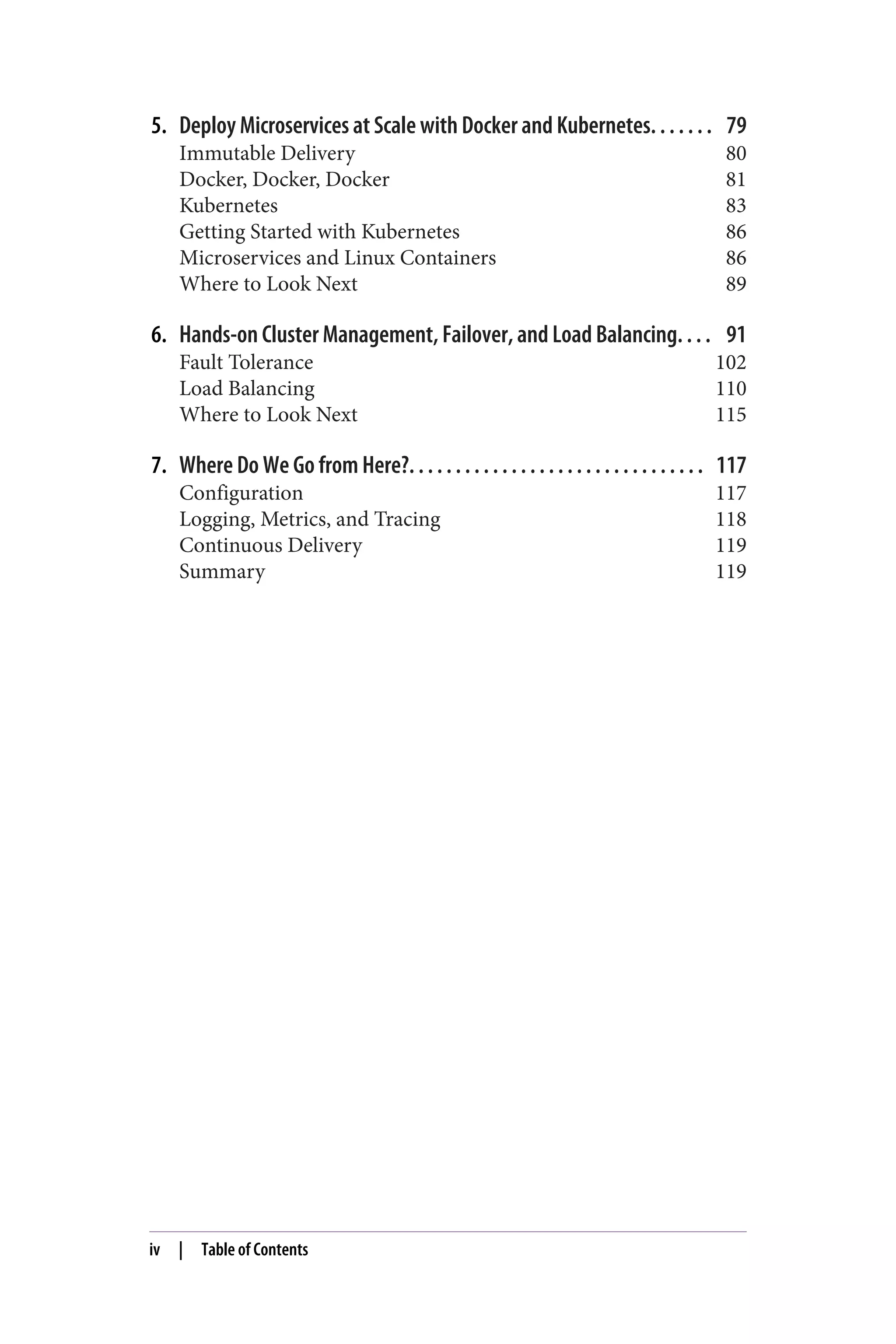
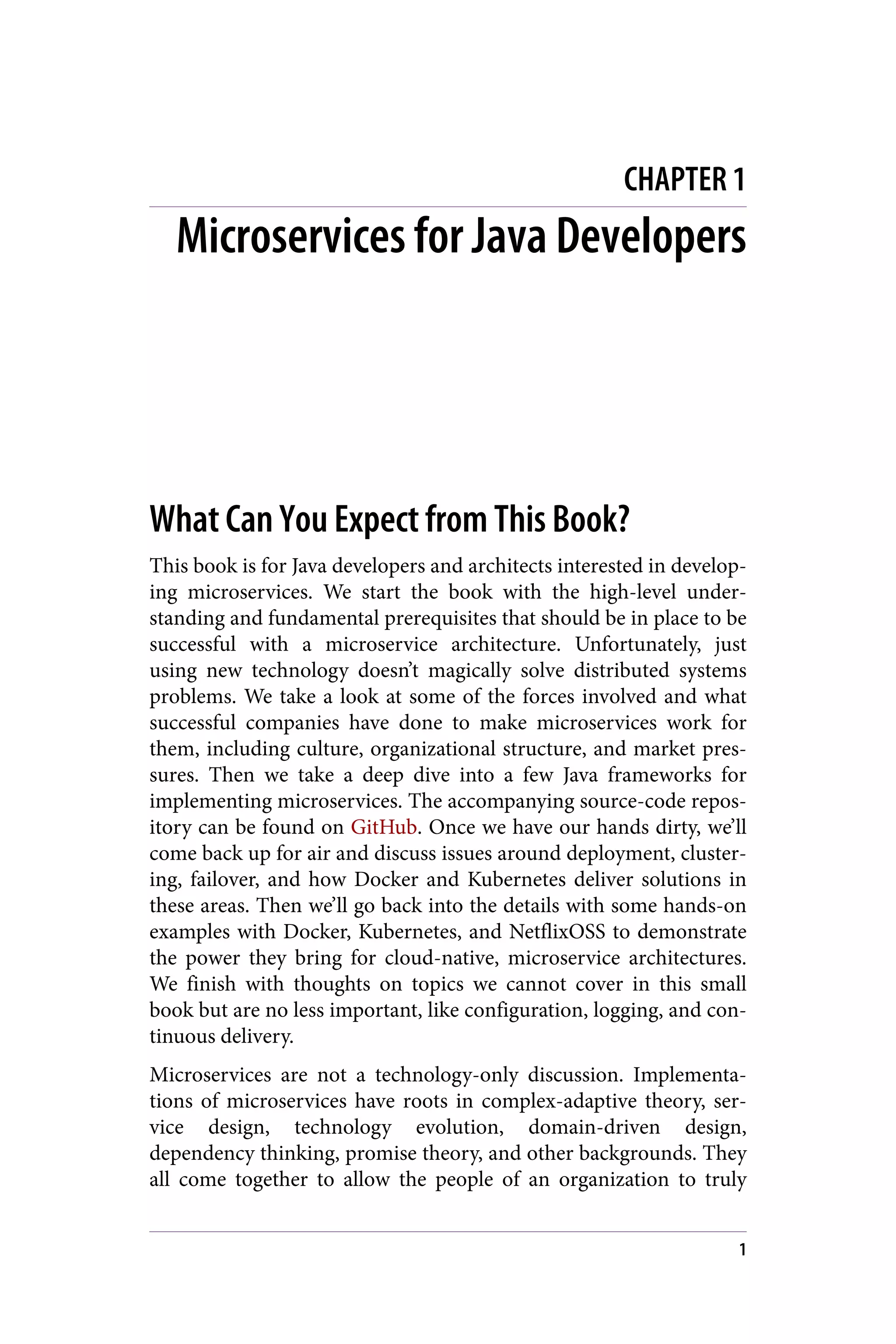


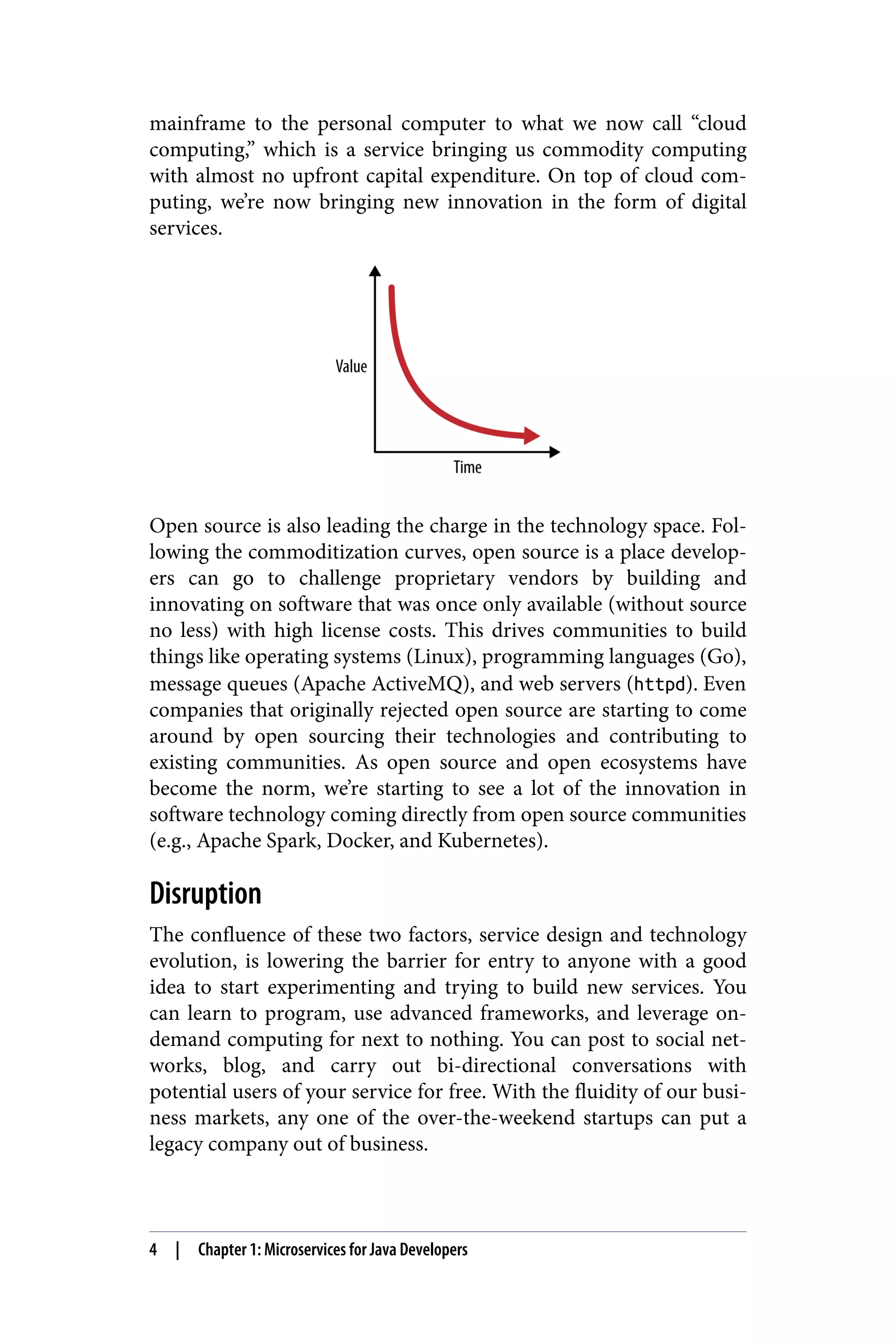


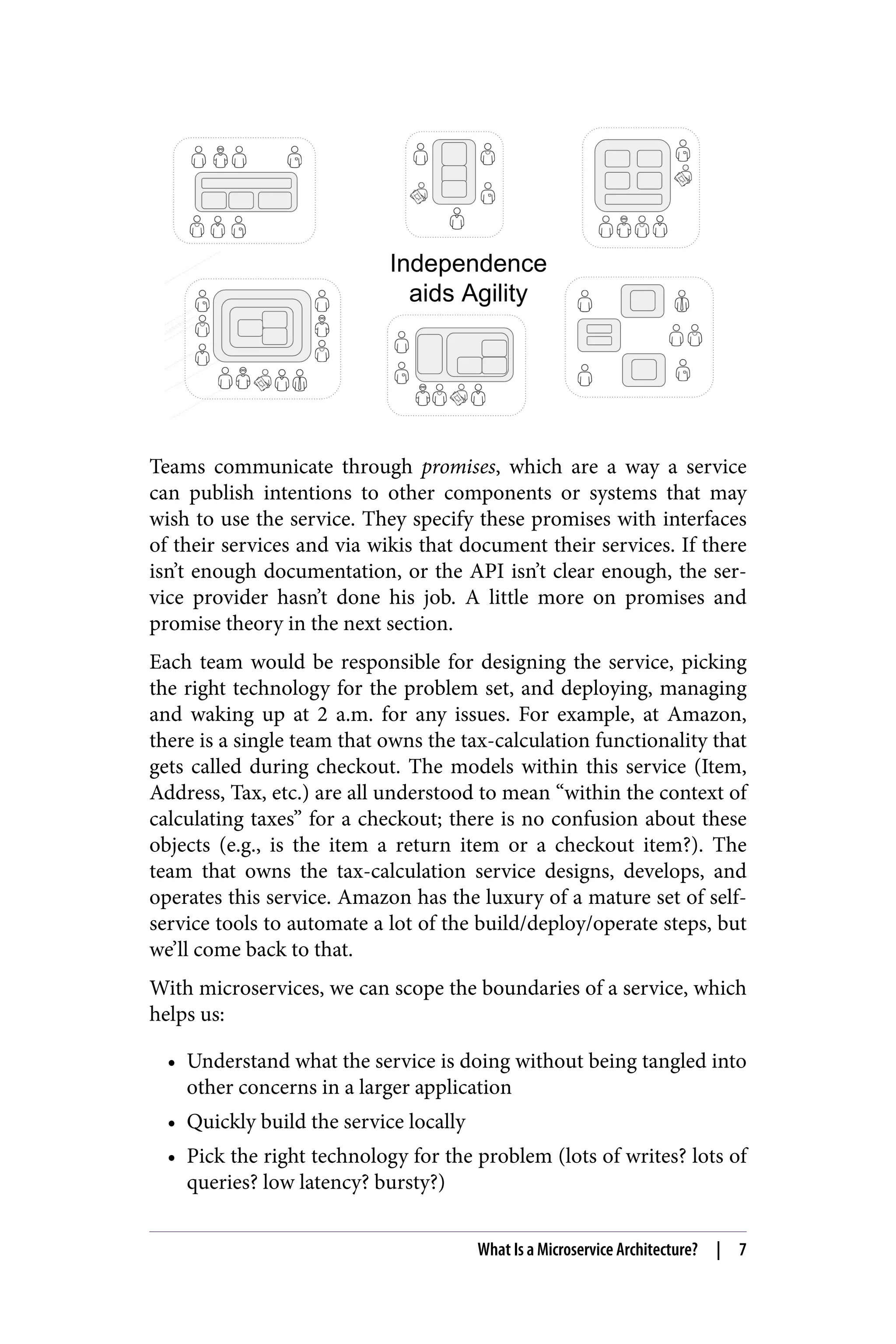
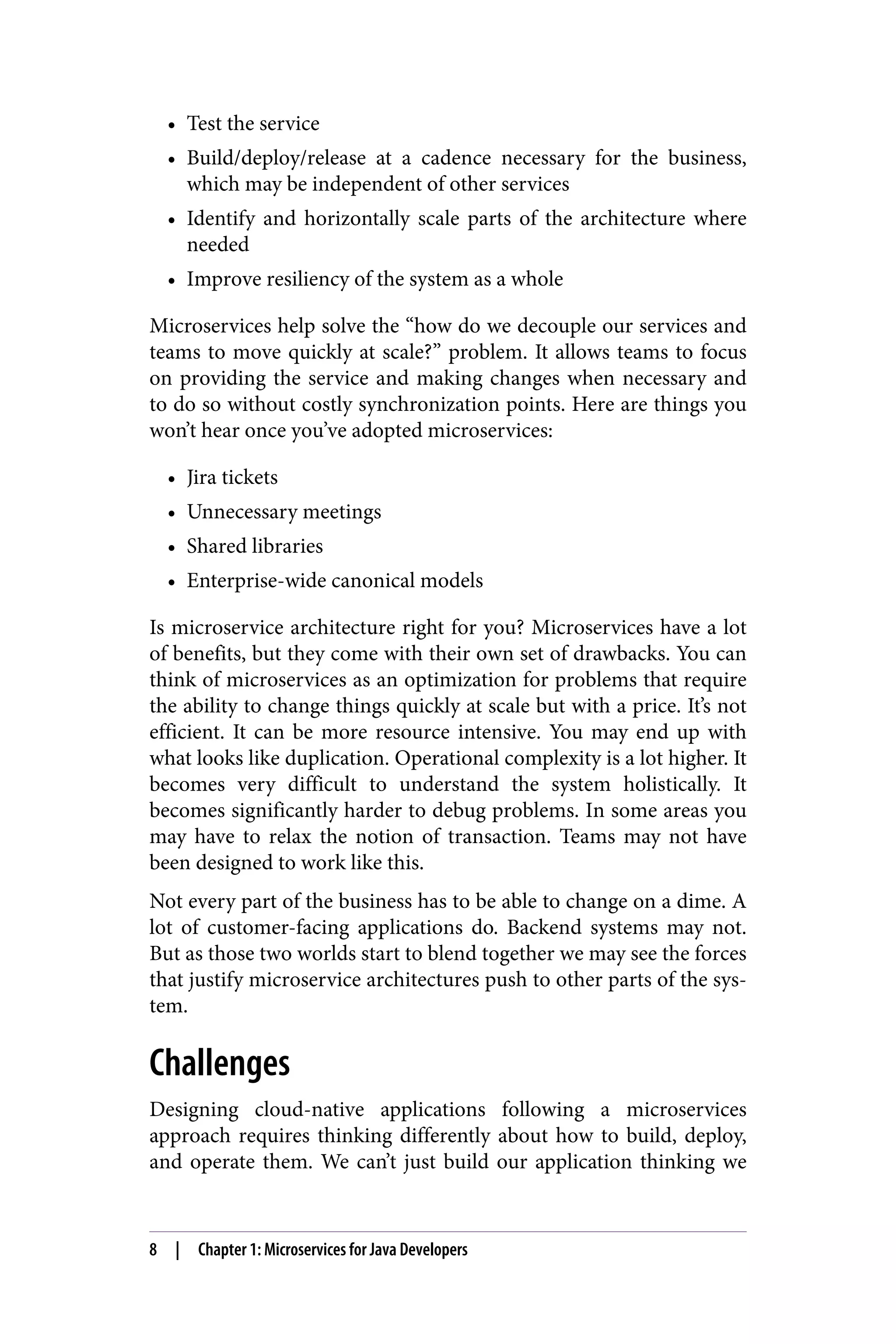
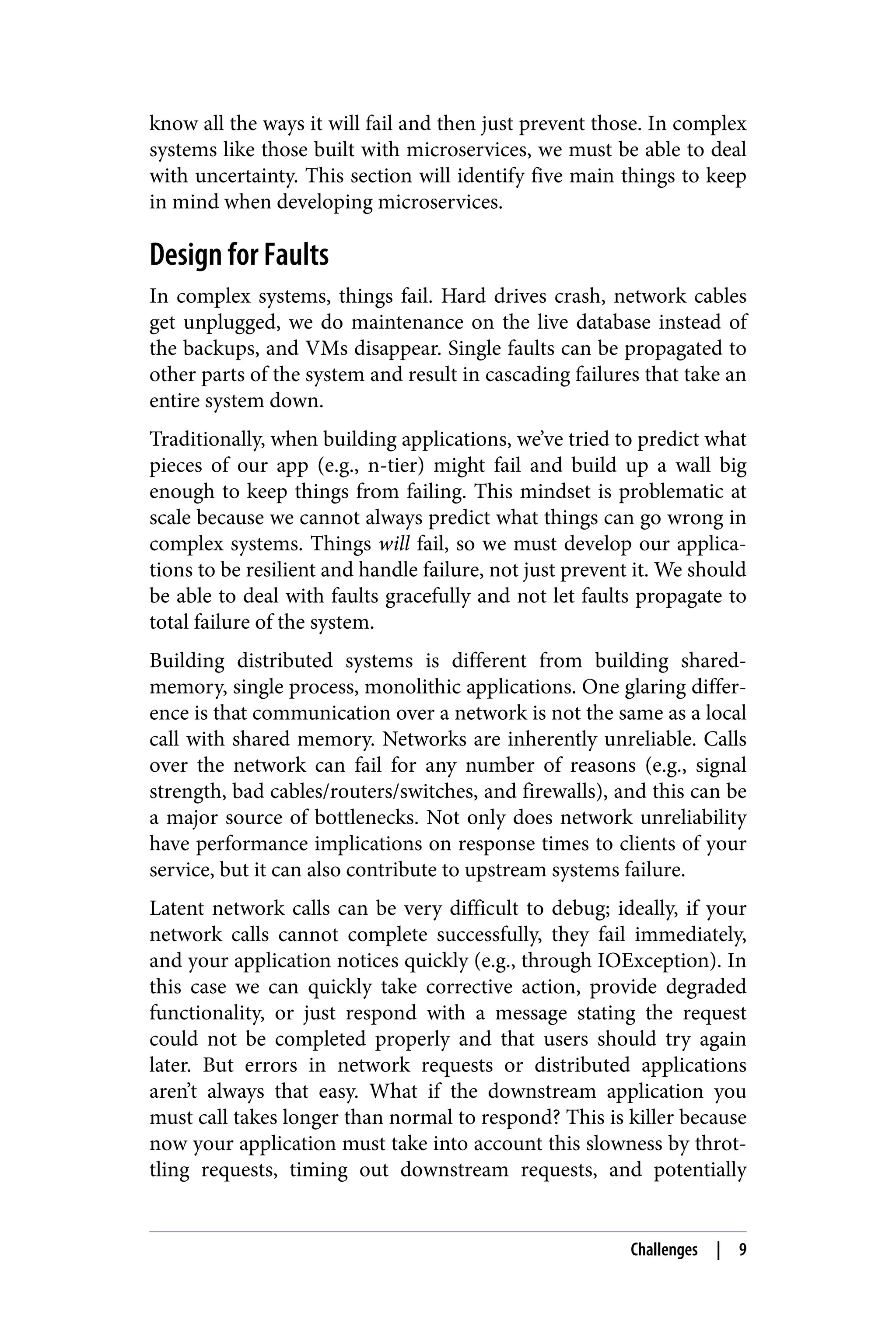
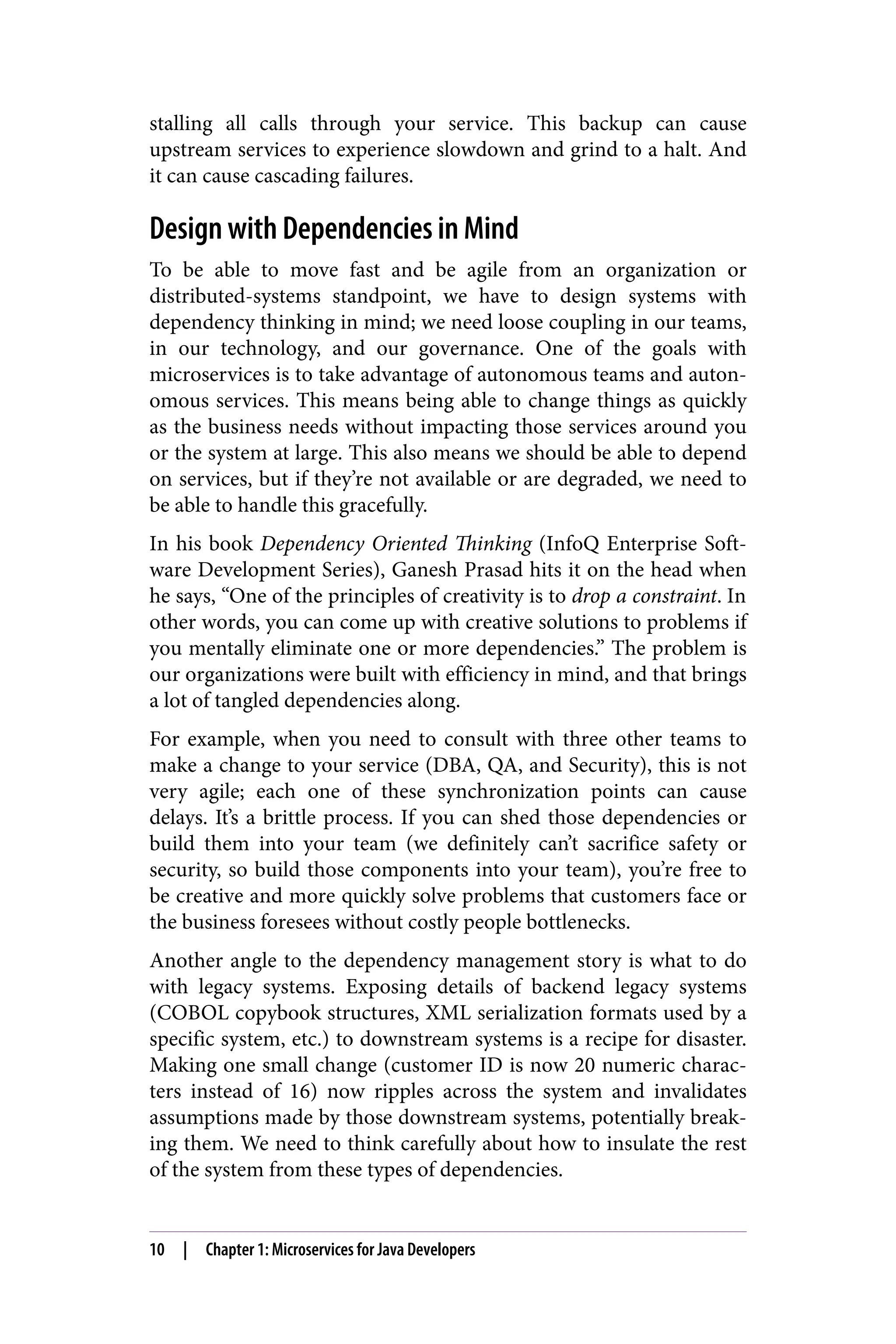
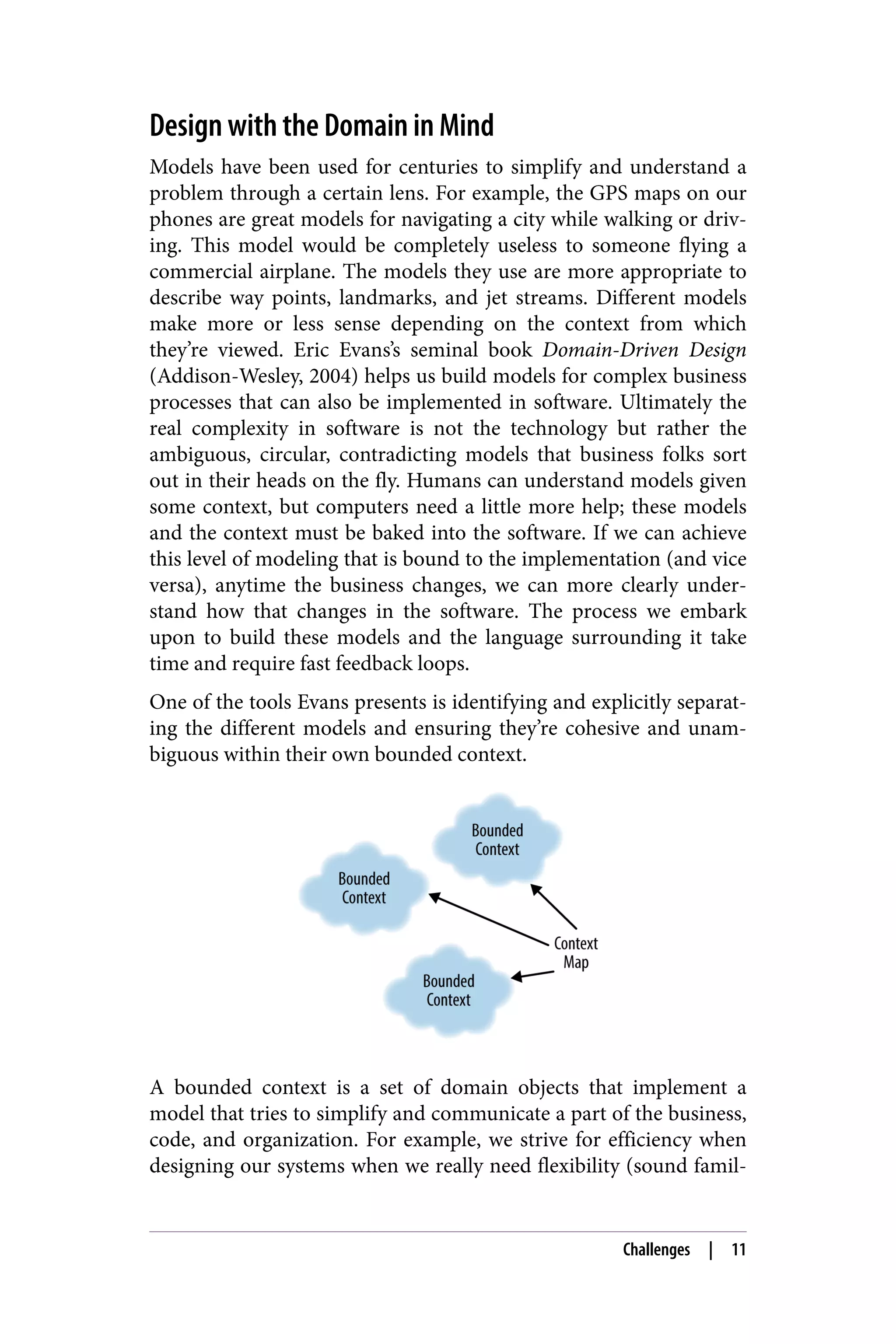
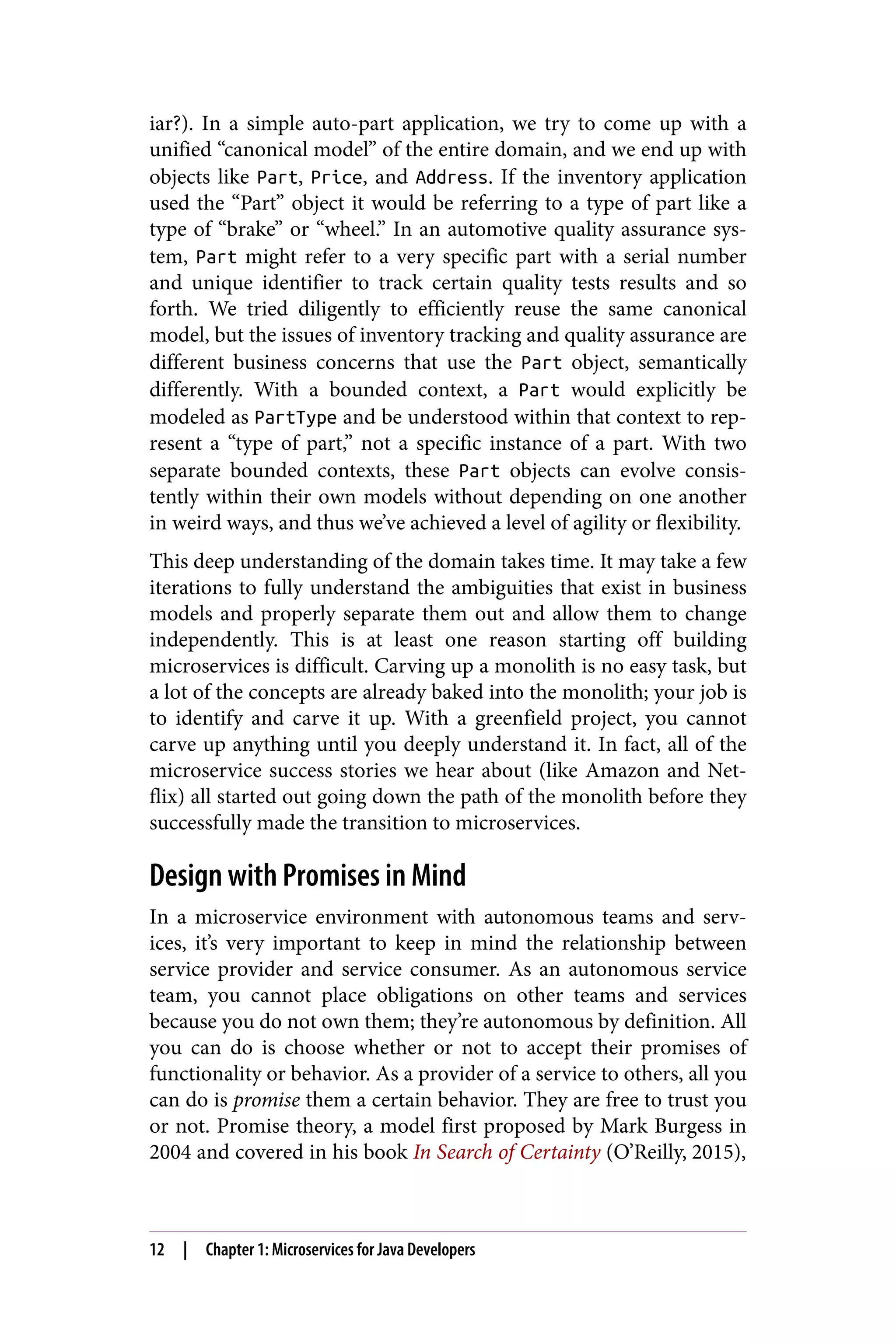
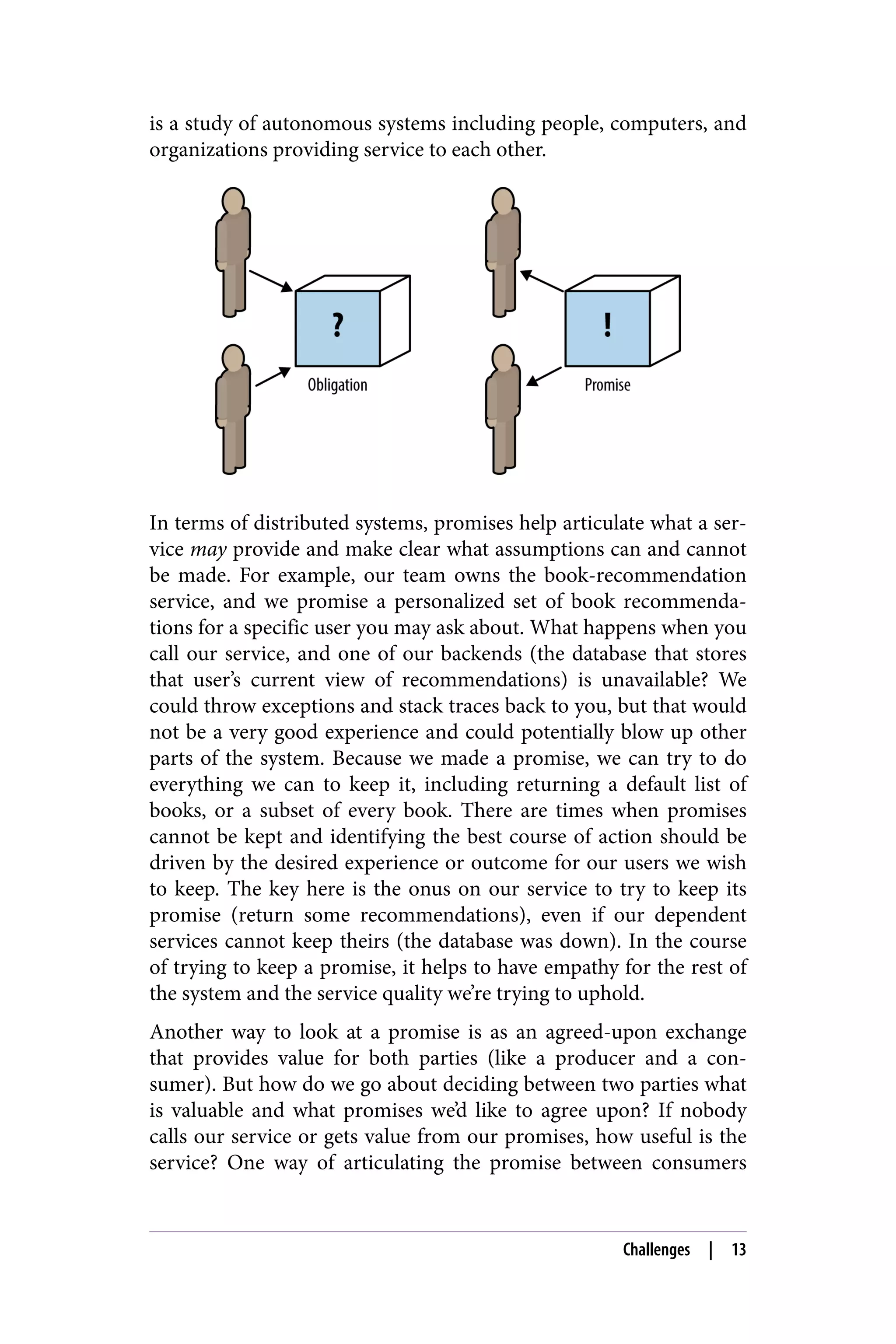

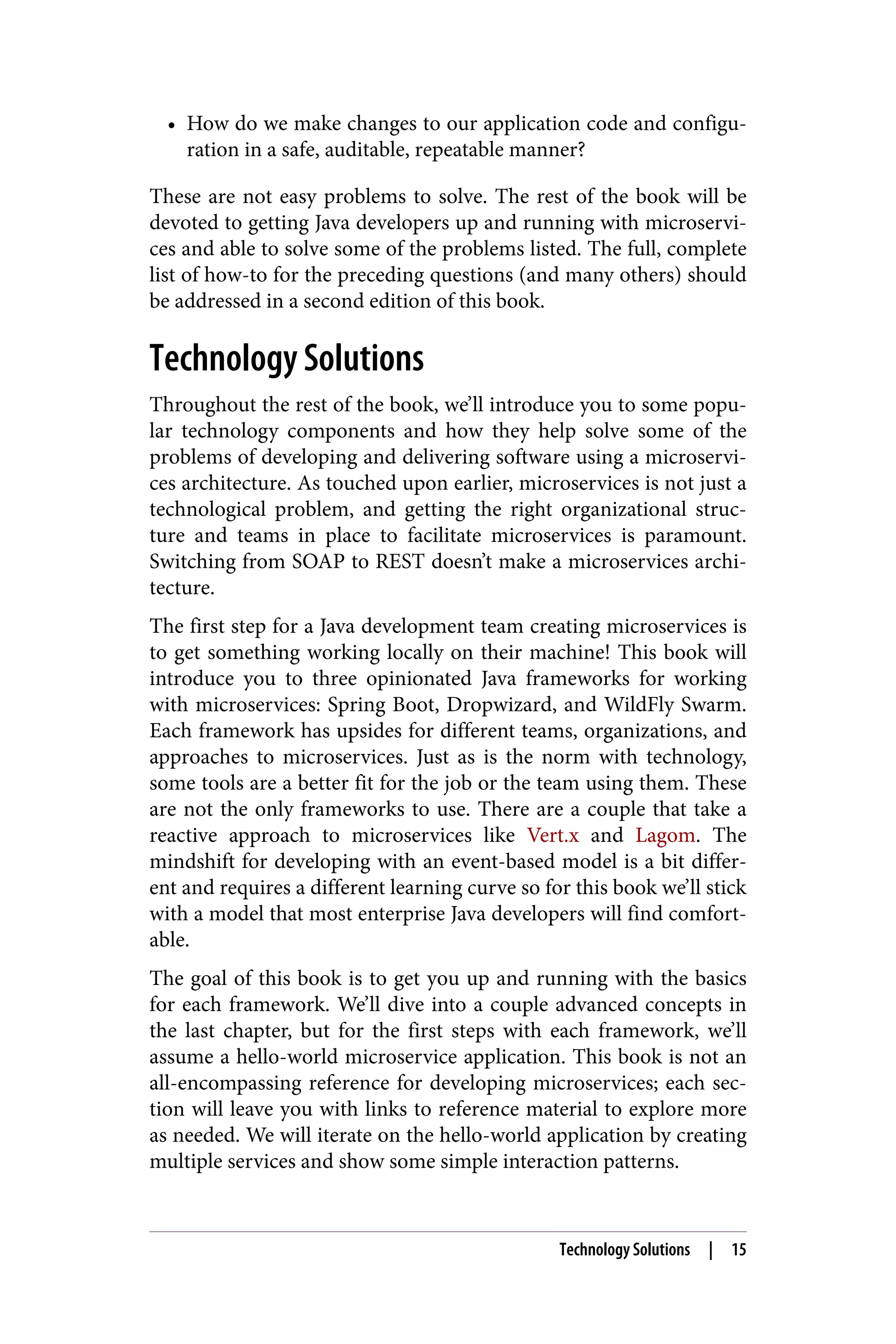
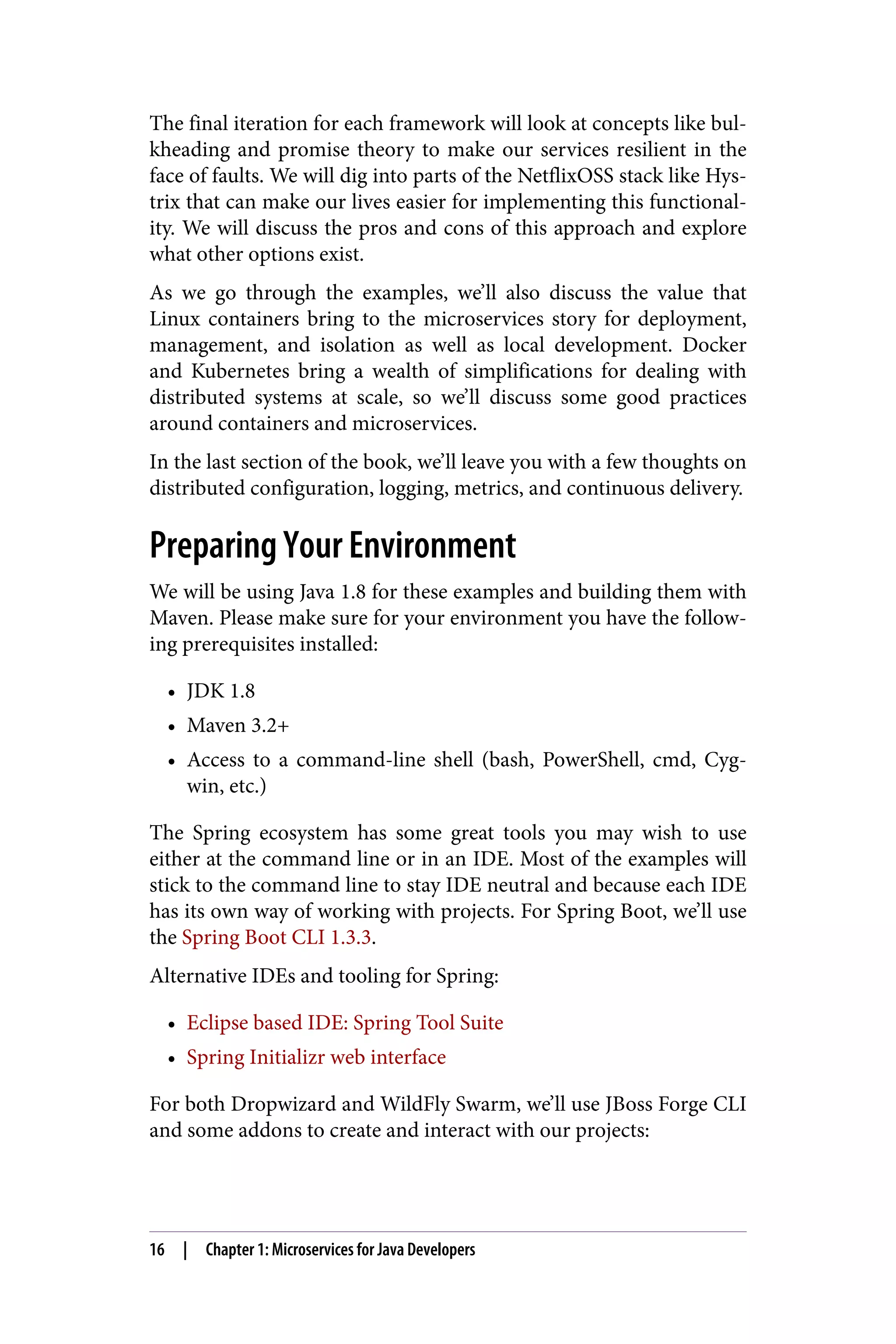
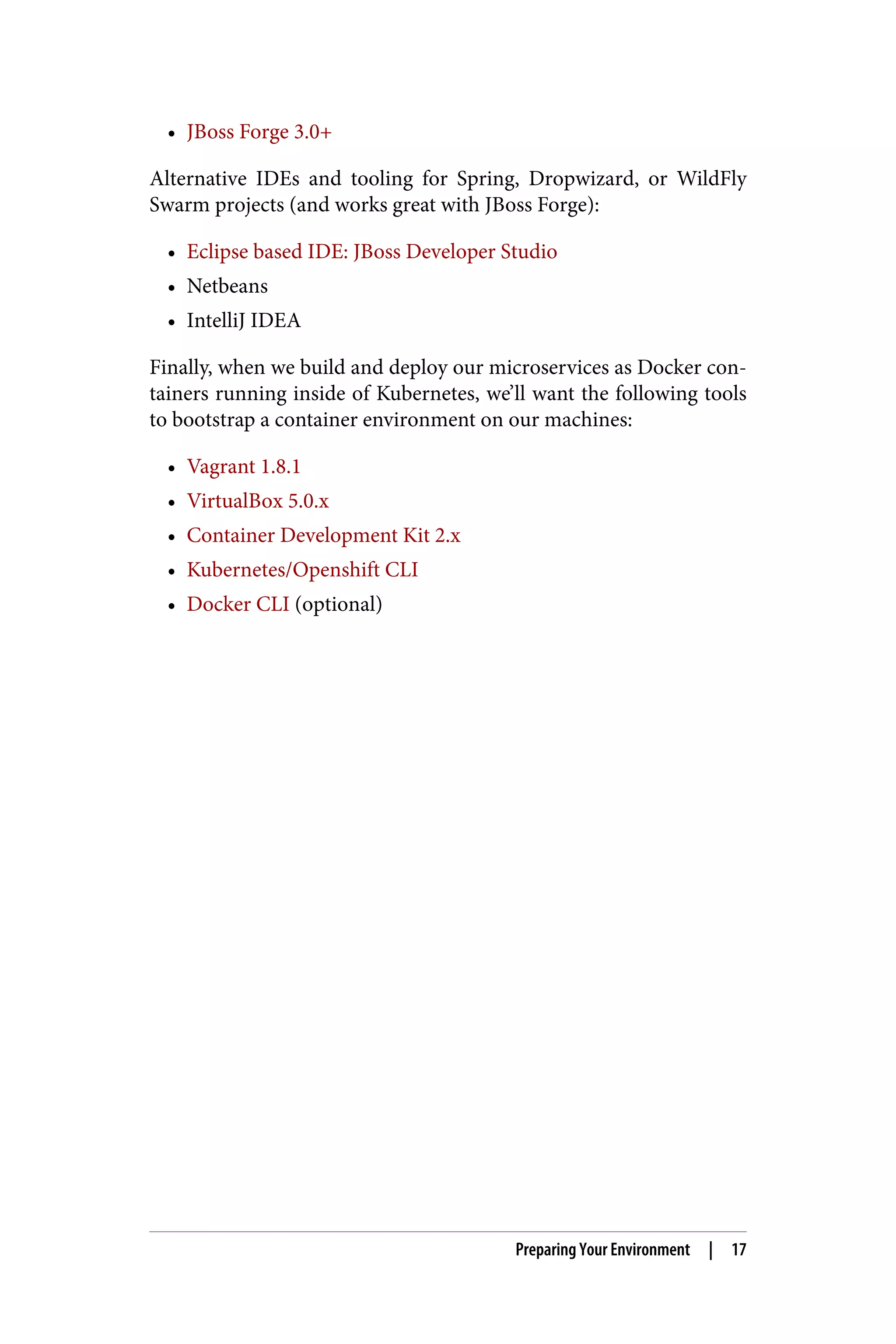

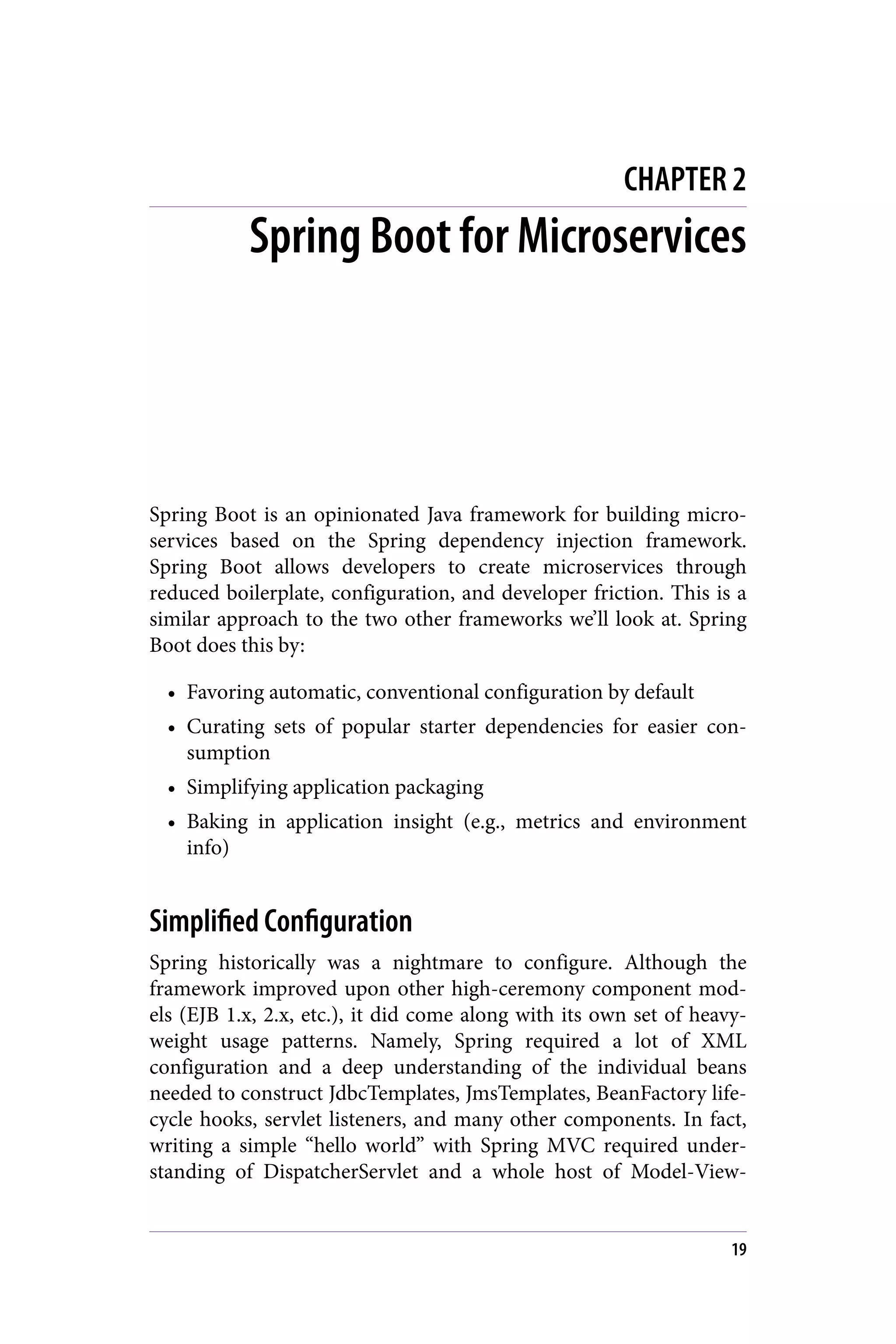
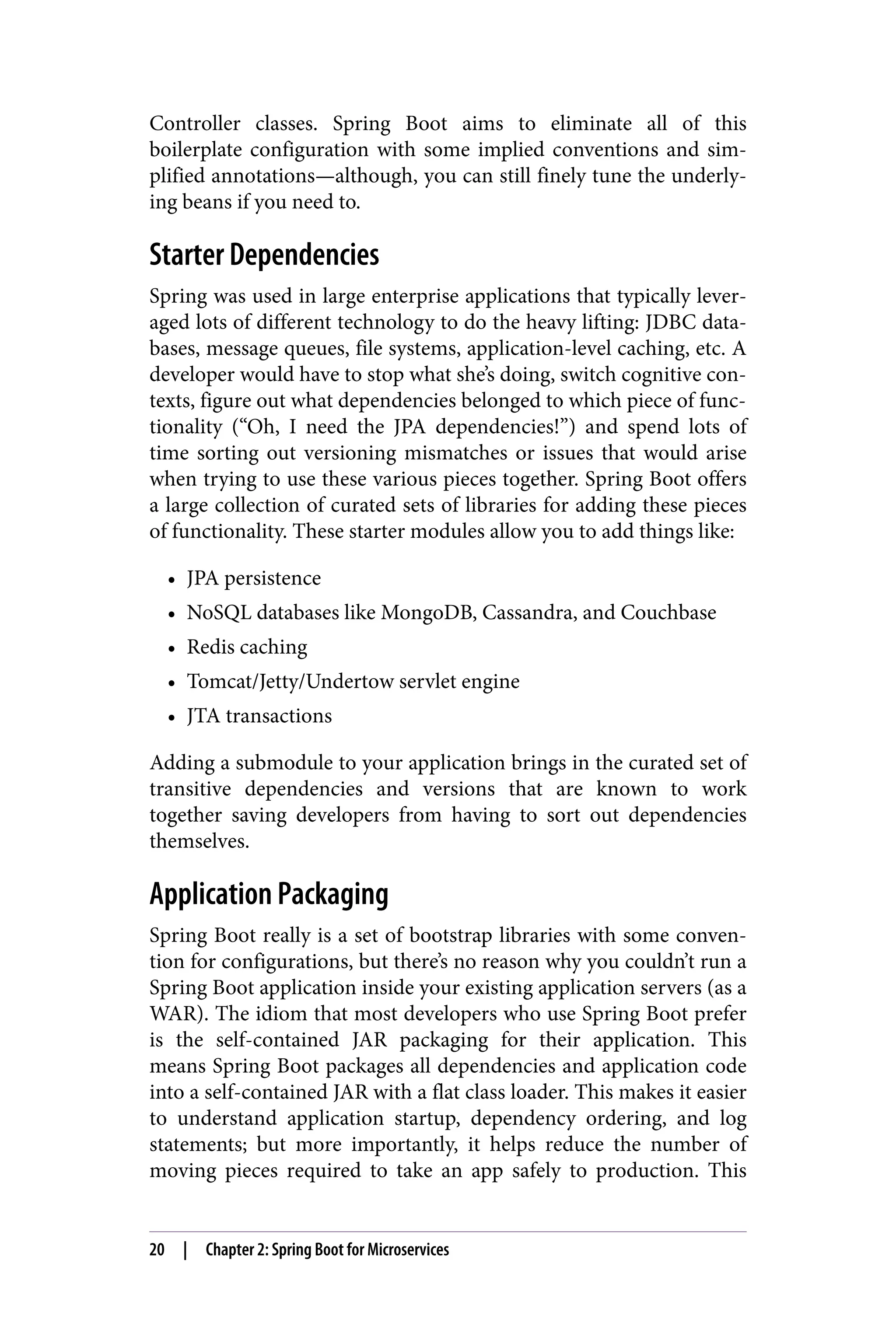

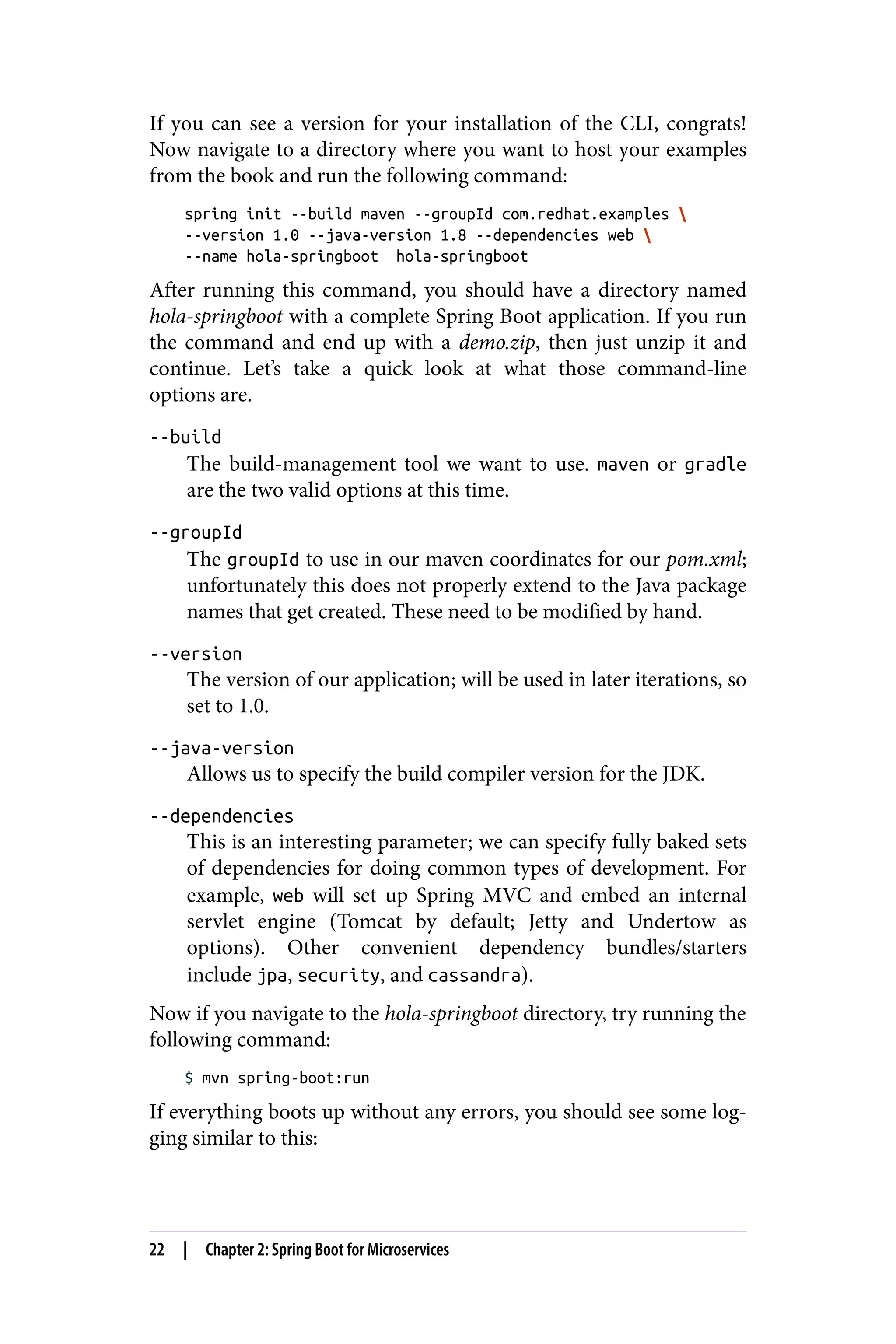
![2016-03-25 10:57:08.920 [main] AnnotationMBeanExporter
: Registering beans for JMX exposure on startup
2016-03-25 10:57:08.982 [main] TomcatEmbeddedServletContainer
: Tomcat started on port(s): 8080 (http)
2016-03-25 10:57:08.987 [main] HolaSpringbootApplication
: Started HolaSpringbootApplication in 1.0 seconds
(JVM running for 4.7)
Congrats! You have quickly gotten a Spring Boot application up and
running! You can even navigate to http://localhost:8080 in your
browser and should see the following output:
This default error page is expected since our application doesn’t do
anything yet! Let’s move on to the next section to add a REST end‐
point to put together a hello-world use case!
Hello World
Now that we have a Spring Boot application that can run, let’s add
some simple functionality. We want to expose an HTTP/REST end‐
point at /api/hola that will return “Hola Spring Boot from X” where
X is the IP address where the service is running. To do this, navigate
to src/main/java/com/example. This location should have been cre‐
ated for you if you followed the preceding steps; remember, the
groupId we passed to the spring init program did not apply
groupId to the Java package hierarchy, and we’ve left it as it is which
should be “com.example”. Then create a new Java class called HolaR
estController, as shown in Example 2-1. We’ll add a method
named hola() that returns a string along with the IP address of
where the service is running. You’ll see in Chapter 5, in our load bal‐
ancing and service discovery sections, how the host IPs can be used
to demonstrate proper failover, loadbalancing, etc.
Hello World | 23](https://image.slidesharecdn.com/microservicesforjavadevelopers-190704170017/75/Microservices-for-Java-Developers-30-2048.jpg)
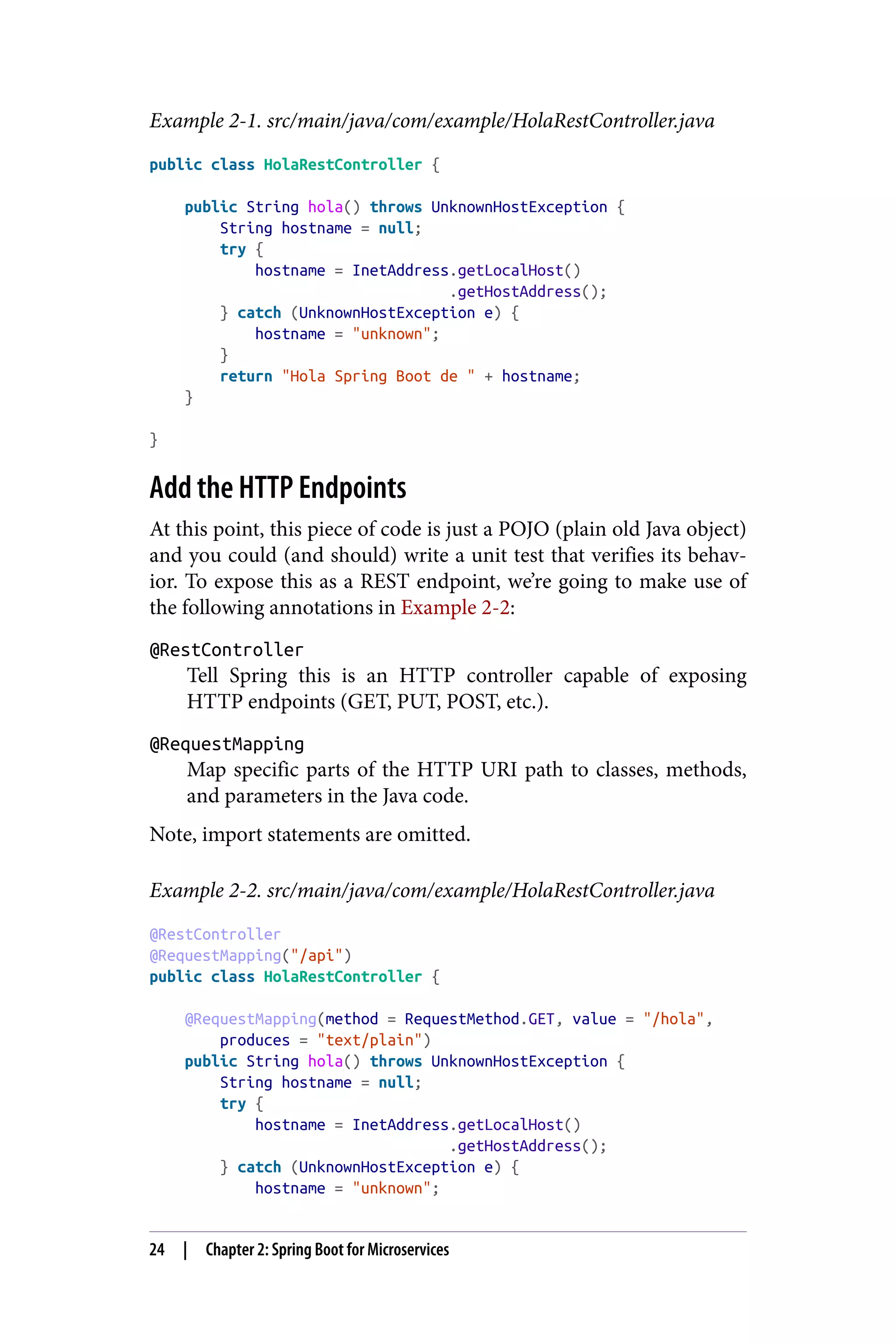

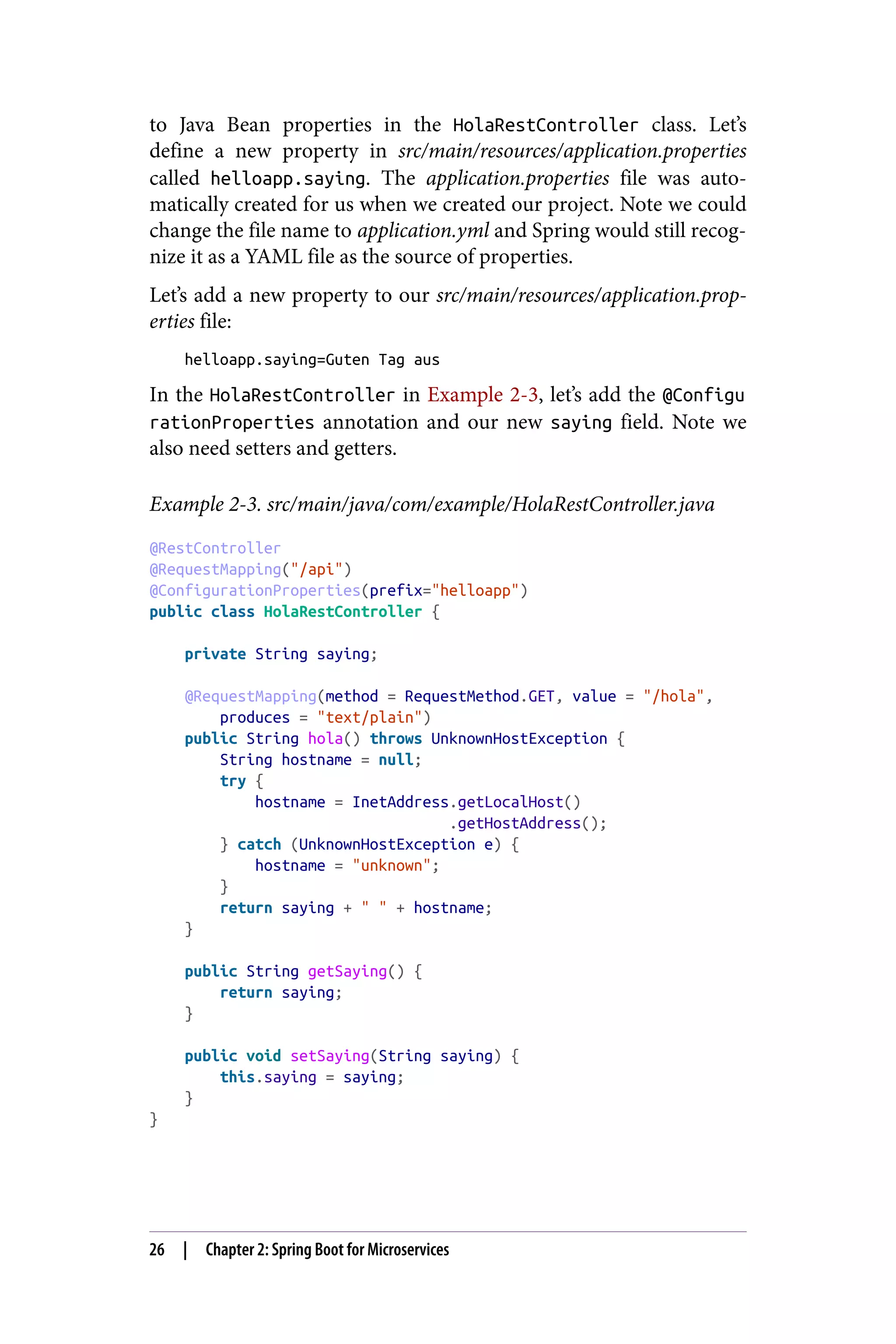
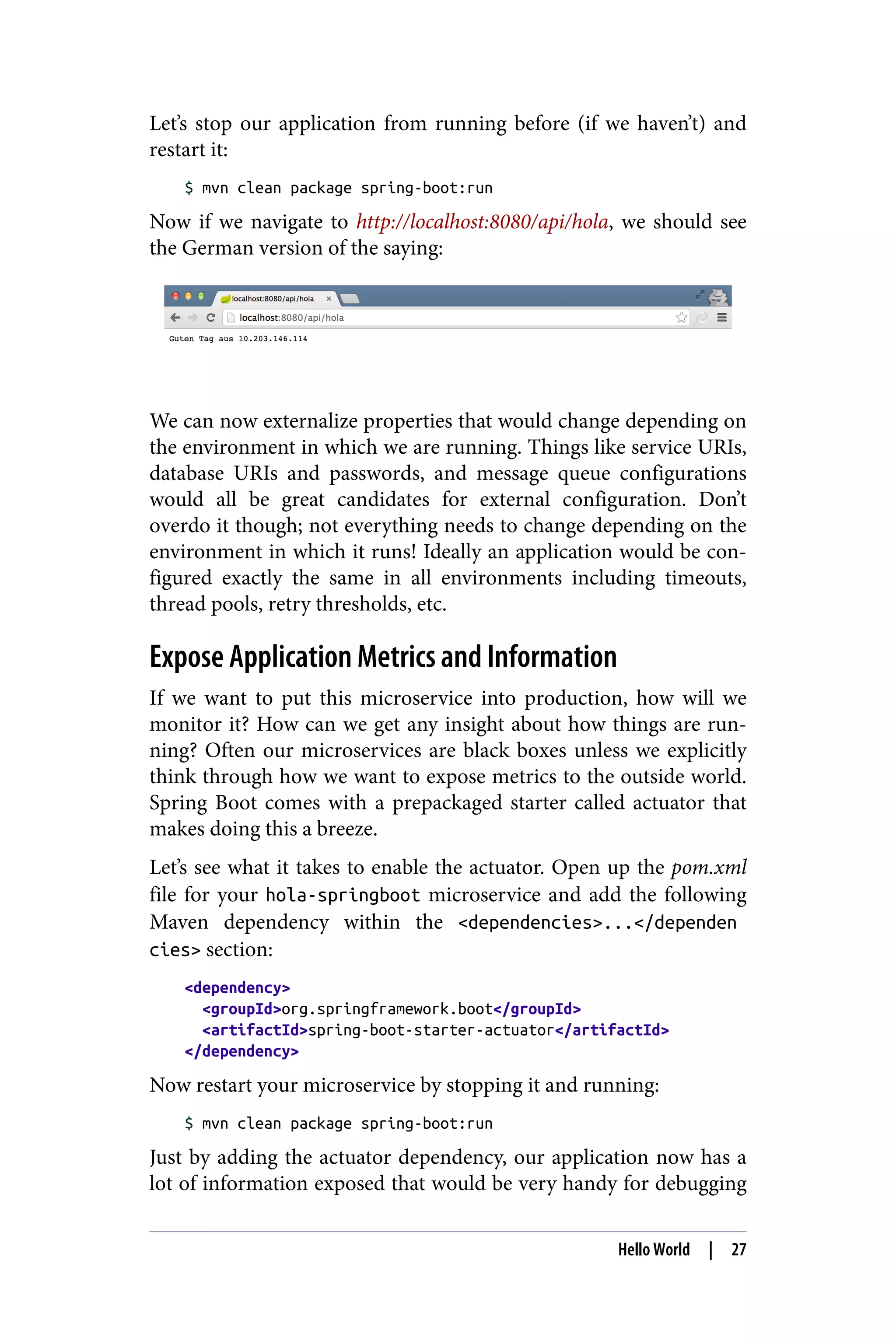
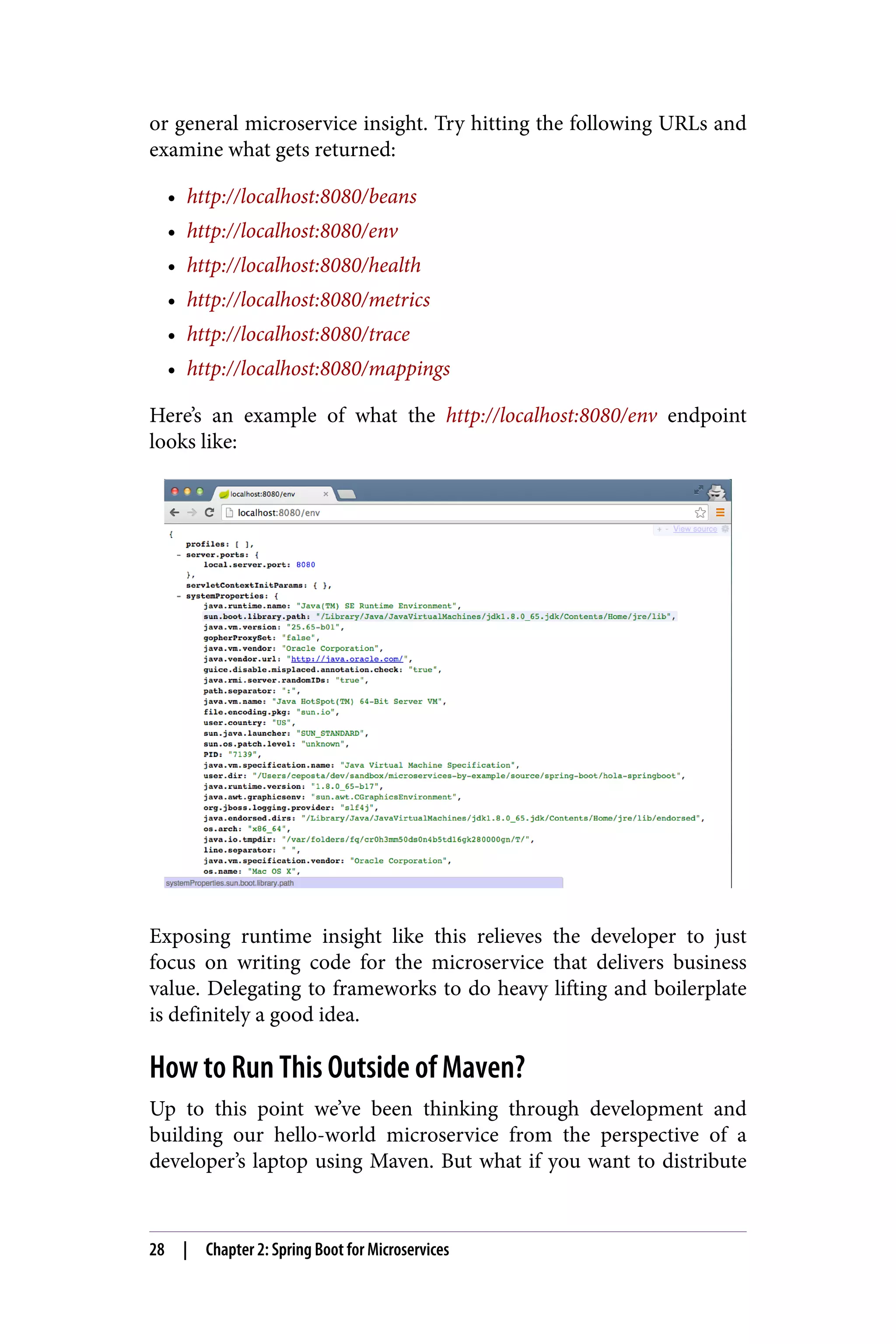

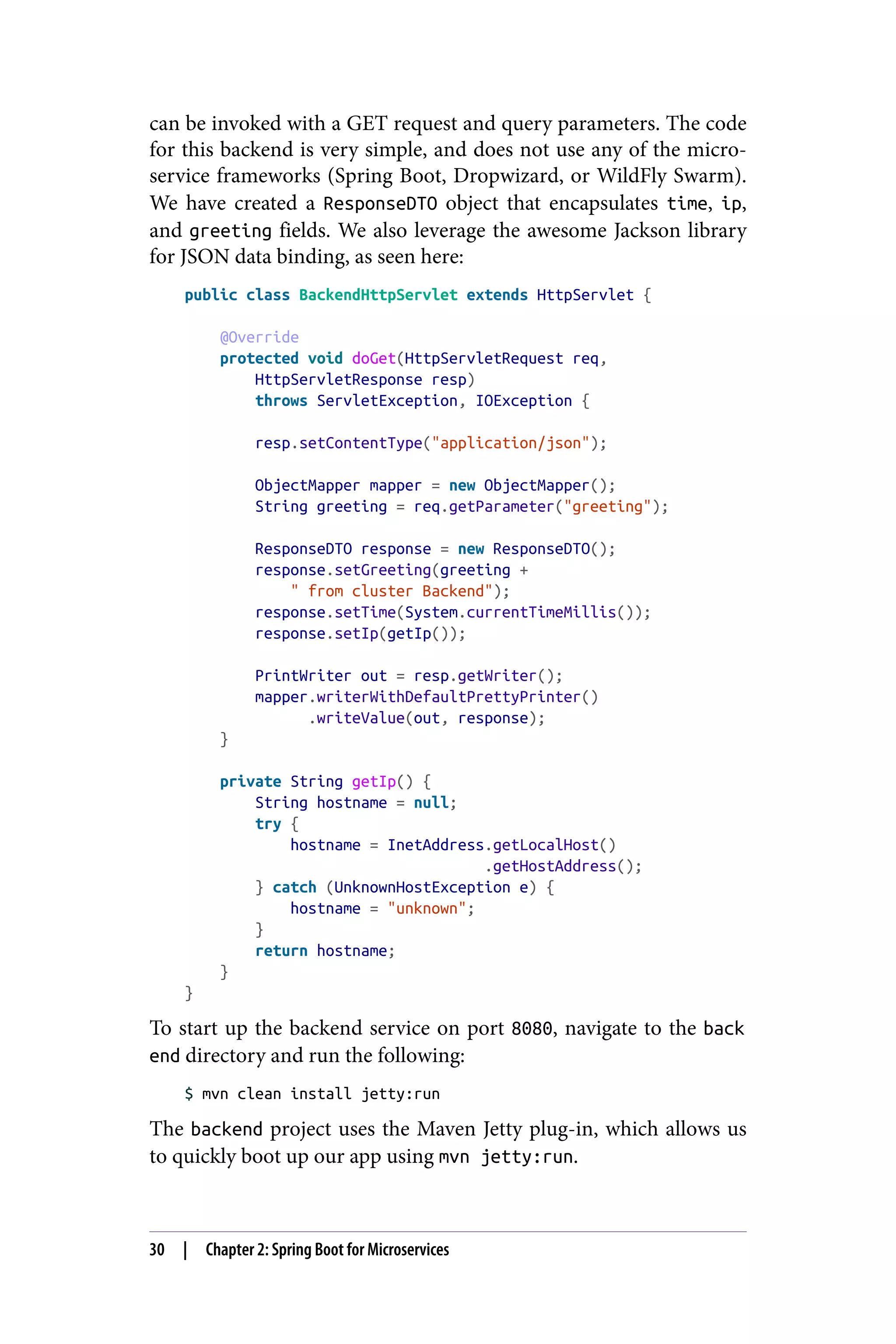
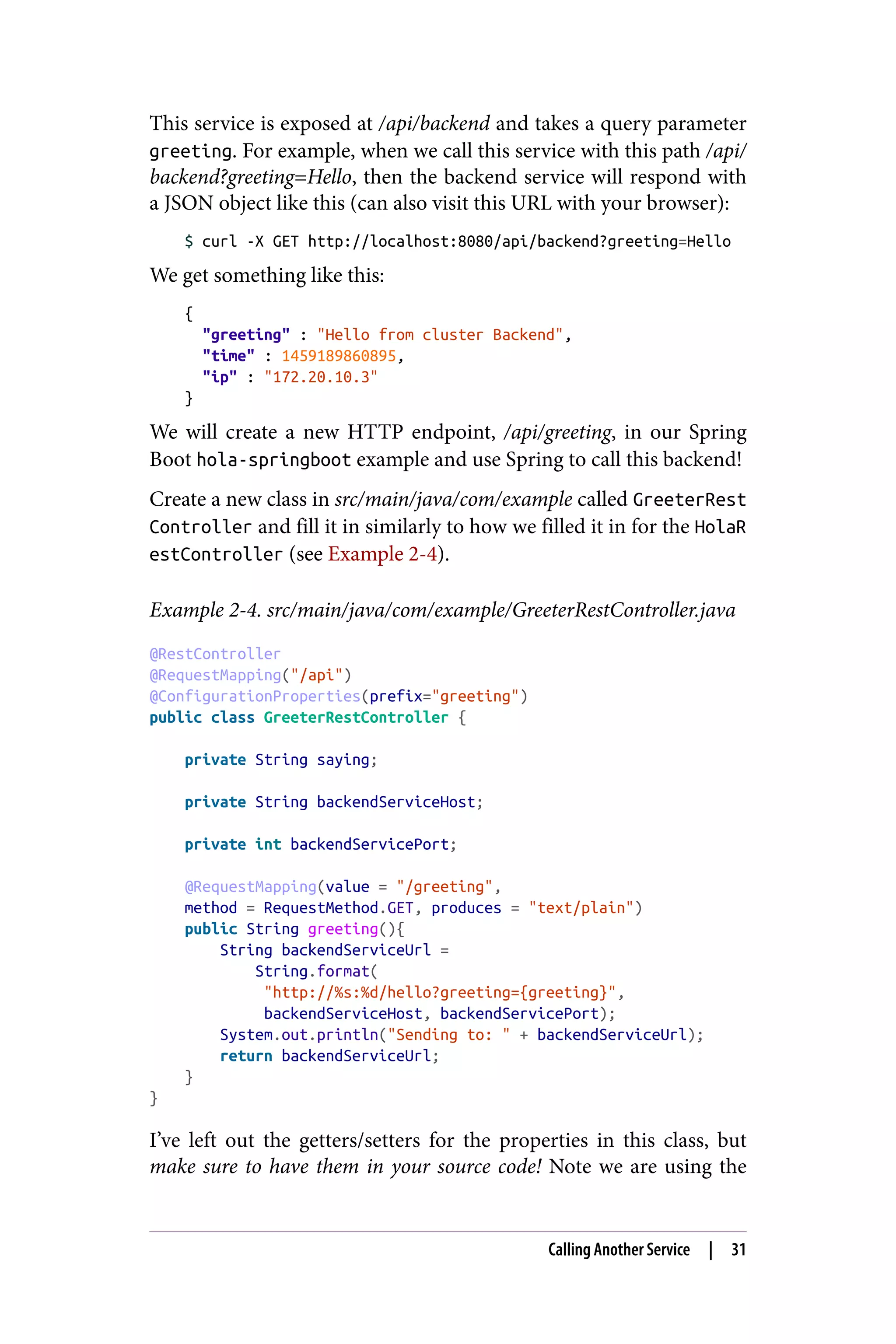

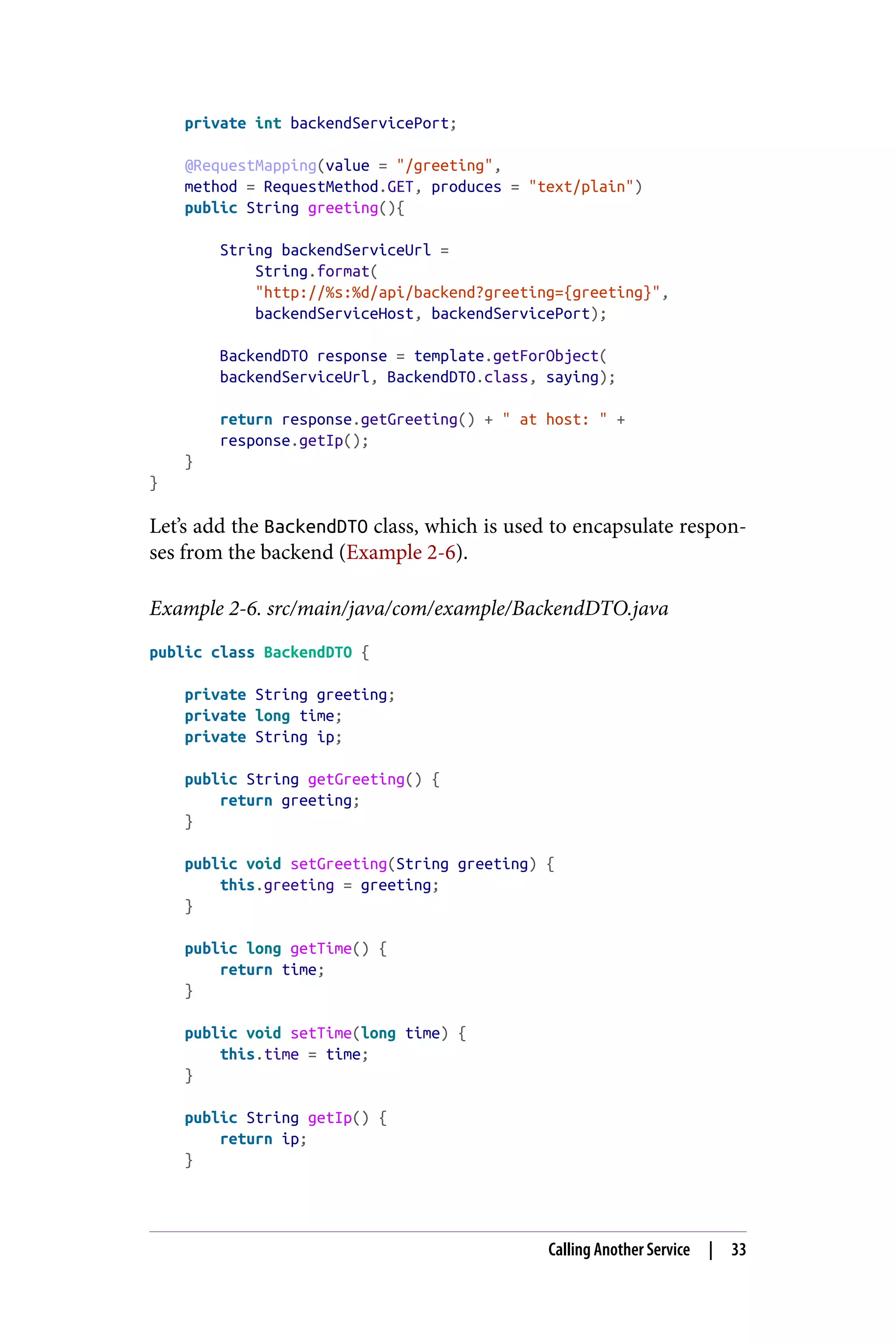
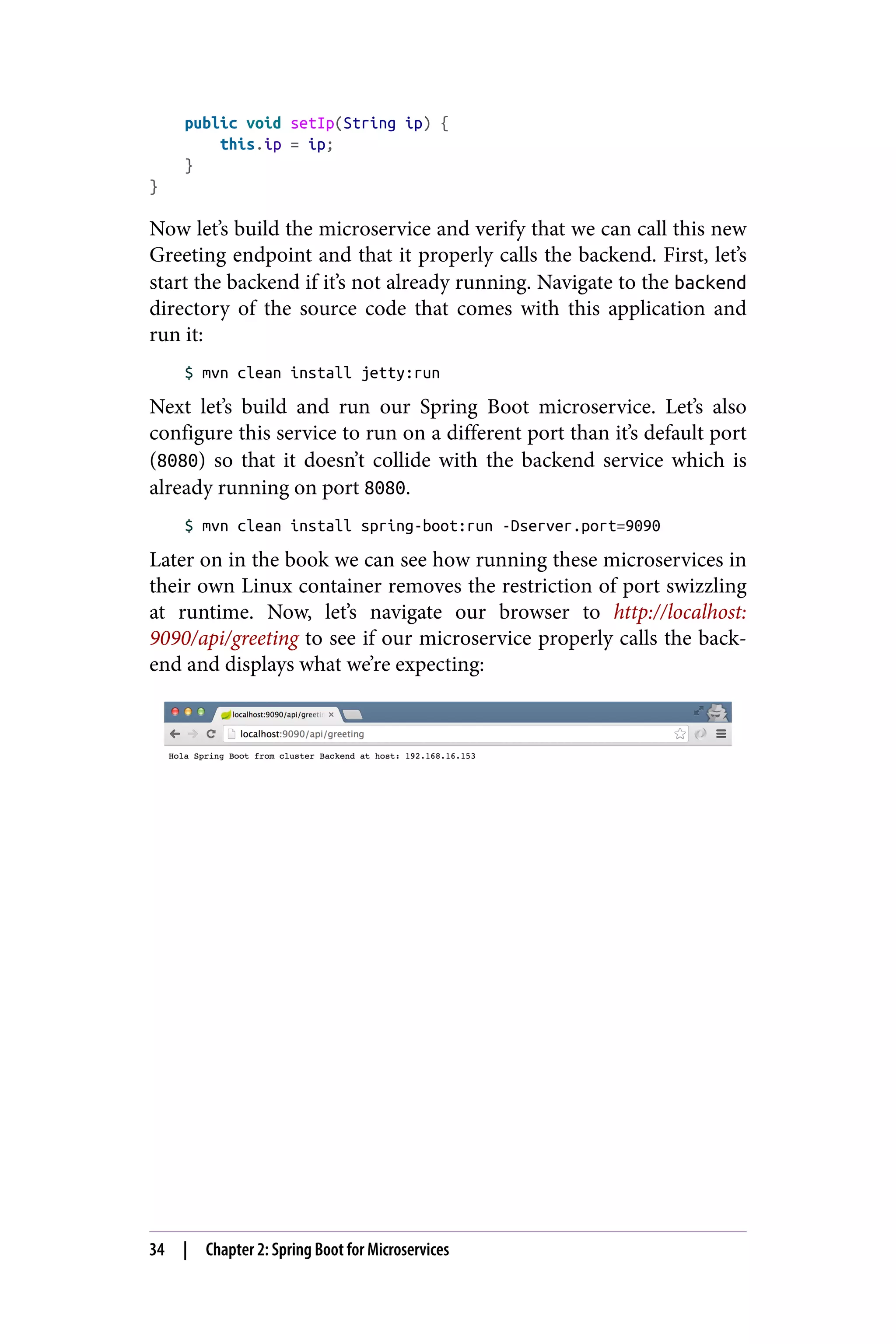
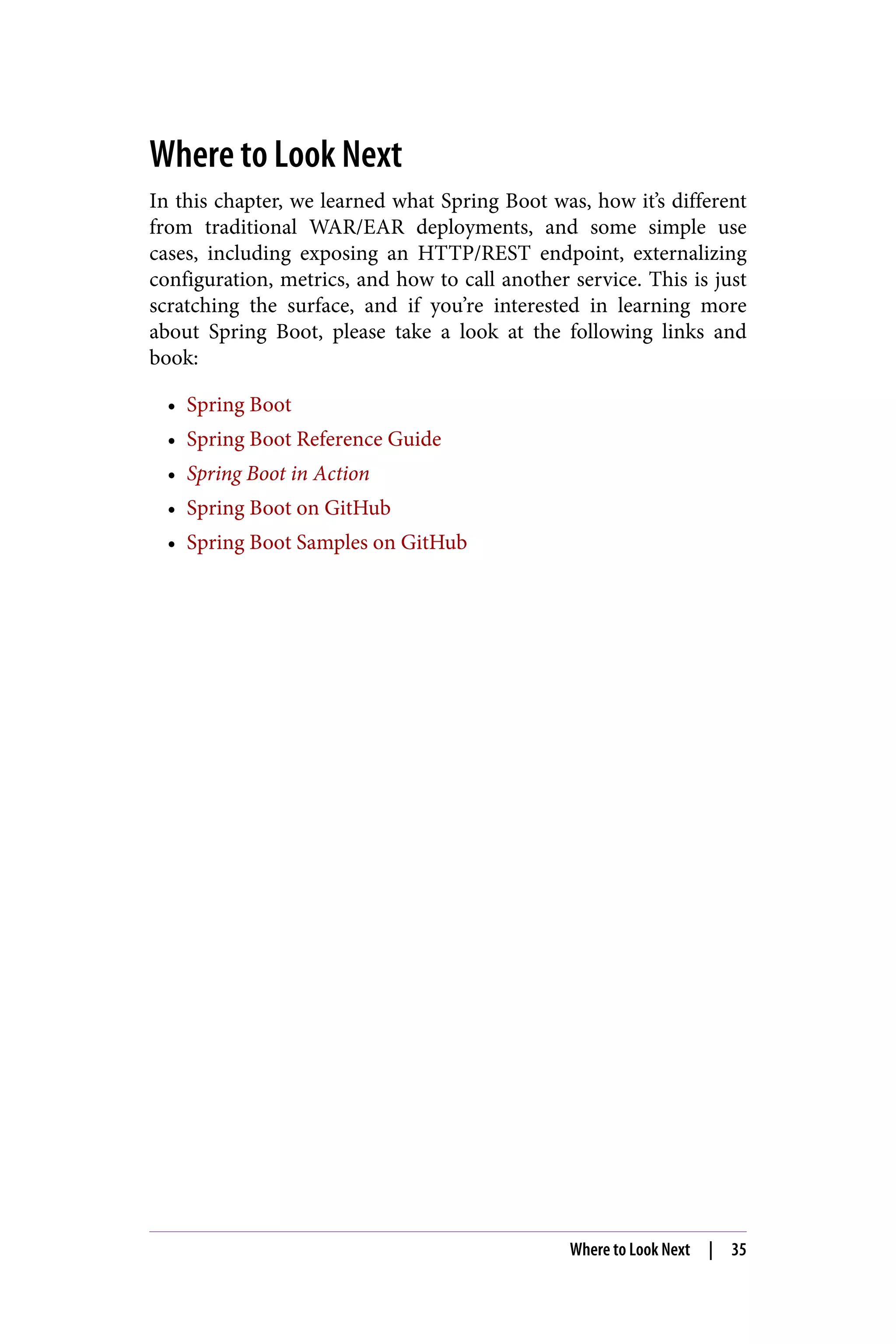

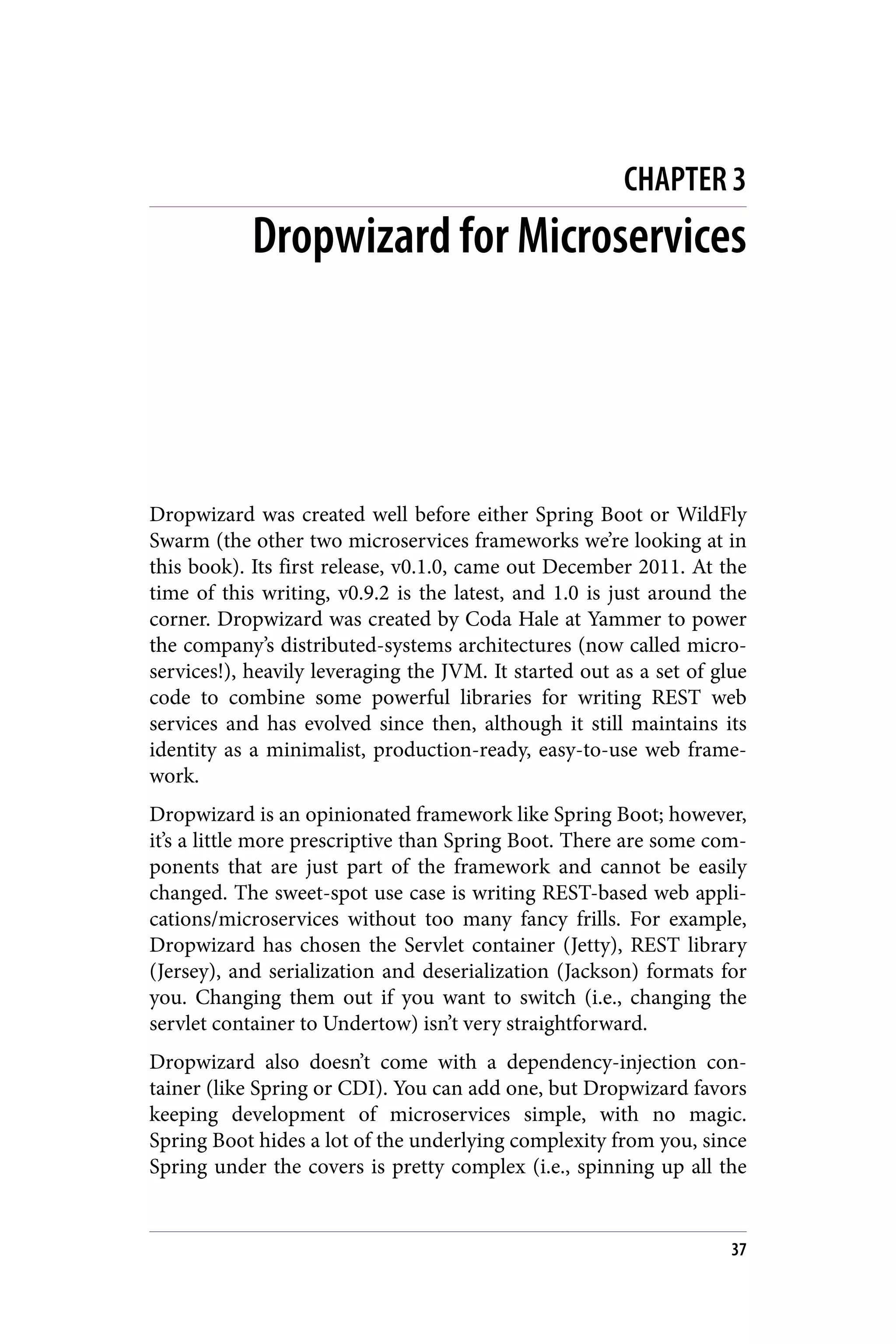
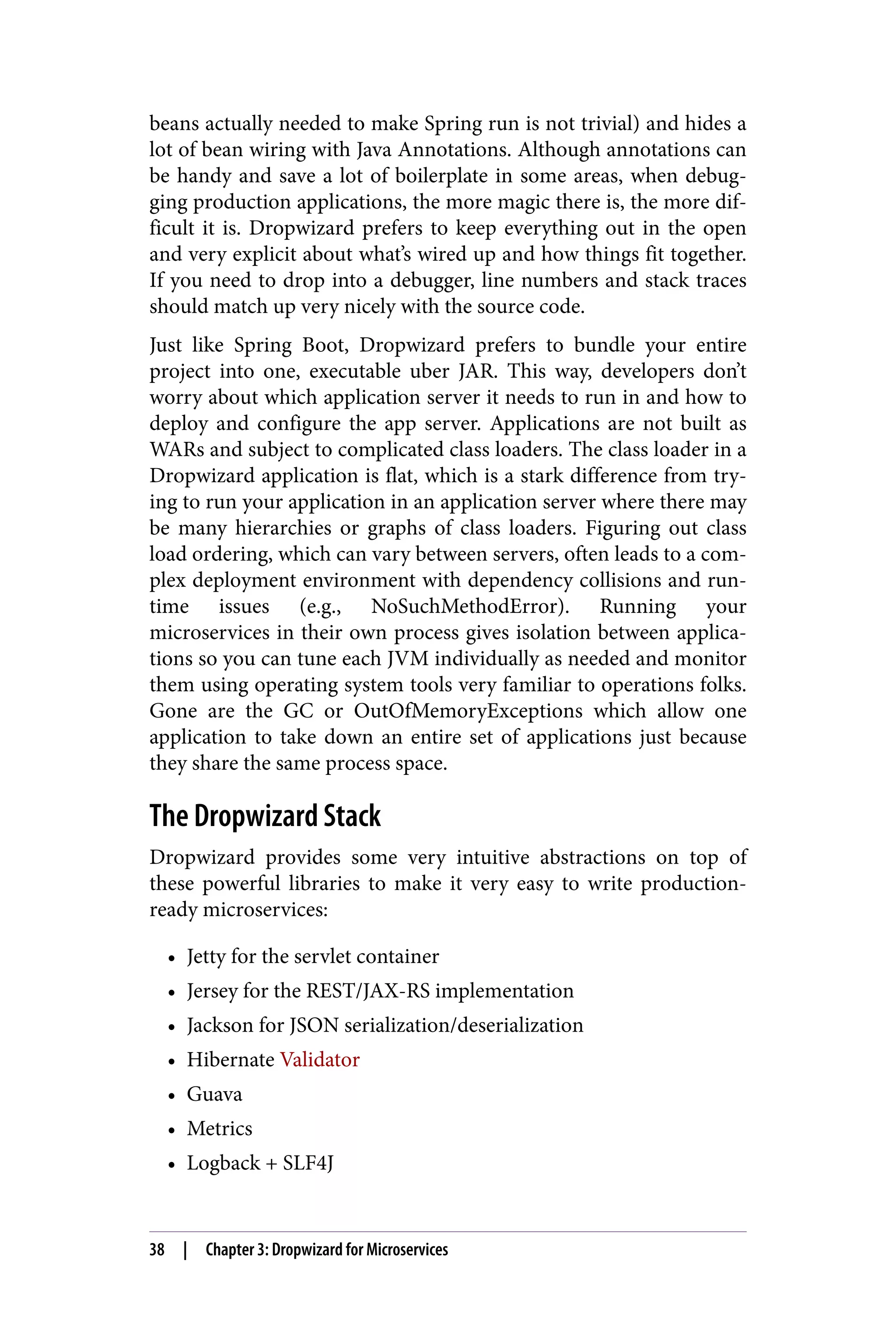
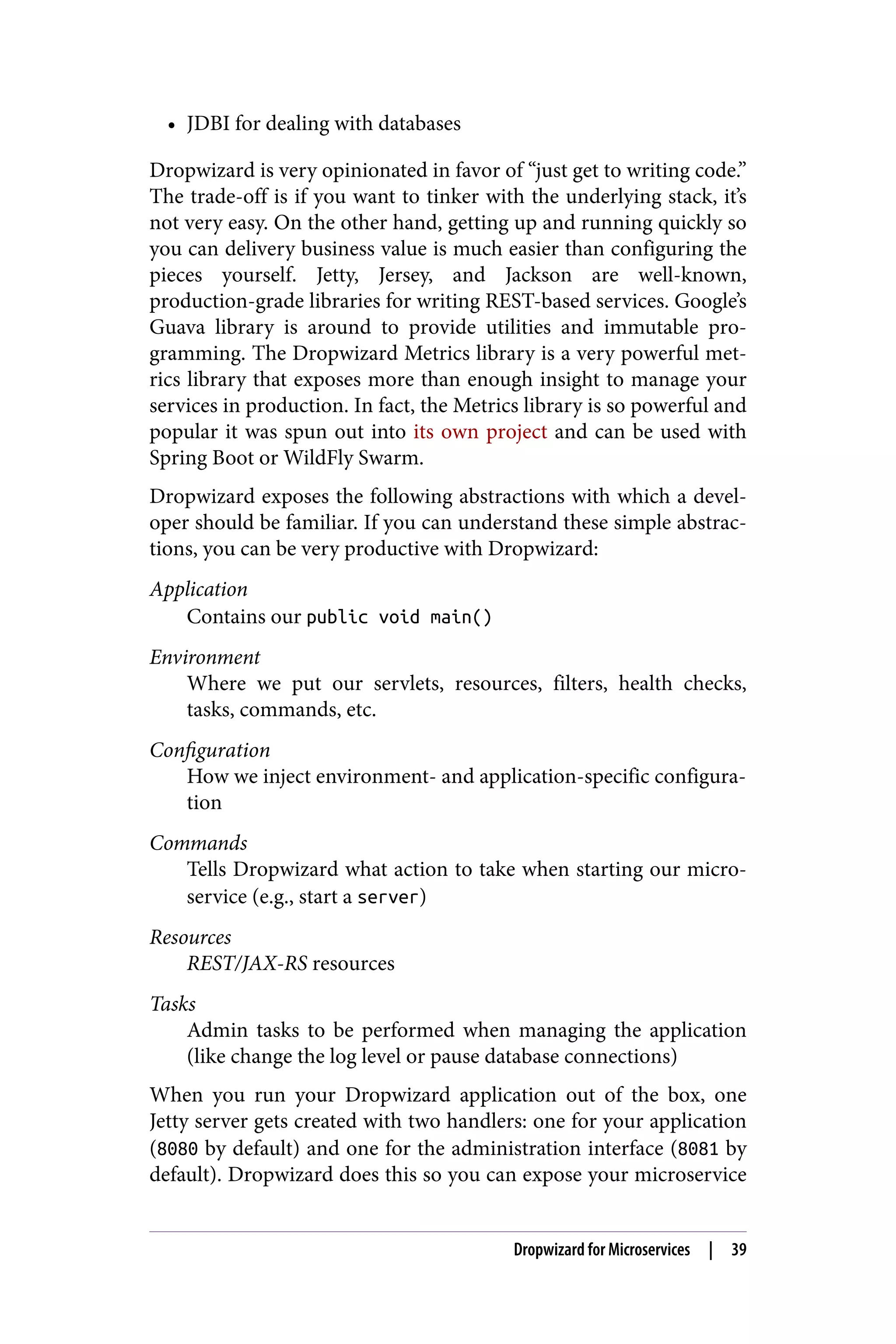

![/HolaDropwizardApplication.java
./src/main/java/com/redhat/examples/dropwizard
/HolaDropwizardConfiguration.java
./src/main/java/com/redhat/examples/dropwizard/resources
./src/main/resources
./src/main/resources/assets
./src/main/resources/banner.txt
./pom.xml
Note that Dropwizard creates a package structure for you that fol‐
lows their convention:
api
POJOs that define the objects used in your REST resources
(some people call these objects domain objects or DTOs).
cli
This is where your Dropwizard commands go (additional com‐
mands you wish to add to startup of your application).
client
Client helper classes go here.
db
Any DB related code or configuration goes here.
health
Microservice-specific health checking that can be exposed at
runtime in the admin interface goes here.
resources
Our REST resource classes go here.
We also have the files HolaDropwizardApplication.java and Hola‐
DropwizardConfiguration.java, which is where our configuration
and bootstrapping code goes. Take a look at the HolaDropwizardAp
plication class in Example 3-1, for example.
Example 3-1. src/main/java/com/redhat/examples/dropwizard/
HolaDropwizardApplication.java
public class HolaDropwizardApplication extends
Application<HolaDropwizardConfiguration> {
public static void main(final String[] args)
throws Exception {
new HolaDropwizardApplication().run(args);
}
Getting Started | 41](https://image.slidesharecdn.com/microservicesforjavadevelopers-190704170017/75/Microservices-for-Java-Developers-48-2048.jpg)
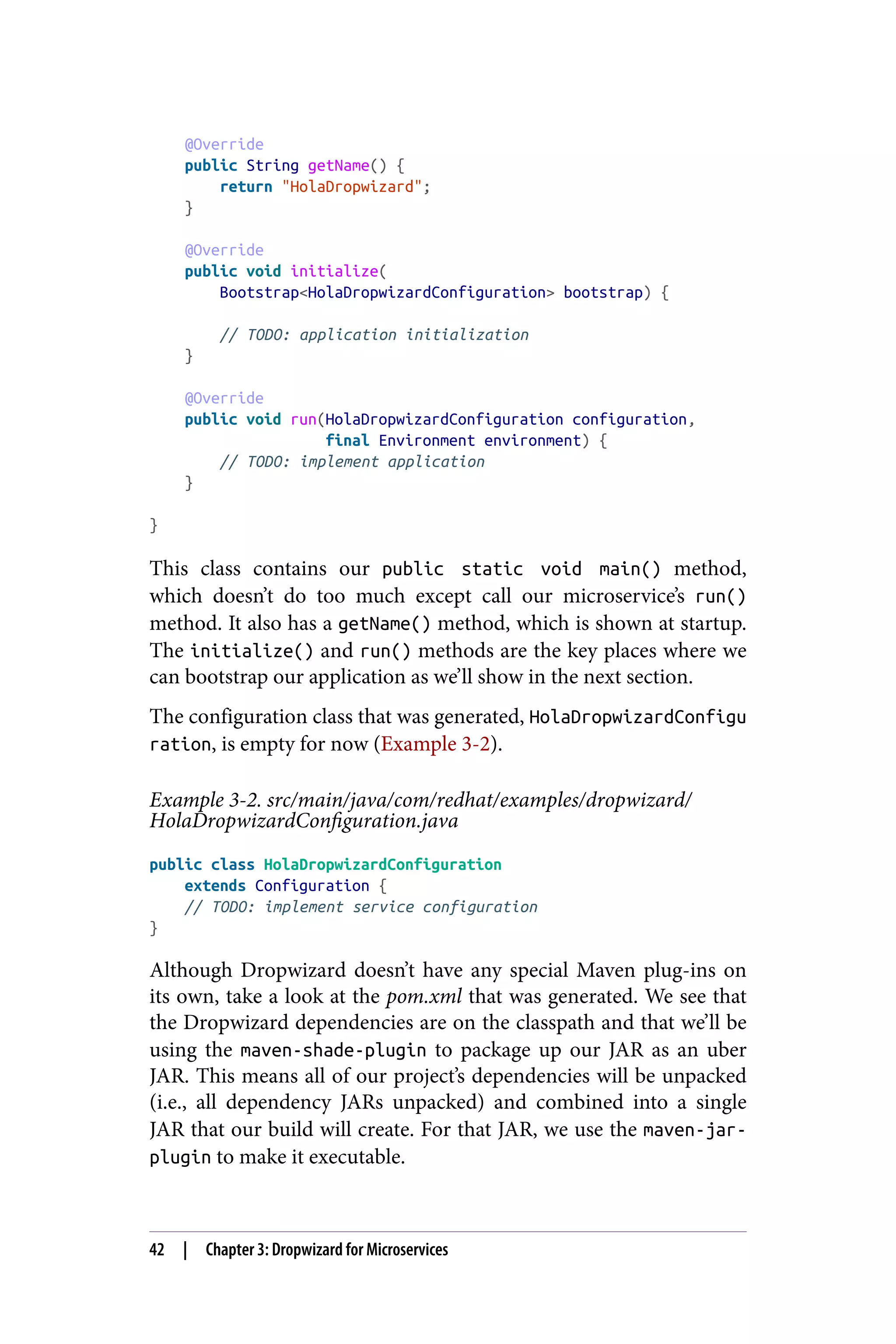
![One plug-in we do want to add is the exec-maven-plugin. With
Spring Boot we were able to just run our microservice with mvn
spring-boot:run. We want to be able to do the same thing with our
Dropwizard application, so let’s add the following plug-in within the
<build> section of the pom.xml, shown in Example 3-3.
Example 3-3. pom.xml
<plugin>
<groupId>org.codehaus.mojo</groupId>
<artifactId>exec-maven-plugin</artifactId>
<configuration>
<mainClass>
com.redhat.examples.dropwizard.HolaDropwizardApplication
</mainClass>
<arguments>
<argument>server</argument>
</arguments>
</configuration>
</plugin>
Now we can execute our application from the command line like
this:
$ mvn exec:java
We should see something like what’s in Example 3-4.
Example 3-4. HolaDropwizard
====================================================================
HolaDropwizard
====================================================================
INFO [2016-03-27 21:54:22,279] io.dropwizard.server.DefaultServer...
: Registering jersey handler with root path prefix: /
INFO [2016-03-27 21:54:22,291] io.dropwizard.server.DefaultServer...
: Registering admin handler with root path prefix: /
INFO [2016-03-27 21:54:22,326] org.eclipse.jetty.setuid.SetUIDL...
: Opened application@5dee571c{HTTP/1.1}{0.0.0.0:8080}
INFO [2016-03-27 21:54:22,327] org.eclipse.jetty.setuid.SetUIDL...
: Opened admin@f8bd099{HTTP/1.1}{0.0.0.0:8081}
INFO [2016-03-27 21:54:22,329] org.eclipse.jetty.server.Server
: jetty-9.2.13.v20150730
INFO [2016-03-27 21:54:22] io.dropwizard.jersey.DropwizardResou...
: The following paths were found for the configured resources:
Getting Started | 43](https://image.slidesharecdn.com/microservicesforjavadevelopers-190704170017/75/Microservices-for-Java-Developers-50-2048.jpg)
![NONE
INFO [2016-03-27 21:54] org.eclipse.jetty.server.handler.Context...
: Started i.d.j.MutableServletContextHandler@1dfb9685{/,null,AVAI...
INFO [2016-03-27 21:54:22] io.dropwizard.setup.AdminEnvironment:...
POST /tasks/log-level (dropwizard.servlets.tasks.LogConfigurat...
POST /tasks/gc (io.dropwizard.servlets.tasks.GarbageCollection...
WARN [2016-03-27 21:54:22,695] io.dropwizard.setup.AdminEnvironm...
!!!!!!!!!!!!!!!!!!!!!!!!!!!!!!!!!!!!!!!!!!!!!!!!!!!!!!!!!!!!!!!!!!!!
!!!!!!!!!!!!!!!!!!!!!!!!!!!!!!!!!!!!!!!!!!!!!!!!!!!!!!!!!!!!!!!!!!!!
!THIS APPLICATION HAS NO HEALTHCHECKS. THIS MEANS YOU WILL NEVER...
! IF IT DIES IN PRODUCTION, WHICH MEANS YOU WILL NEVER KNOW IF...
!LETTING YOUR USERS DOWN. YOU SHOULD ADD A HEALTHCHECK FOR EACH...
! APPLICATION'S DEPENDENCIES WHICH FULLY (BUT LIGHTLY) TESTS...
!!!!!!!!!!!!!!!!!!!!!!!!!!!!!!!!!!!!!!!!!!!!!!!!!!!!!!!!!!!!!!!!!!!!
!!!!!!!!!!!!!!!!!!!!!!!!!!!!!!!!!!!!!!!!!!!!!!!!!!!!!!!!!!!!!!!!!!!!
INFO [2016-03-27 21:54] org.eclipse.jetty.server.handler.ContextH...
: Started i.d.j.MutableServletContextHandler@4969dc6{/,null,AVA...
INFO [2016-03-27 21:54:22,704] org.eclipse.jetty.server.ServerCo...
: Started application@5dee571c{HTTP/1.1}{0.0.0.0:8080}
INFO [2016-03-27 21:54:22,705] org.eclipse.jetty.server.ServerCo...
: Started admin@f8bd099{HTTP/1.1}{0.0.0.0:8081}
INFO [2016-03-27 21:54:22,705] org.eclipse.jetty.server.Server
: Started @2914ms
If you see the application start up, you can try to navigate in your
browser to the default location for RESTful endpoints: http://local
host:8080. You probably won’t see too much:
{"code":404,"message":"HTTP 404 Not Found"}
If you try going to the admin endpoint http://localhost:8081, you
should see a simple page with a few links. Try clicking around to see
what kind of value is already provided out of the box for managing
your microservice!
44 | Chapter 3: Dropwizard for Microservices](https://image.slidesharecdn.com/microservicesforjavadevelopers-190704170017/75/Microservices-for-Java-Developers-51-2048.jpg)
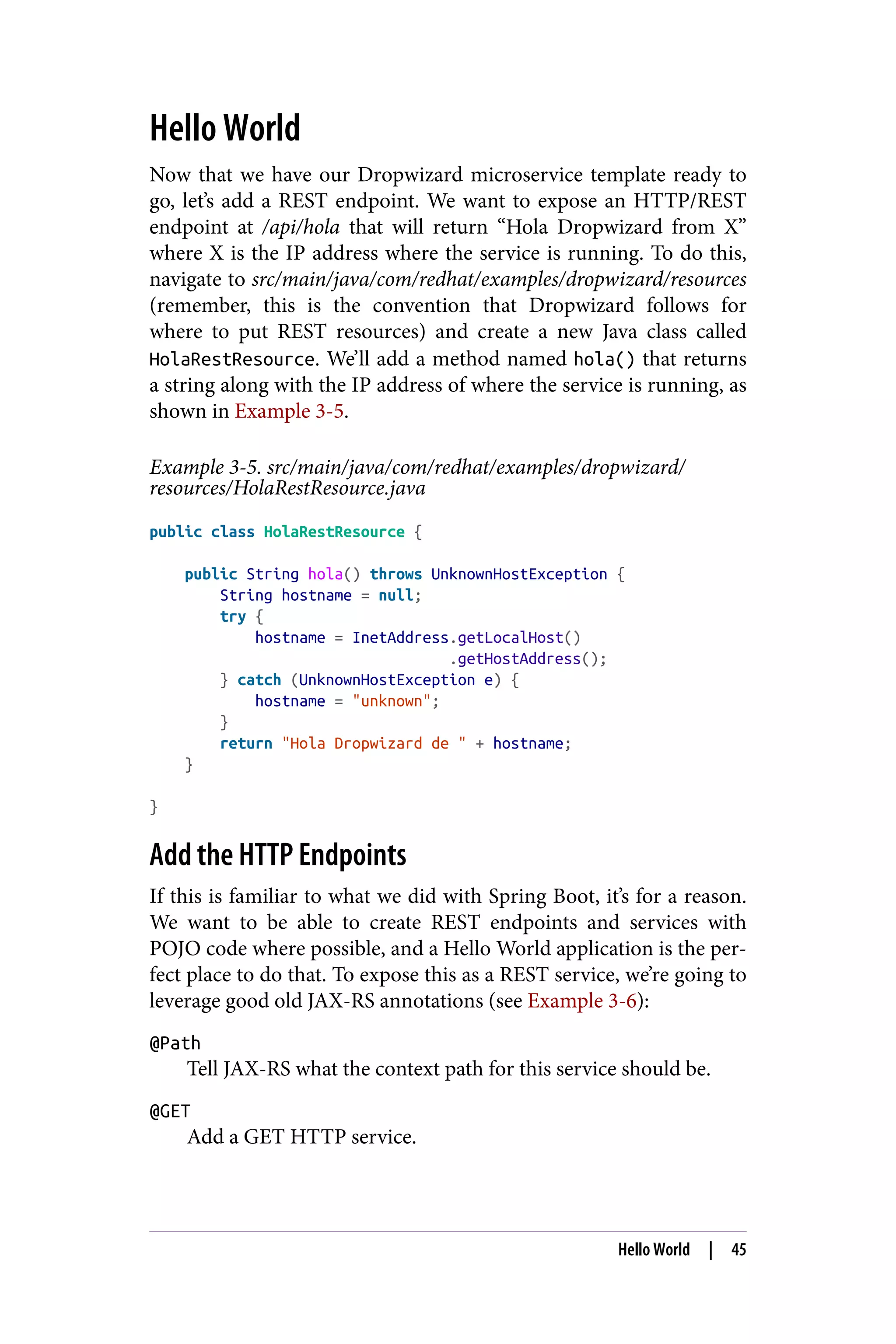
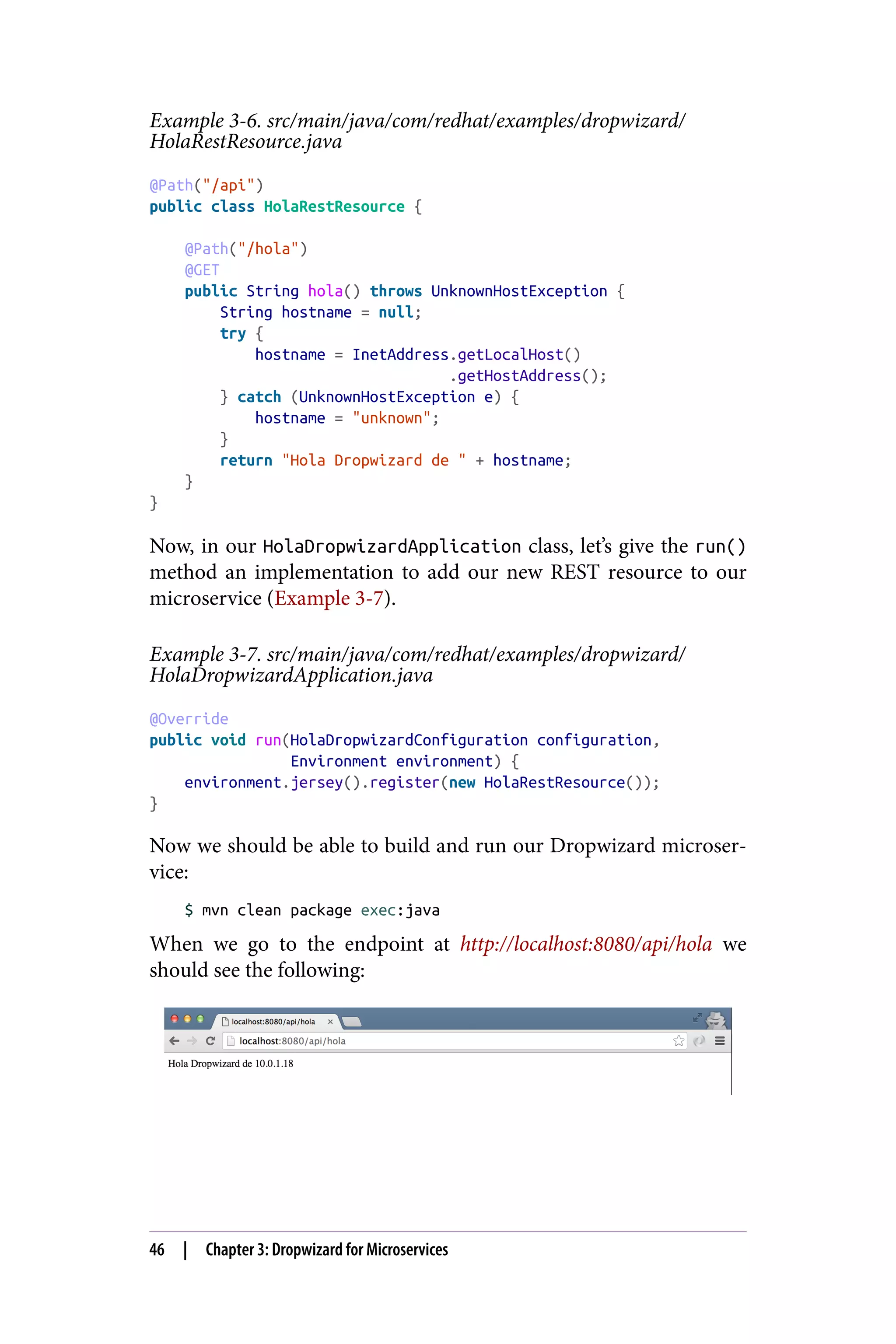

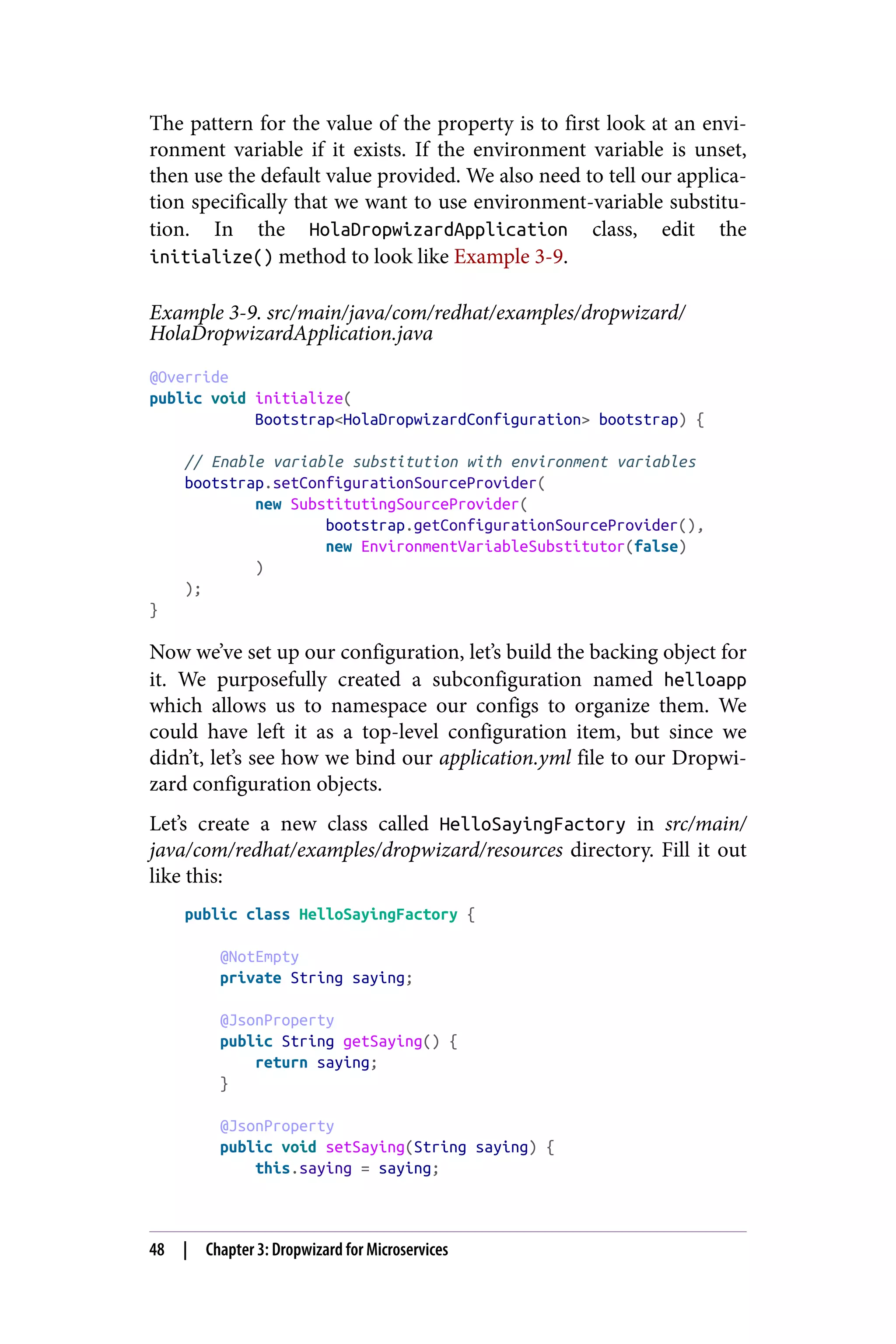
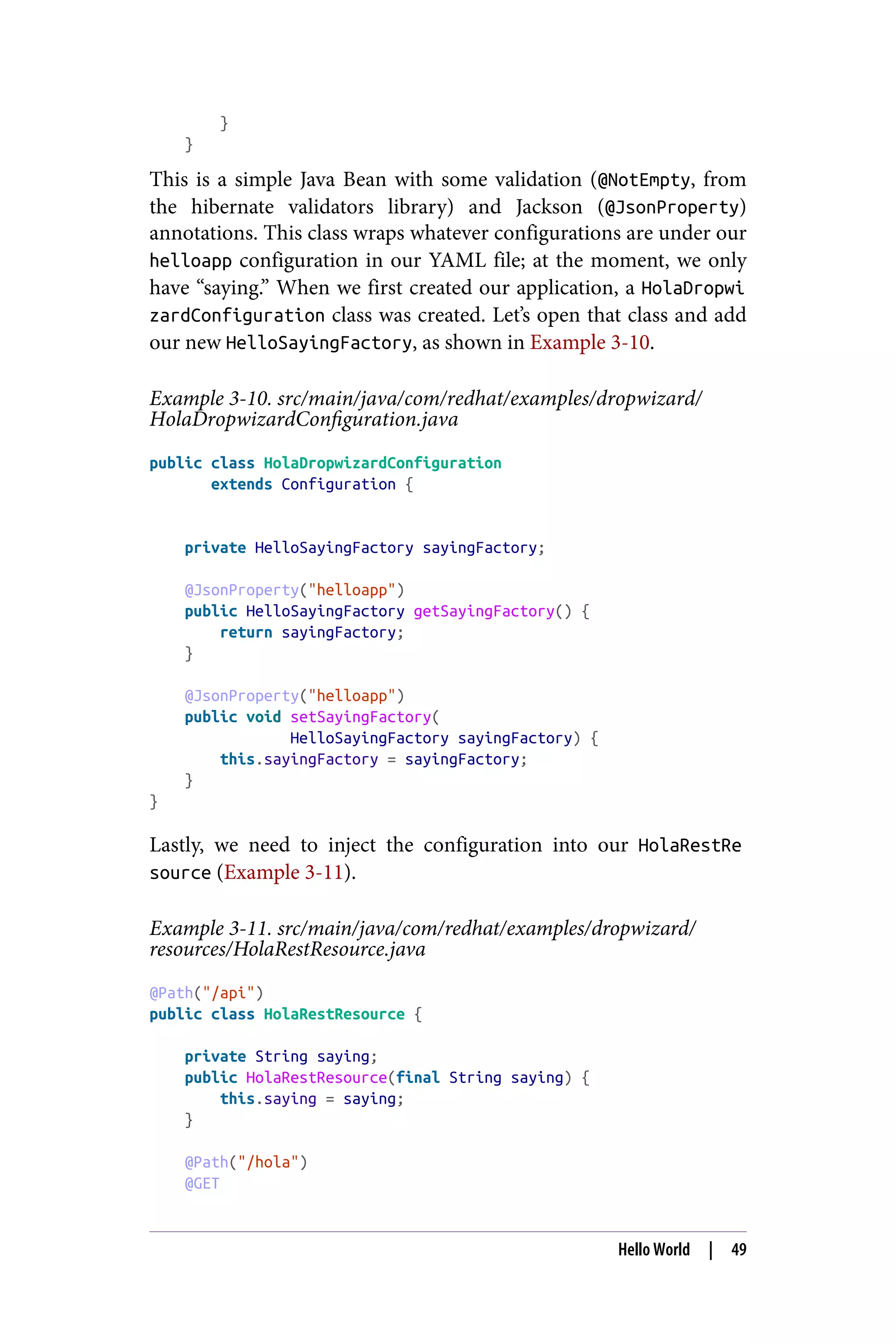
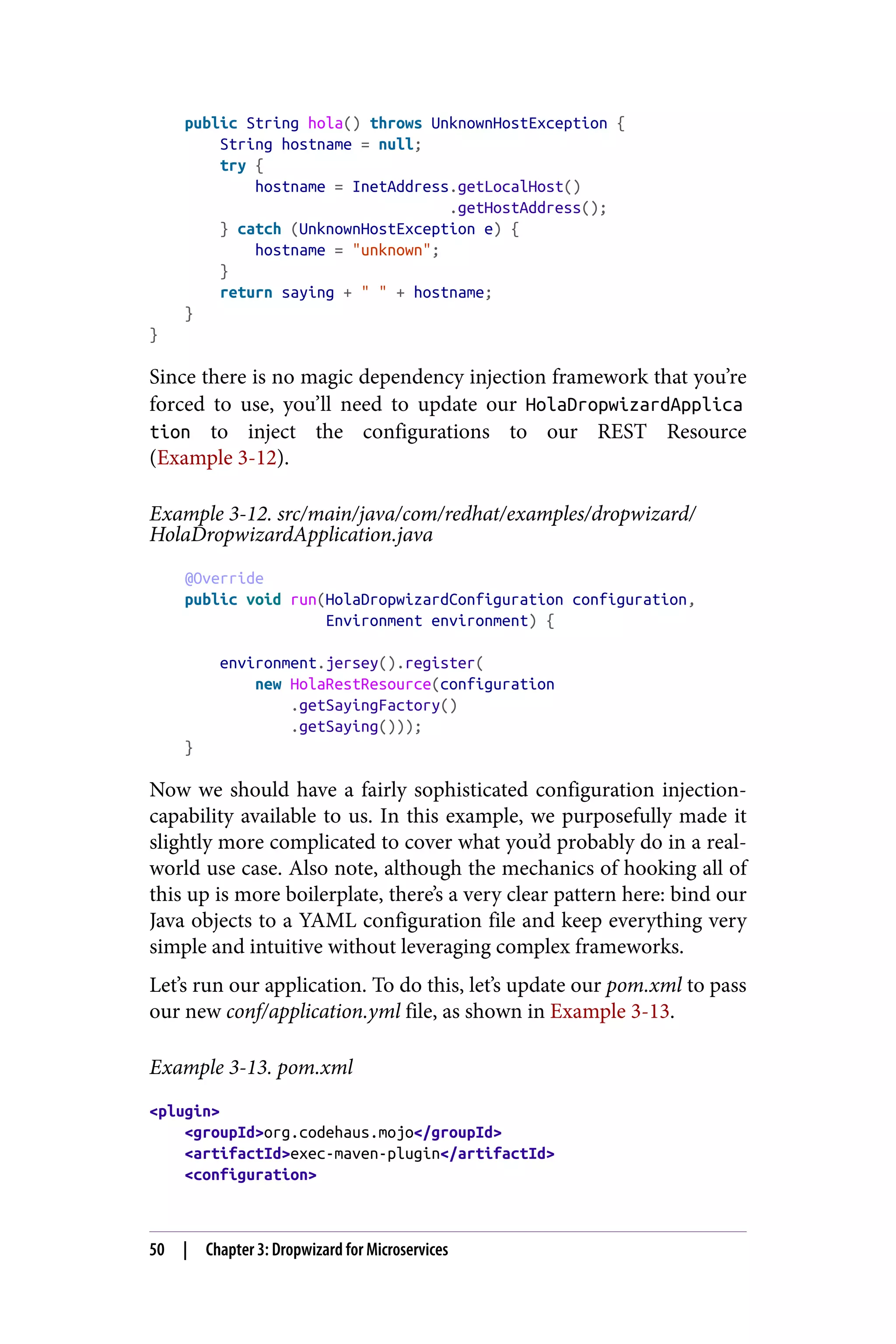


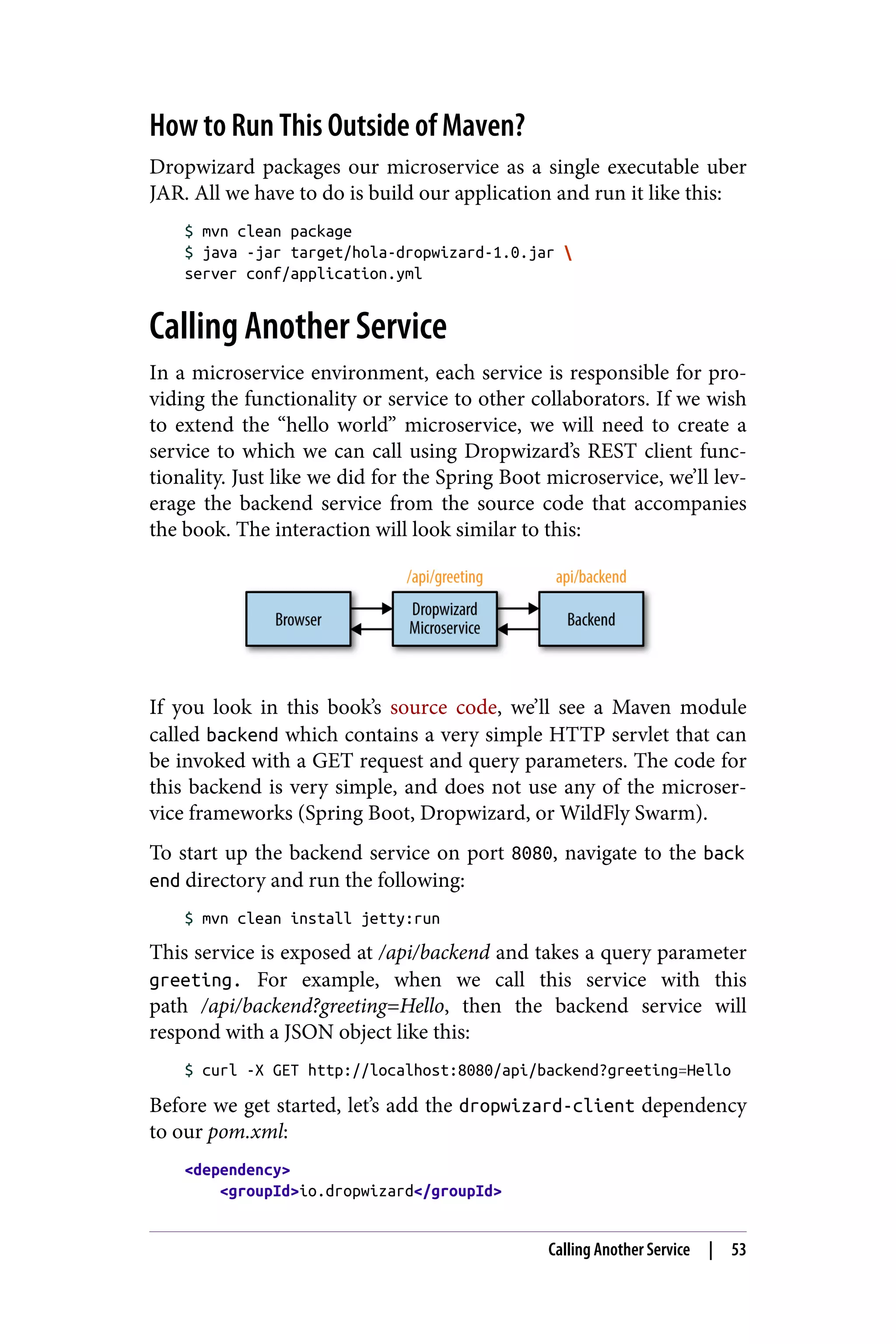
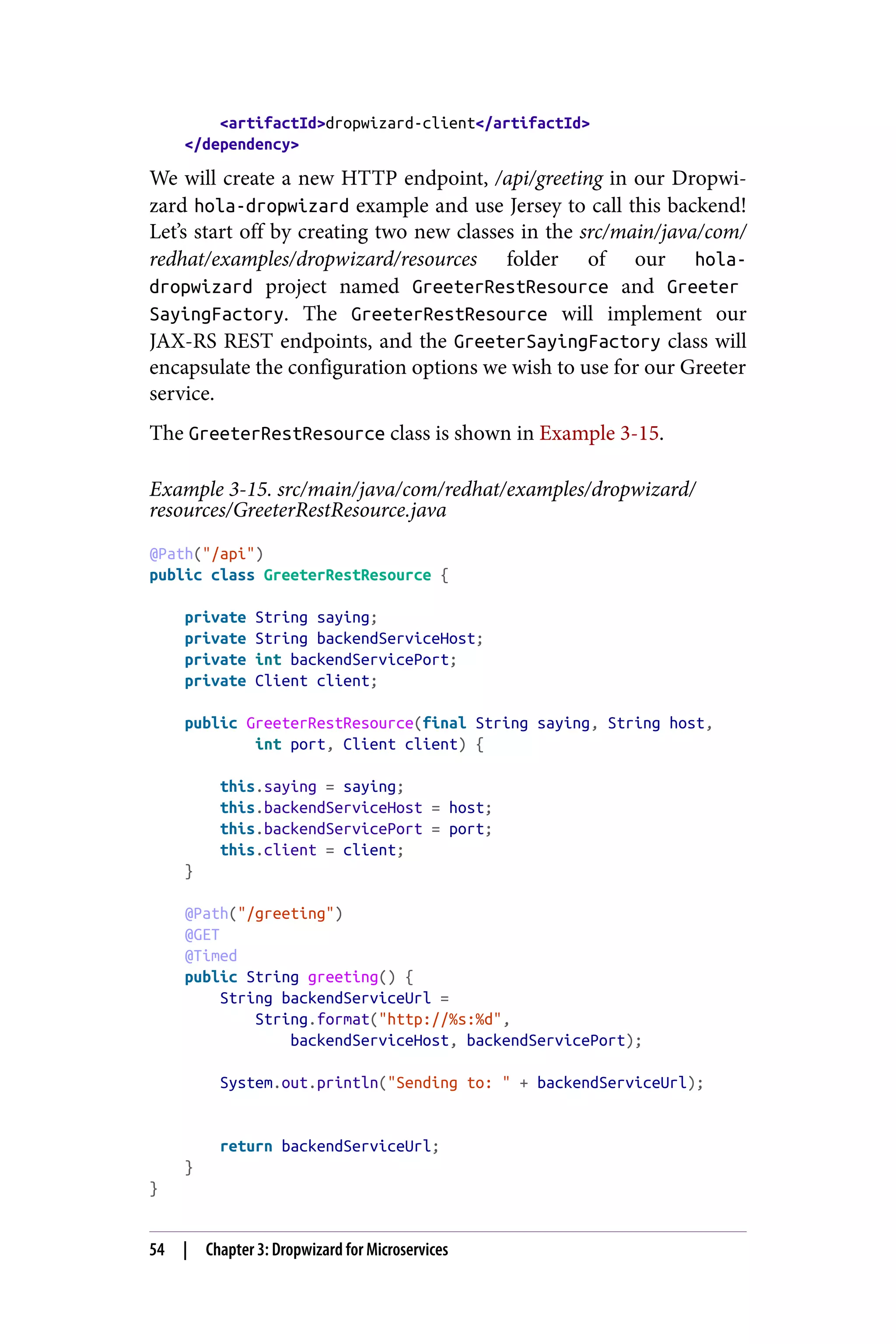
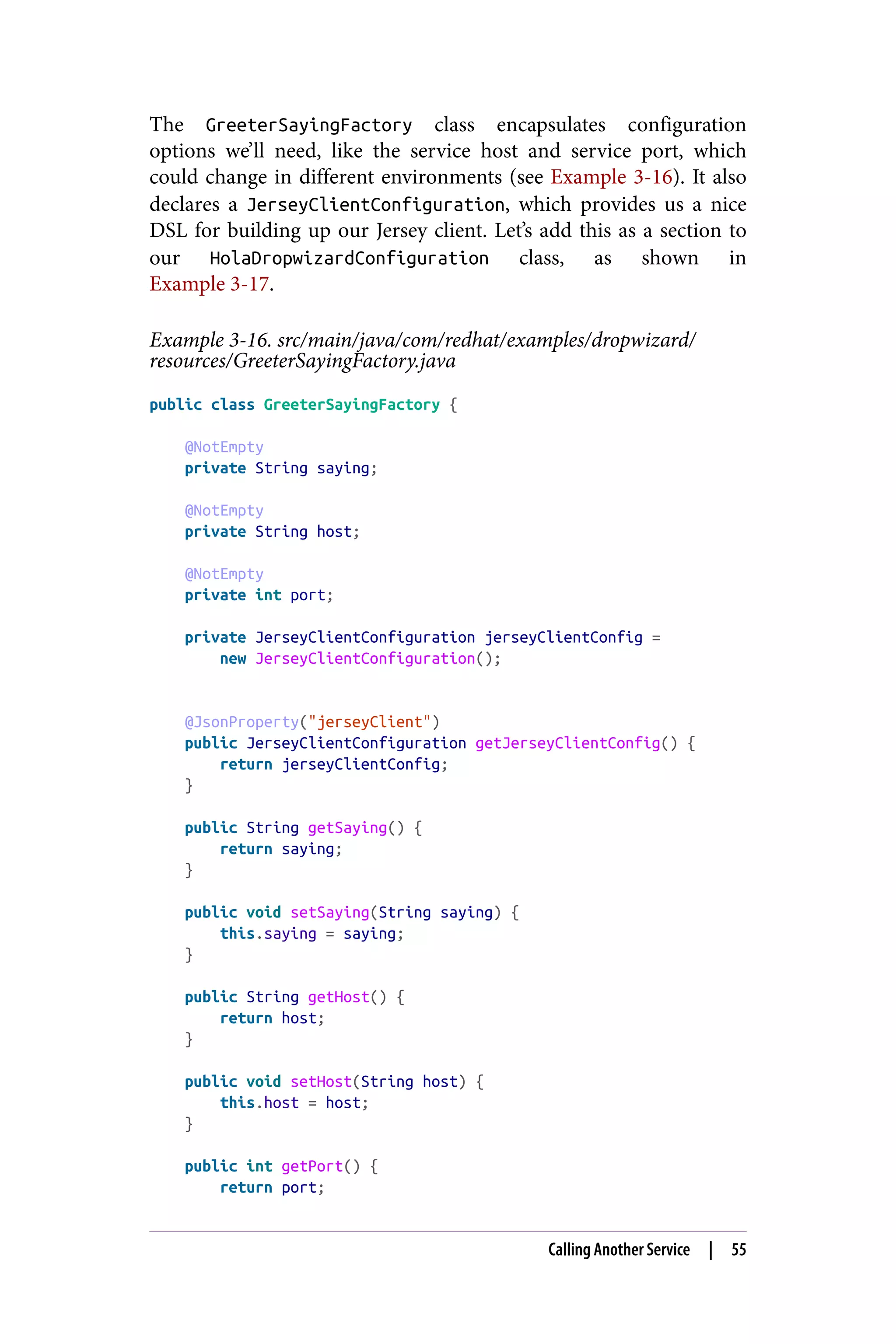

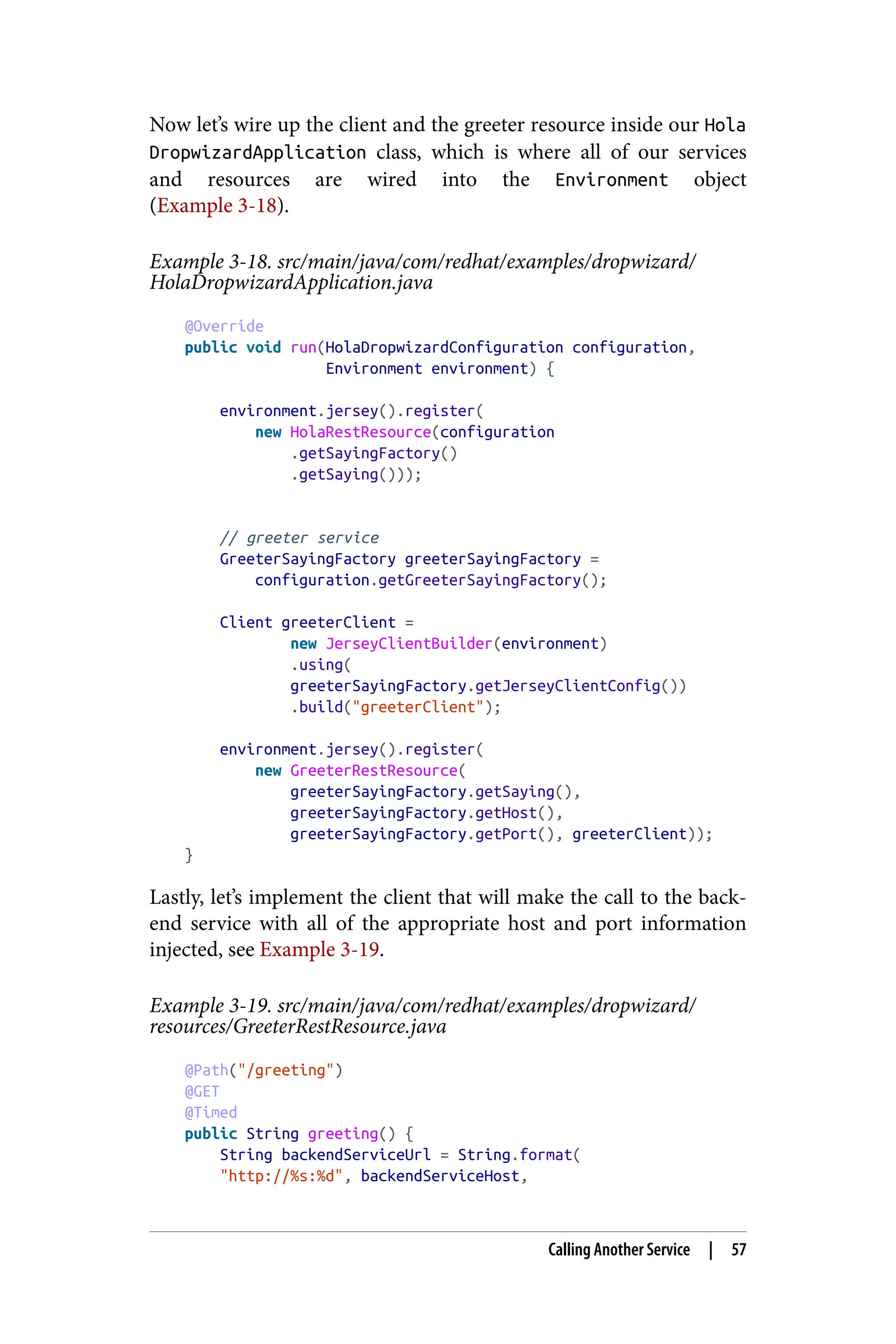

![$ mvn clean install exec:java
-Ddw.server.applicationConnectors[0].port=9090
Now, let’s navigate our browser to http://localhost:9090/api/greeting
to see if our microservice properly calls the backend and displays
what we’re expecting:
Where to Look Next
In this chapter we learned about Dropwizard, saw some differences
and similarities with Spring Boot and how to expose REST end‐
points, configuration, and metrics, and make calls to external serv‐
ices. This was meant as a quick introduction to Dropwizard and is
by no means a comprehensive guide. Check out the following links
for more information:
• Dropwizard Core
• Dropwizard Getting Started
• Client API
• Dropwizard on GitHub
• Dropwizard examples on GitHub
Where to Look Next | 59](https://image.slidesharecdn.com/microservicesforjavadevelopers-190704170017/75/Microservices-for-Java-Developers-66-2048.jpg)

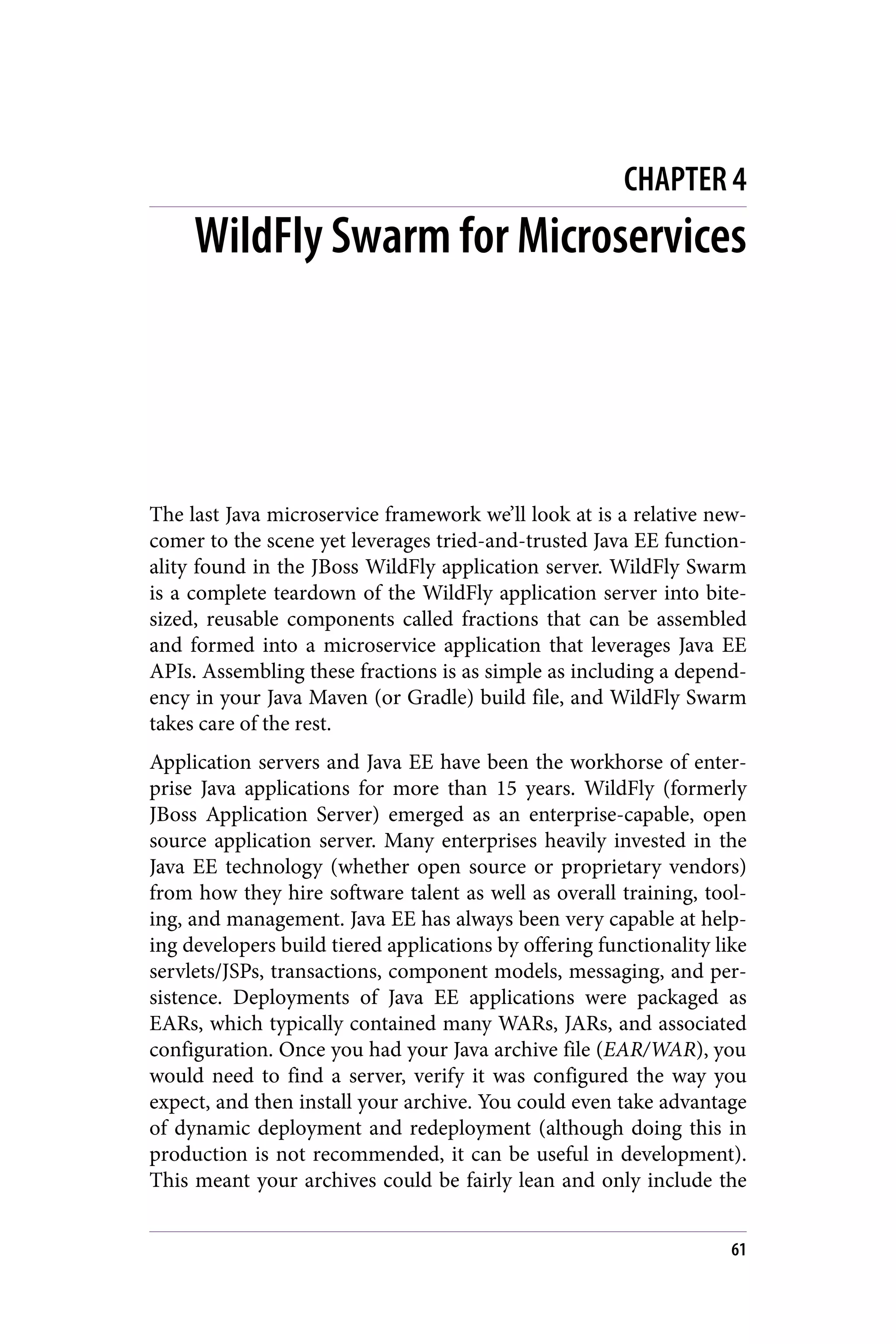
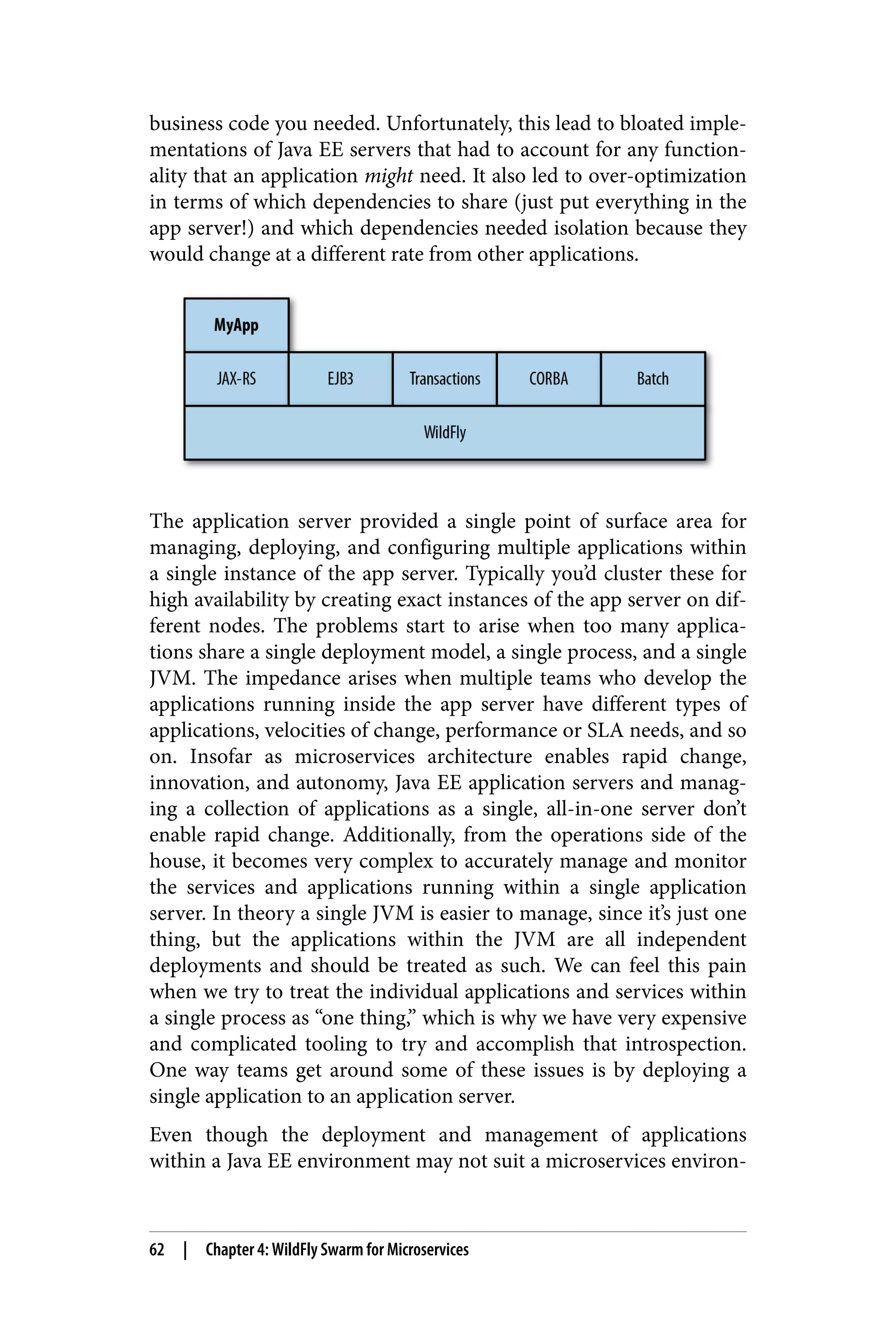

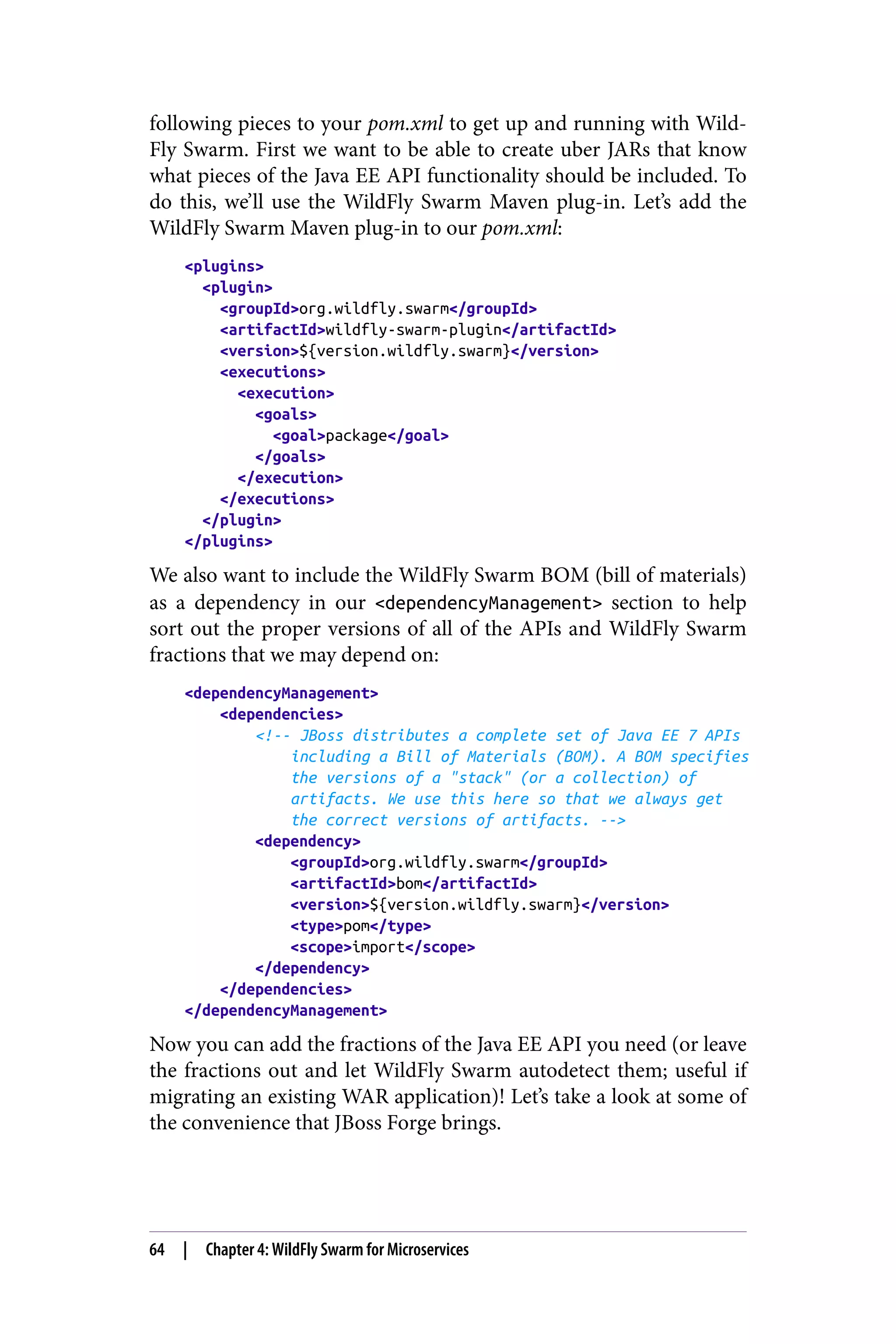
![Using JBoss Forge
JBoss Forge is a set of IDE plug-ins and CLI for quickly creating and
working on Java projects. It has plug-ins for Netbeans, Eclipse, and
IntelliJ to help you create Java projects, add CDI beans, add JPA
entities, add and configure servlets, etc. Let’s look at a quick exam‐
ple. First verify you have JDK/Java 1.8 installed then install JBoss
Forge.
Once you have Forge installed, you should be able to start up the
CLI (all of these commands available in the IDE plug-in as well):
$ forge
Feel free to explore what commands are available by pressing Tab,
which also gives auto-completion for any command. JBoss Forge is
built on a modular, plug-in–based architecture which allows others
to write plug-ins to take advantage of the built-in tooling for the CLI
and your favorite IDE. Take a look at some of the addons contrib‐
uted by the community, including AsciiDoctor, Twitter, Arquillian,
and AssertJ. Let’s also install the WildFly Swarm addon for JBoss
Forge:
[temp]$ addon-install
--coordinate org.jboss.forge.addon:wildfly-swarm,1.0.0.Beta2
***SUCCESS*** Addon org.jboss.forge.addon:wildfly-swarm,
1.0.0.Beta2 was installed successfully.
Let’s try a project-new command to build a new Java EE project
that will be built and packaged with WildFly Swarm. Follow the
interactive command prompt with the following inputs:
[swarm]$ project-new
***INFO*** Required inputs not satisfied, interactive mode
* Project name: hola-wildflyswarm
? Package [org.hola.wildflyswarm]: com.redhat.examples.wfswarm
? Version [1.0.0-SNAPSHOT]: 1.0
? Final name: hola-wildflyswarm
? Project location [/Users/ceposta/temp/swarm]:
[0] (x) war
[1] ( ) jar
[2] ( ) parent
[3] ( ) forge-addon
[4] ( ) resource-jar
[5] ( ) ear
[6] ( ) from-archetype
[7] ( ) generic
Getting Started | 65](https://image.slidesharecdn.com/microservicesforjavadevelopers-190704170017/75/Microservices-for-Java-Developers-72-2048.jpg)
![Press <ENTER> to confirm, or <CTRL>+C to cancel.
* Project type: [0-7]
[0] (x) Maven
Press <ENTER> to confirm, or <CTRL>+C to cancel.
* Build system: [0]
[0] ( ) JAVA_EE_7
[1] ( ) JAVA_EE_6
[2] ( ) NONE
Press <ENTER> to confirm, or <CTRL>+C to cancel.
? Stack (The technology stack to be used in project): [0-2] 2
***SUCCESS*** Project named 'hola-wildflyswarm'
has been created.
So what we have right now is an empty Java project that doesn’t do
too much. That’s OK, though; we’re just getting started. Let’s set it up
for a JAX-RS application:
[hola-wildflyswarm]$ rest-setup --application-path=/
***SUCCESS*** JAX-RS has been installed.
Now, let’s add in the WildFly Swarm configurations like the Maven
plug-in and the BOM dependency management section:
[hola-wildflyswarm]$ wildfly-swarm-setup --context-path=/
***SUCCESS*** Wildfly Swarm is now set up! Enjoy!
That’s it! Now let’s build and try to run our new WildFly Swarm
microservice:
[HelloResource.java]$ cd ~~
[hola-wildflyswarm]$ wildfly-swarm-run
You should see it successfully start, but it doesn’t do anything or
expose any REST services. But what did JBoss Forge create for us
here? If you look at the directory structure, you should see some‐
thing similar:
./pom.xml
./src
./src/main
./src/main/java
./src/main/java/com/redhat/examples/wfswarm/rest
/RestApplication.java
./src/main/resources
./src/main/webapp
./src/test
66 | Chapter 4: WildFly Swarm for Microservices](https://image.slidesharecdn.com/microservicesforjavadevelopers-190704170017/75/Microservices-for-Java-Developers-73-2048.jpg)
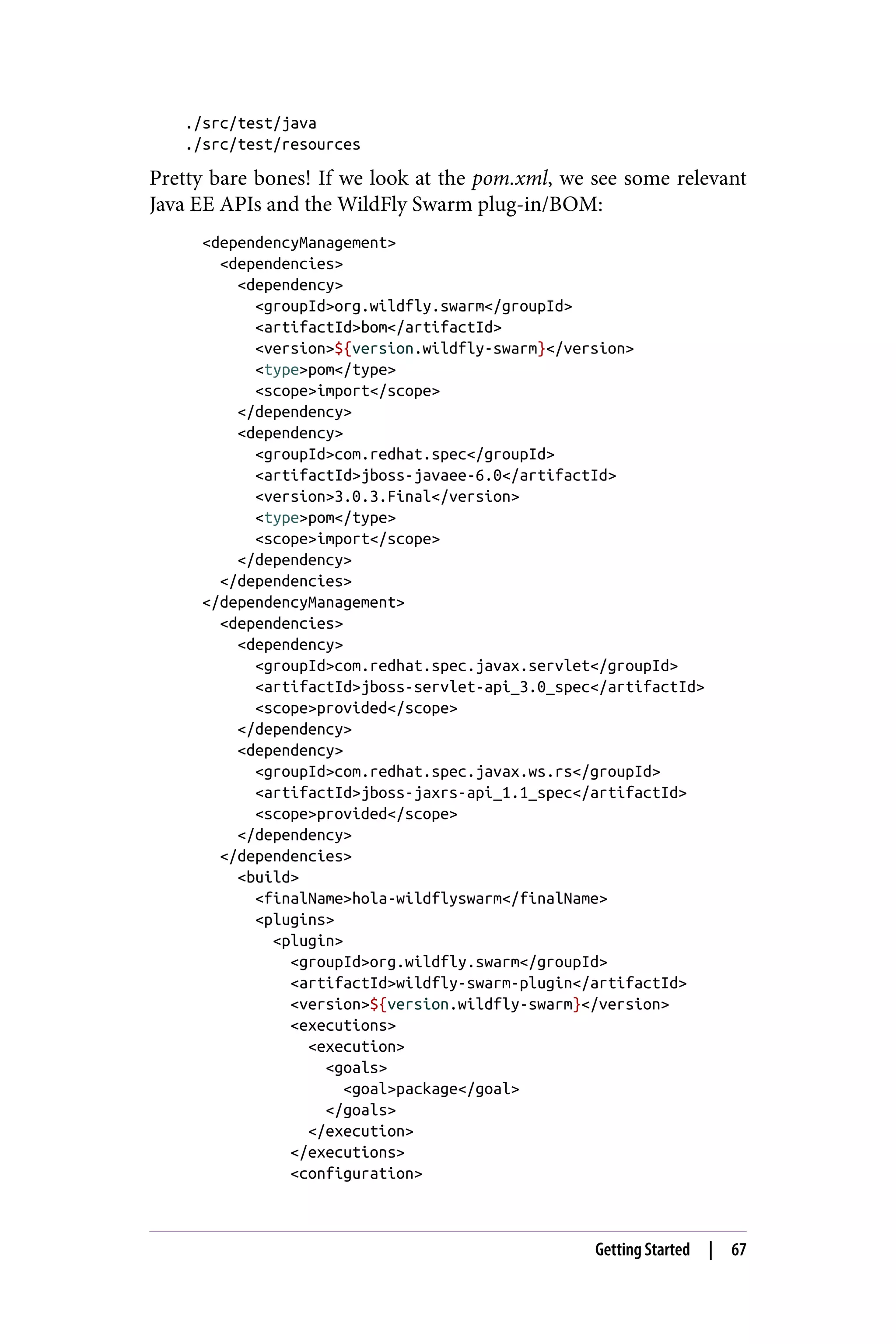
![<properties>
<swarm.context.path>/</swarm.context.path>
</properties>
</configuration>
</plugin>
</plugins>
</build>
Remember, however, WildFly Swarm will only package the pieces of
the Java EE framework that you need to run your application. In this
case, we’ve already set up JAX-RS APIs, so WildFly Swarm will auto‐
matically include the JAX-RS and servlet fractions of an application
server and embed them in your application.
Let’s see how we can add some more functionality.
Hello World
Just like with the other frameworks in the preceding chapters, we
want to add some basic hello-world functionality and then incre‐
mentally add more functionality on top of it. Let’s start by creating a
HolaResource in our project. You can do this with your IDE, or
however you’d like; but again we can leverage JBoss Forge to do any
of the heavy lifting for us here.
Navigate to the directory where you have your project, and fire up
forge if it’s not already running:
$ forge
Add the HTTP Endpoints
Now let’s create a new JAX-RS endpoint with the rest-new-
endpoint command and the interactive wizard, filling in the
prompts using the following example as guidance:
[hola-wildflyswarm]$ rest-new-endpoint
***INFO*** Required inputs not satisfied, interactive mode
? Package Name (The package name where type will be created)
[com.redhat.examples.wfswarm.rest]:
* Type Name (The type name): HolaResource
[0] (x) GET
[1] ( ) POST
[2] ( ) PUT
[3] ( ) DELETE
68 | Chapter 4: WildFly Swarm for Microservices](https://image.slidesharecdn.com/microservicesforjavadevelopers-190704170017/75/Microservices-for-Java-Developers-75-2048.jpg)
![Press <ENTER> to confirm, or <CTRL>+C to cancel.
? Methods (REST methods to be defined): [0-3]
? Path (The root path of the endpoint): api/hola
***SUCCESS***
REST com.redhat.examples.wfswarm.rest.HolaResource created
That’s it! Forge has created the ./src/main/java/com/redhat/examples/
wfswarm/rest/HolaResource.java JAX-RS resource for us, and it
looks similar to this:
package com.redhat.examples.wfswarm.rest;
import javax.ws.rs.Path;
import javax.ws.rs.core.Response;
import javax.ws.rs.GET;
import javax.ws.rs.Produces;
@Path("/api/hola")
public class HolaResource {
@GET
@Produces("text/plain")
public Response doGet() {
return Response.ok("method doGet invoked")
.build();
}
}
Let’s go to the root of the project, build it, and try to fire it up again:
[HelloResource.java]$ cd ~~
[hola-wildflyswarm]$ wildfly-swarm-run
And navigate in a web browser to http://localhost:8080/api/hola (if
an endpoint is not correctly displayed at this endpoint, please go
back and check the preceding steps):
What did we just do? We built a JAX-RS web application using
native Java EE with the JBoss Forge tooling and then ran it as a
microservice inside WildFly Swarm!
Hello World | 69](https://image.slidesharecdn.com/microservicesforjavadevelopers-190704170017/75/Microservices-for-Java-Developers-76-2048.jpg)
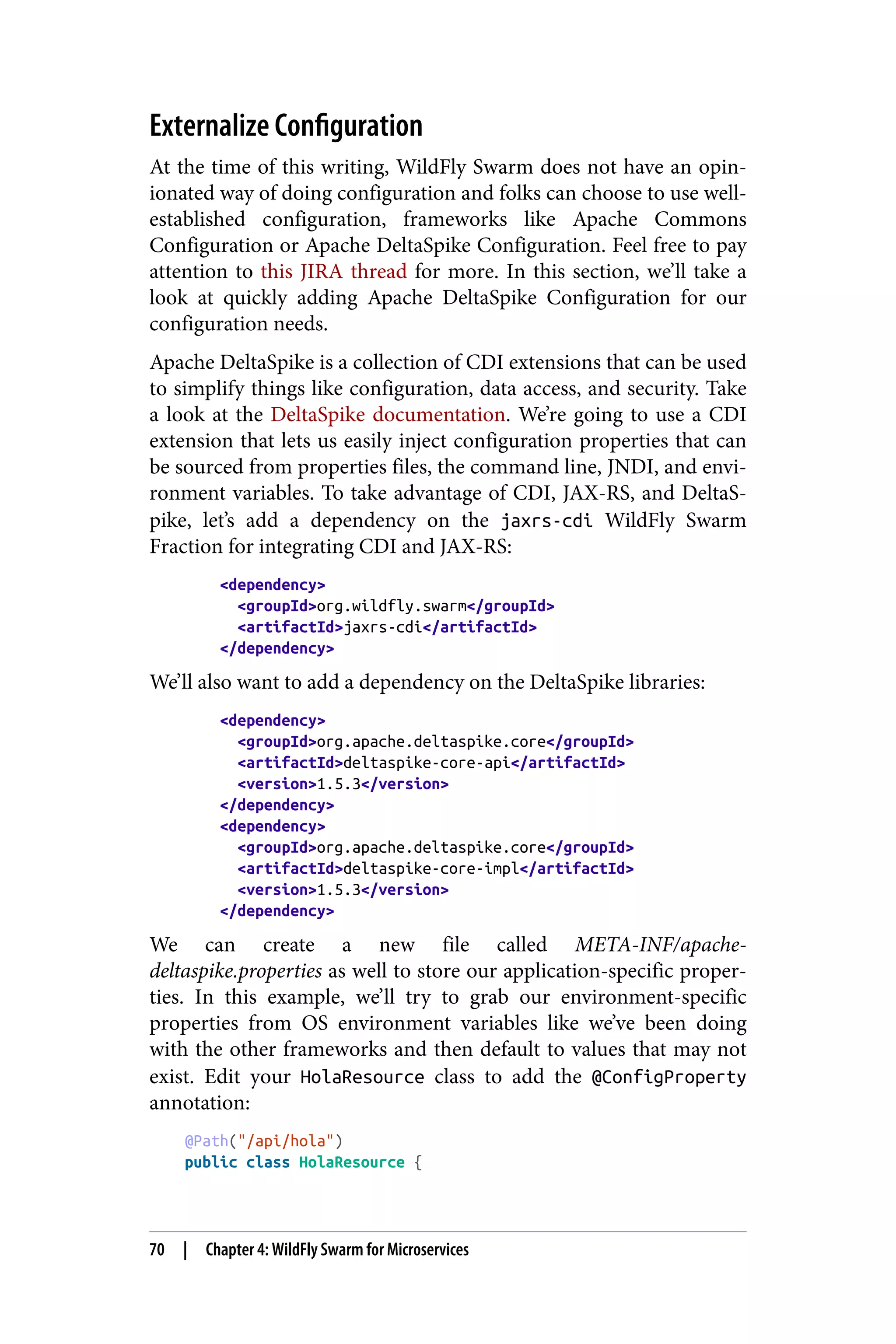
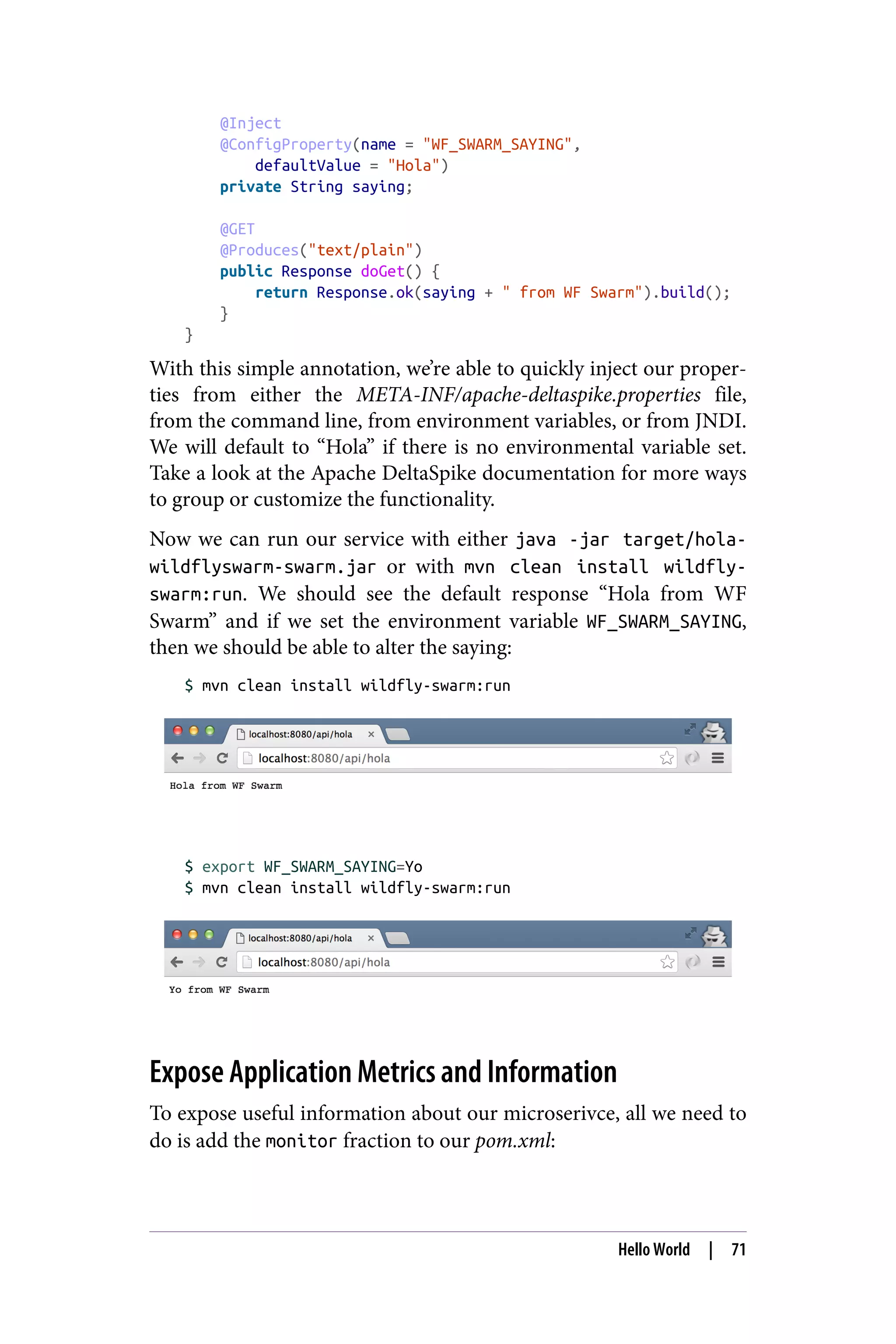
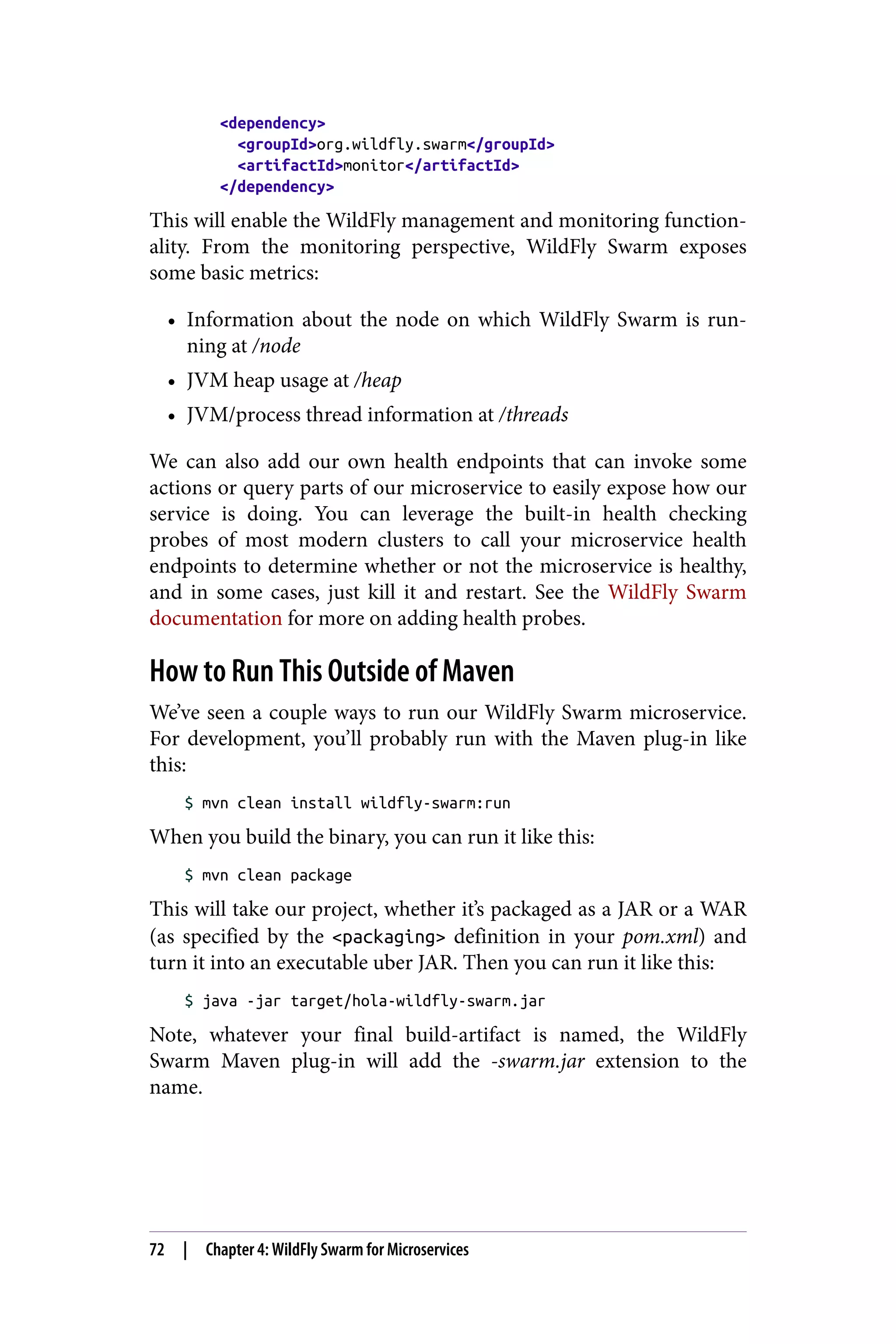
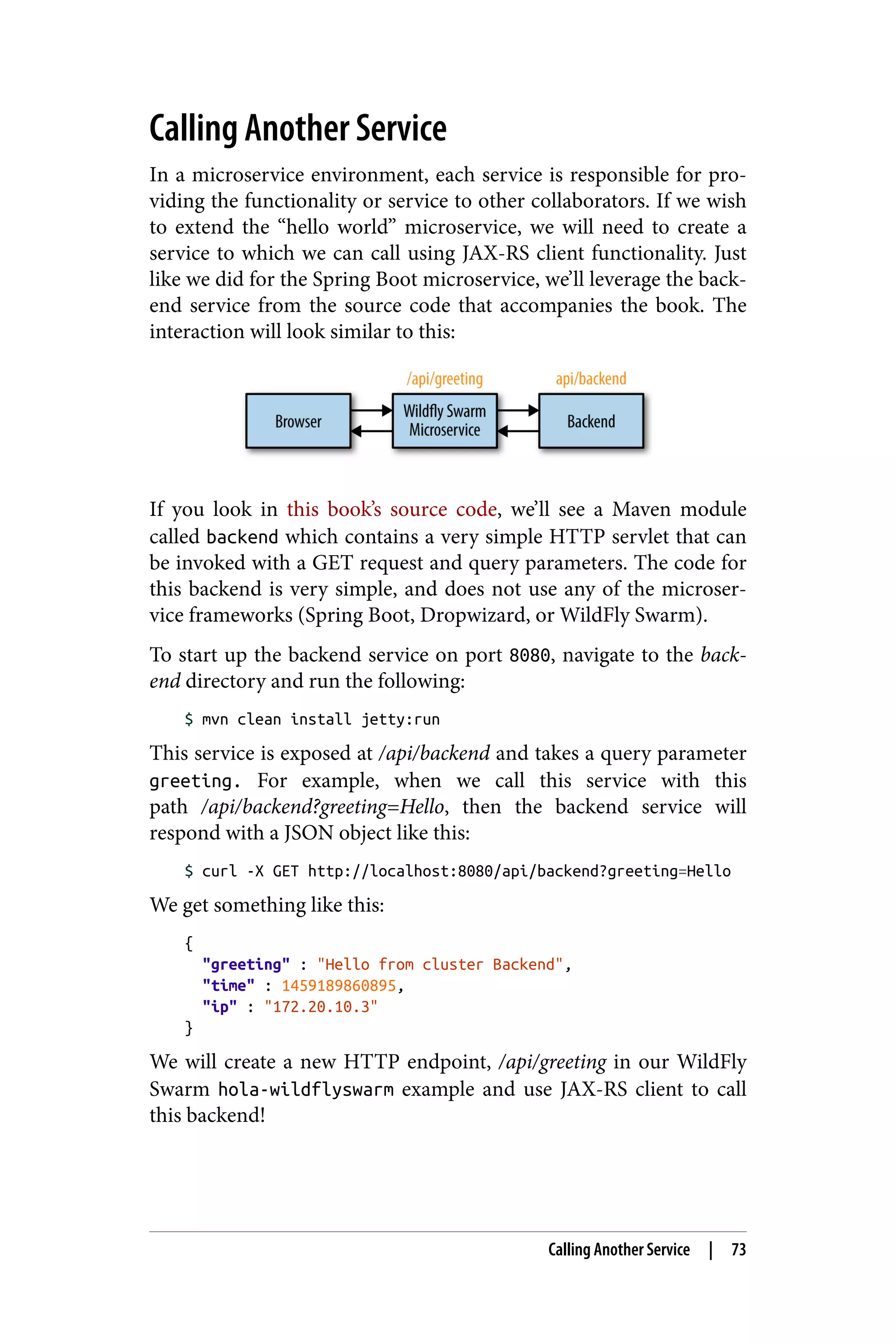

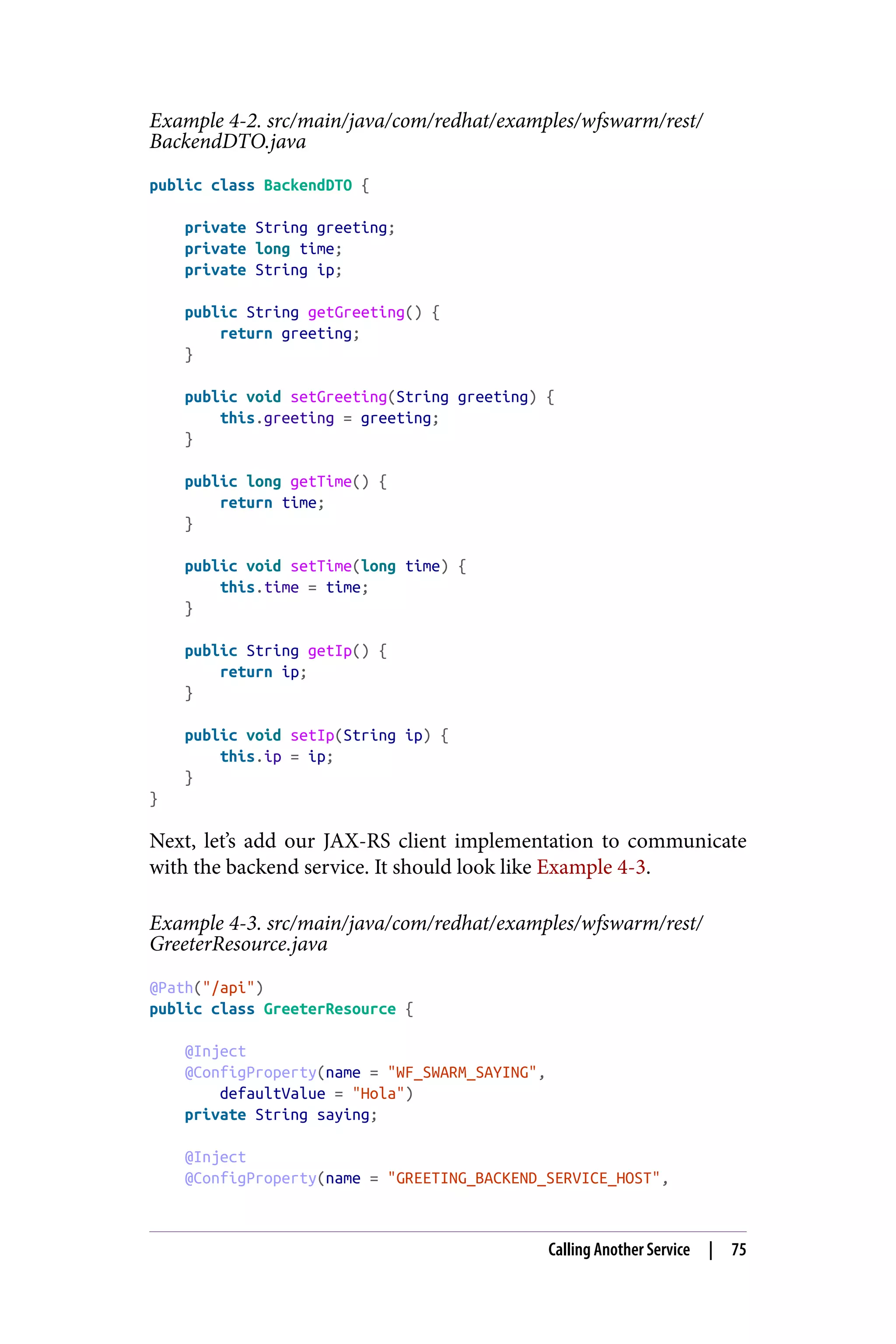
![defaultValue = "localhost")
private String backendServiceHost;
@Inject
@ConfigProperty(name = "GREETING_BACKEND_SERVICE_PORT",
defaultValue = "8080")
private int backendServicePort;
@Path("/greeting")
@GET
public String greeting() {
String backendServiceUrl = String.format("http://%s:%d",
backendServiceHost,backendServicePort);
System.out.println("Sending to: " + backendServiceUrl);
Client client = ClientBuilder.newClient();
BackendDTO backendDTO = client.target(backendServiceUrl)
.path("api")
.path("backend")
.queryParam("greeting", saying)
.request(MediaType.APPLICATION_JSON_TYPE)
.get(BackendDTO.class);
return backendDTO.getGreeting()
+ " at host: " + backendDTO.getIp();
}
}
Now we can build our microservice either using Maven at the com‐
mand line; or if you’re still in JBoss Forge, you can run the build
command:
$ mvn clean install
or:
[hola-wildflyswarm]$ build
When we start up our WildFly Swarm microservice, we will need to
specify a new HTTP port (since the backend service is already run‐
ning on port 8080), or we can just specify a port offset. If we specify
a port offset, WildFly Swarm will try to deploy under its default port
of 8080; but if that port is already in use, then it will increment the
port by the swarm.port.offset amount and try again. If we use an
offset of 1, and there is a collision on port 8080, then port 8081 will
be what WildFly Swarm tries next. Let’s run our microservice with a
port offset:
$ mvn clean install wildfly-swarm:run -Dswarm.port.offset=1
76 | Chapter 4: WildFly Swarm for Microservices](https://image.slidesharecdn.com/microservicesforjavadevelopers-190704170017/75/Microservices-for-Java-Developers-83-2048.jpg)
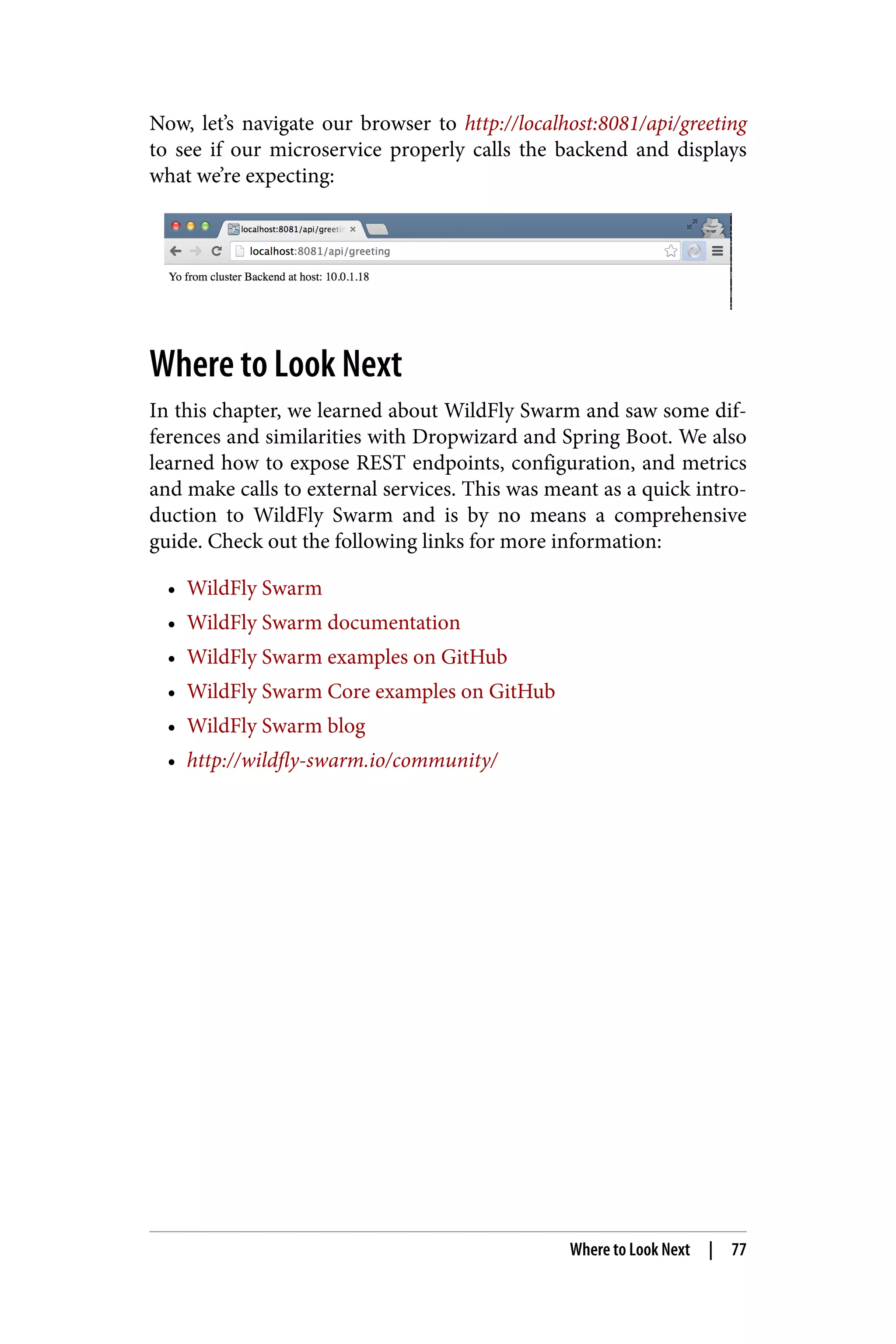

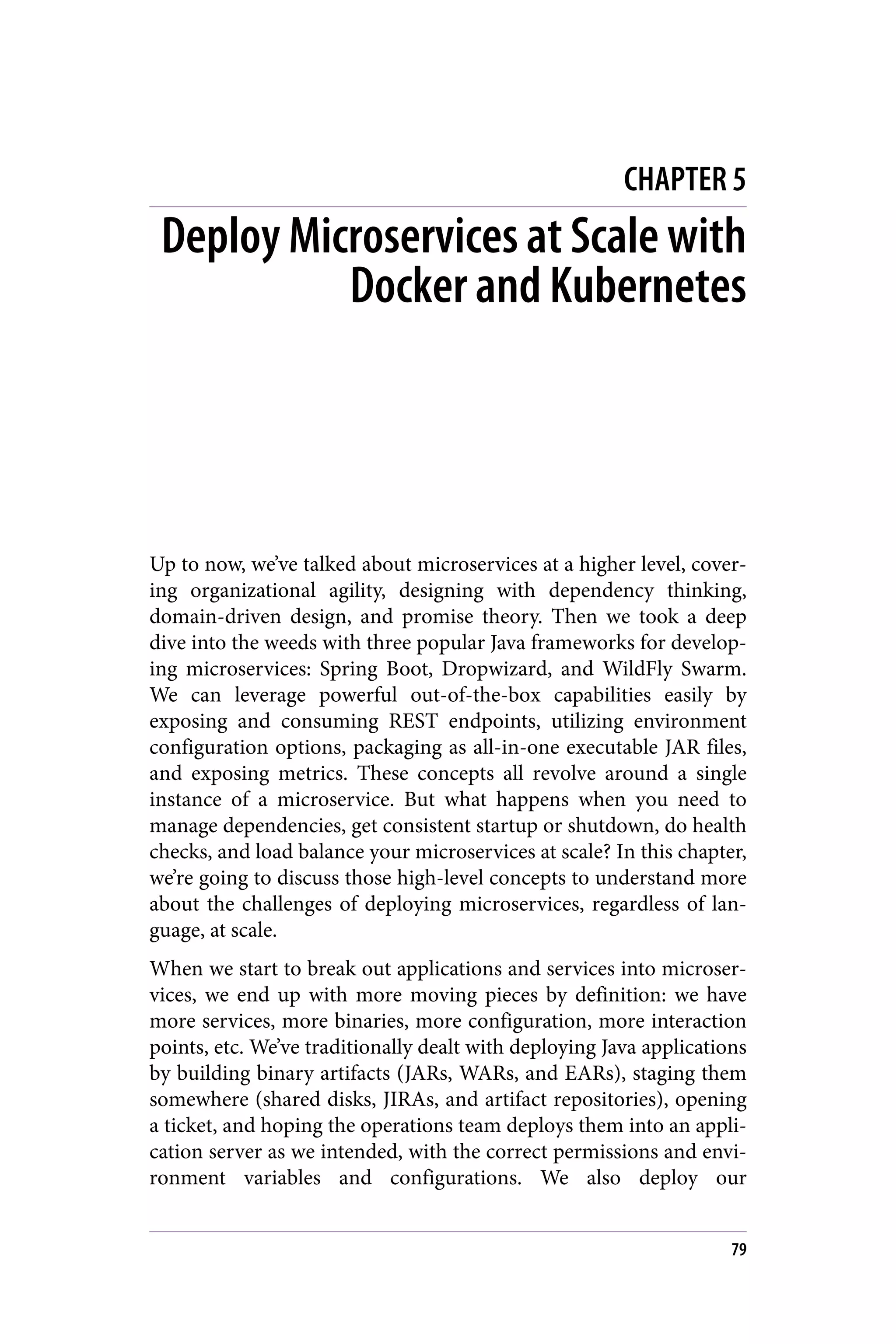
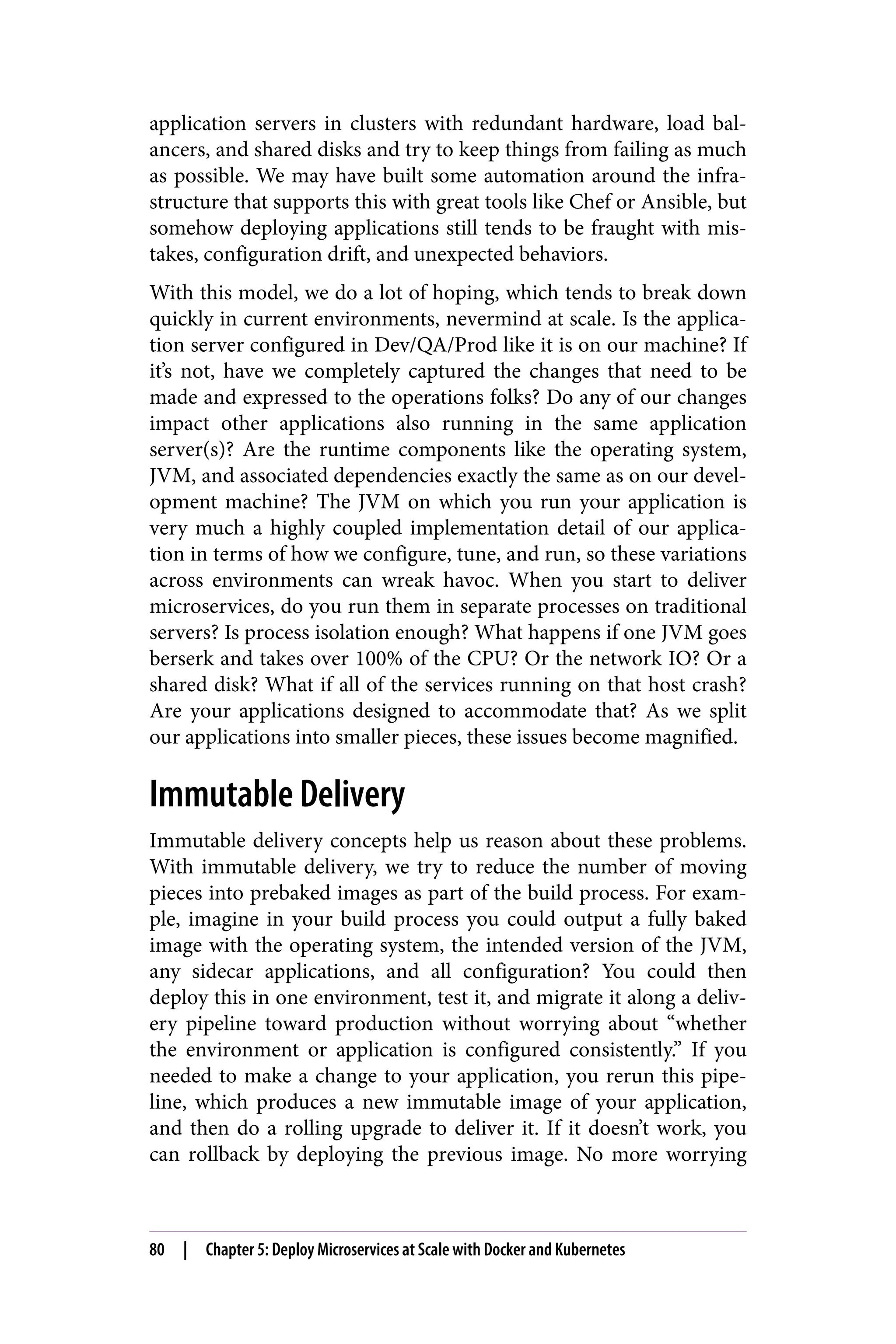
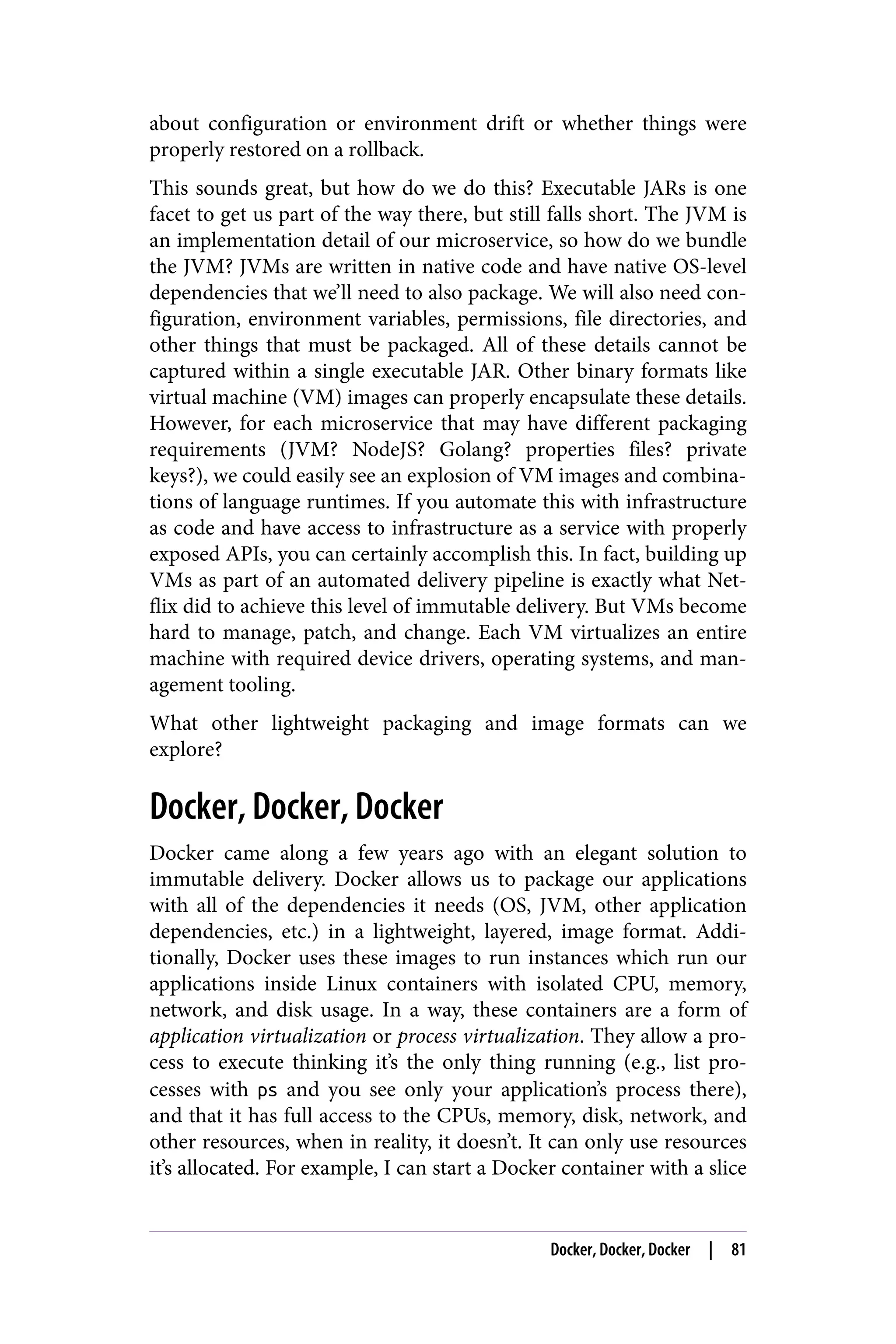
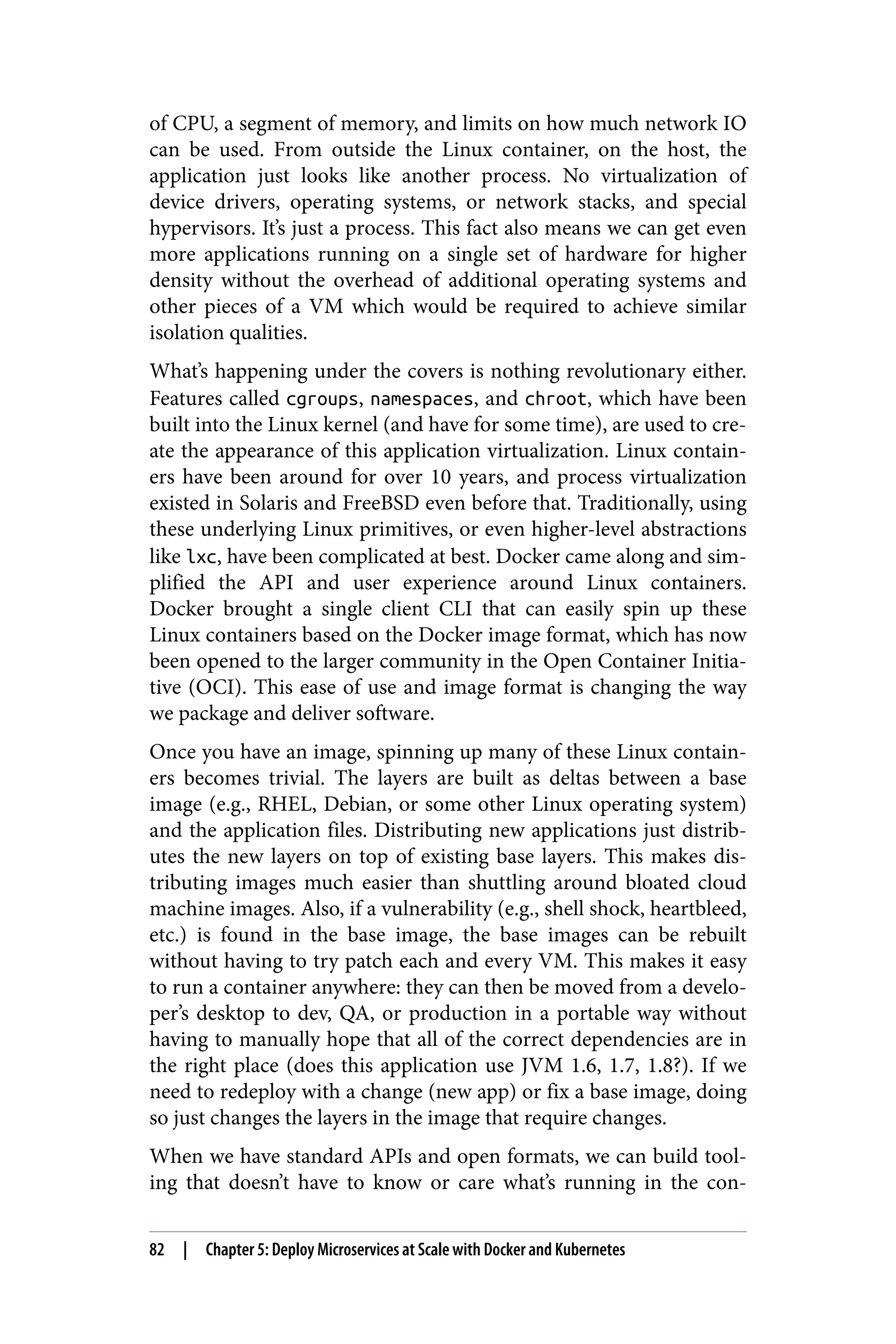
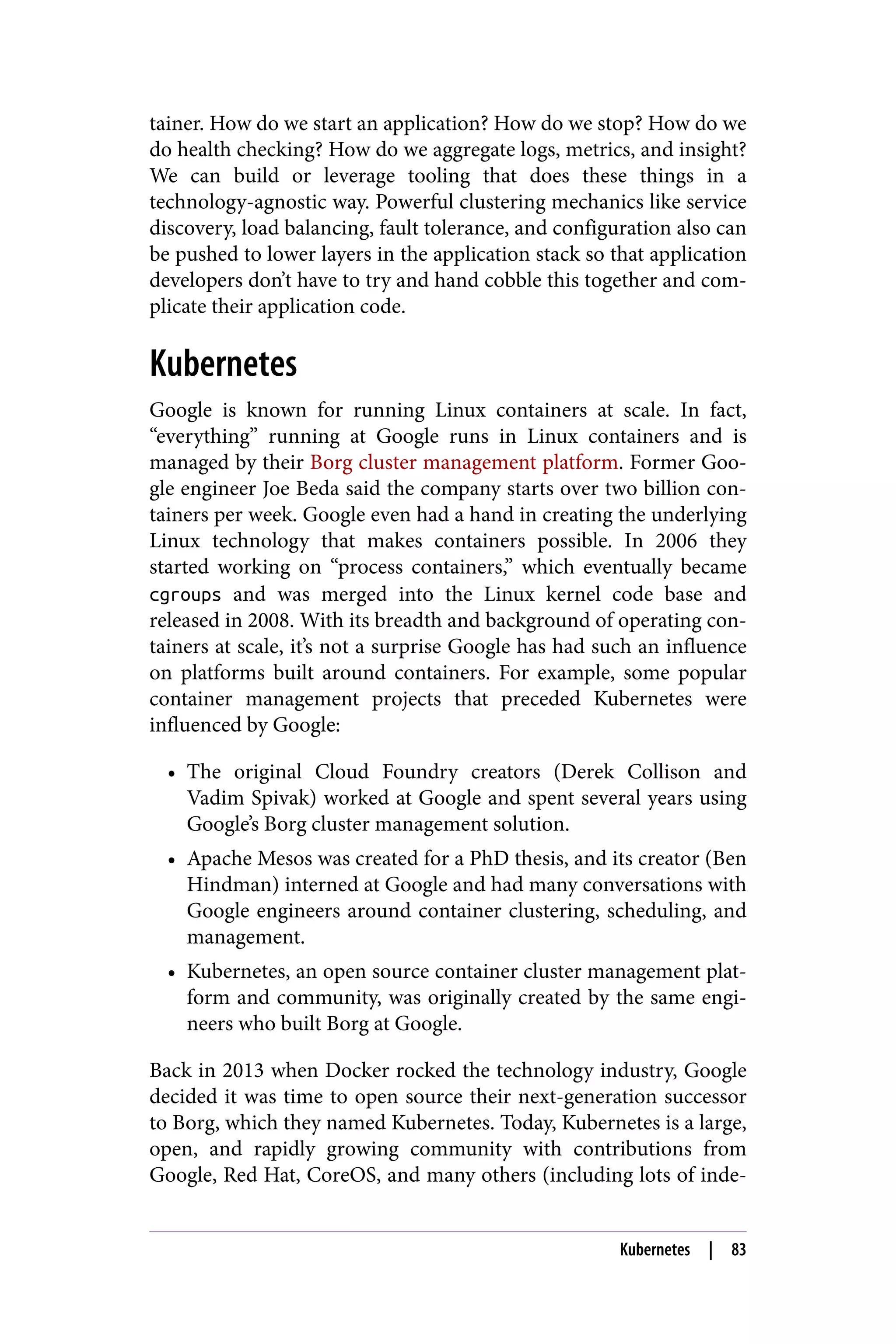
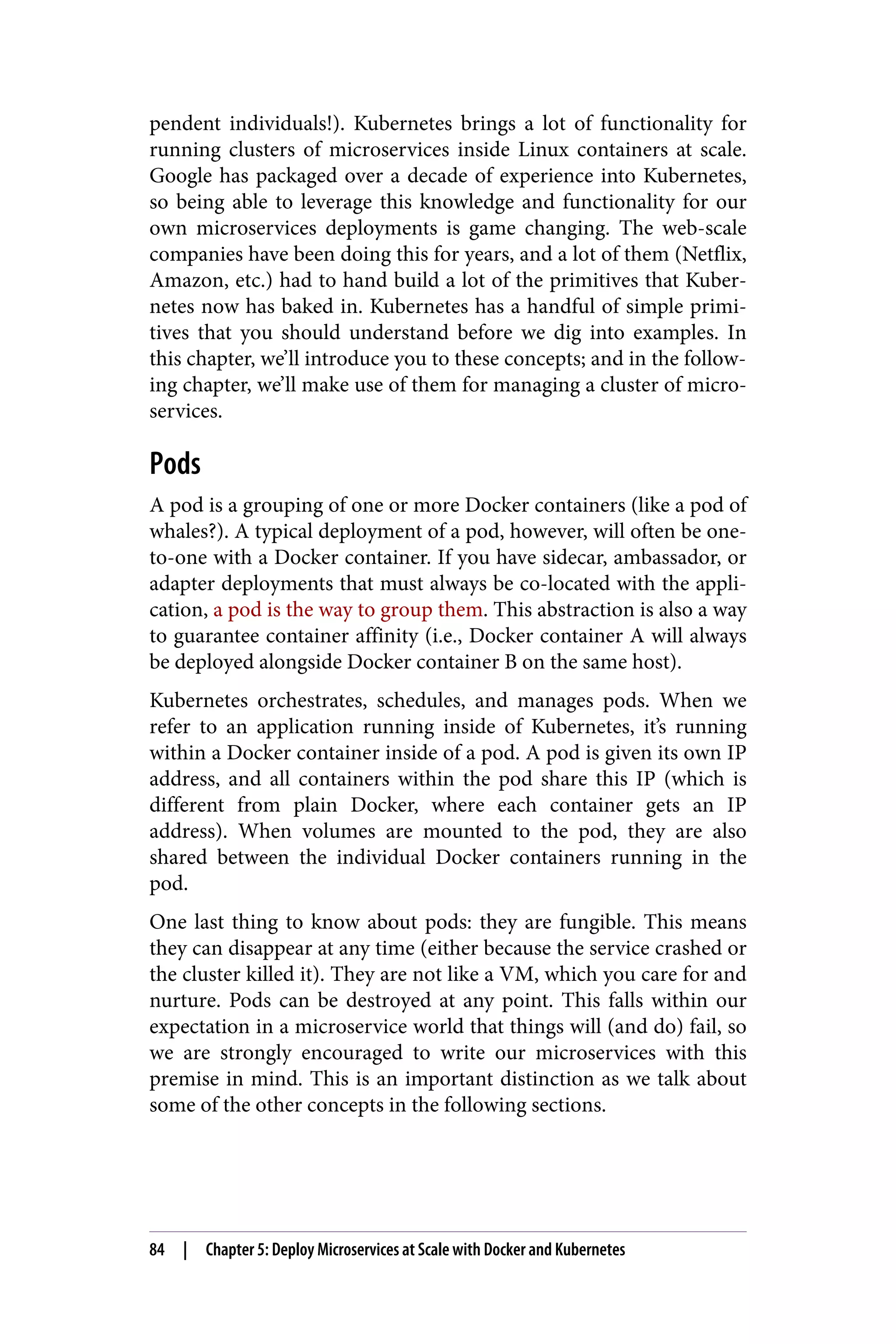
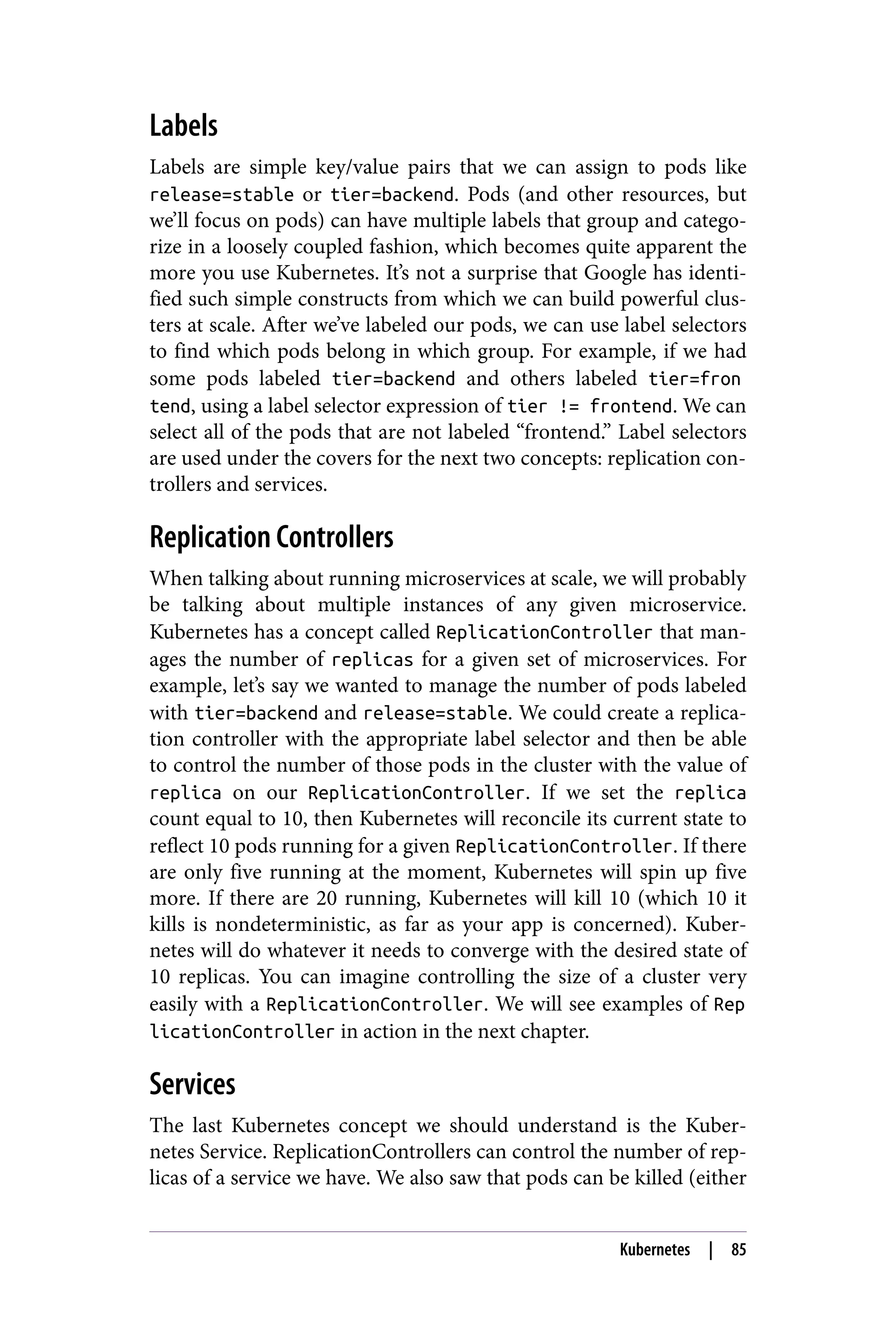

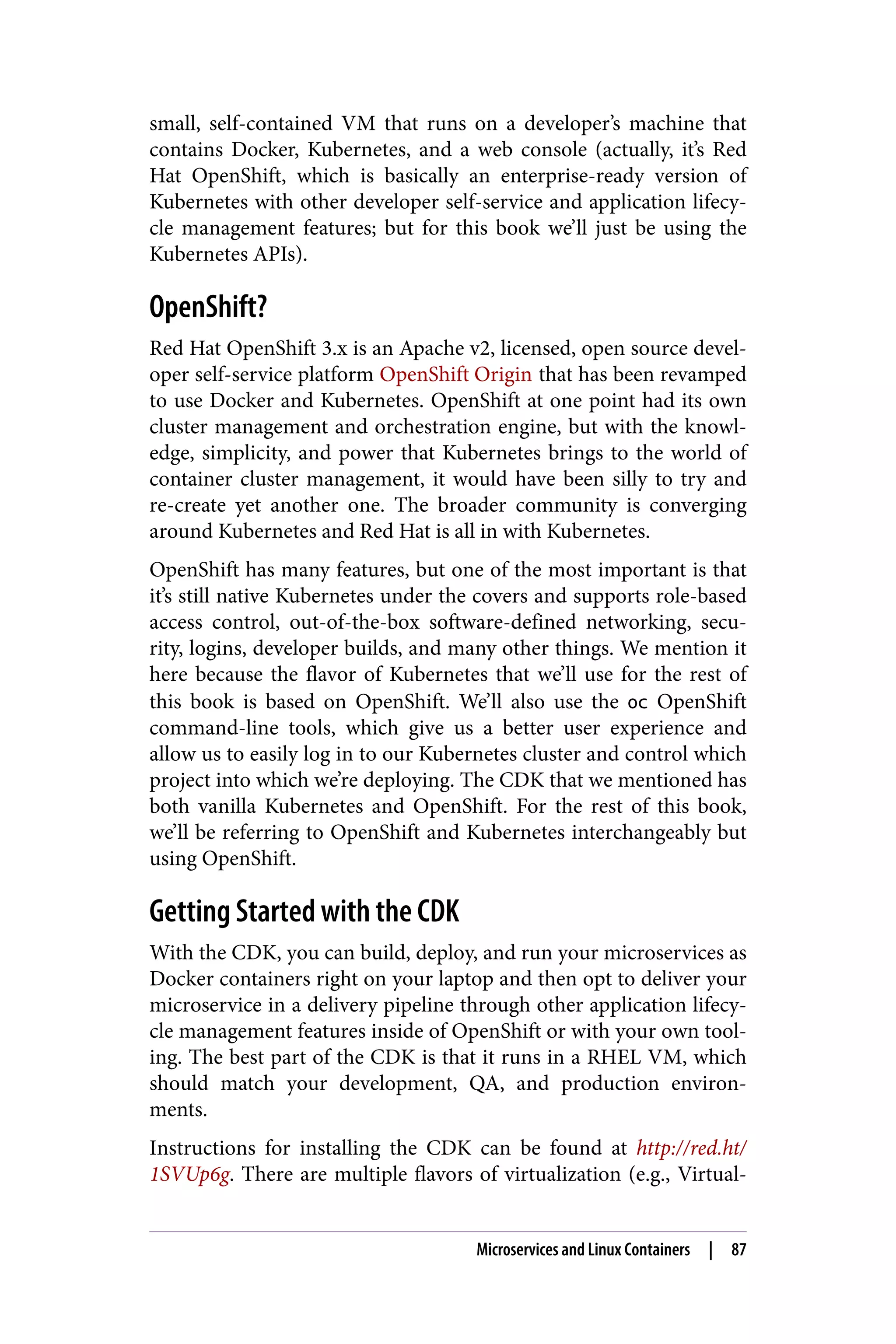

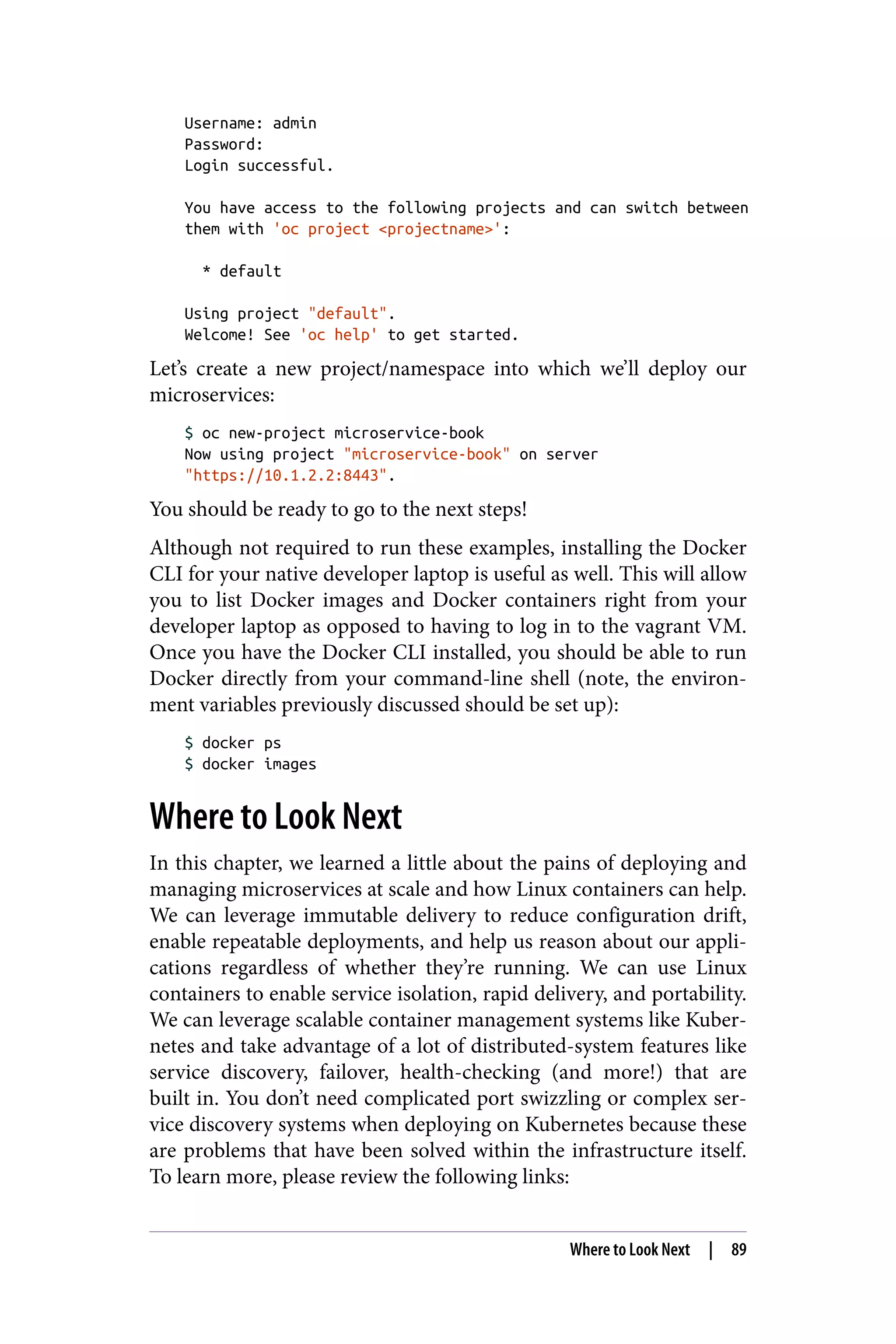
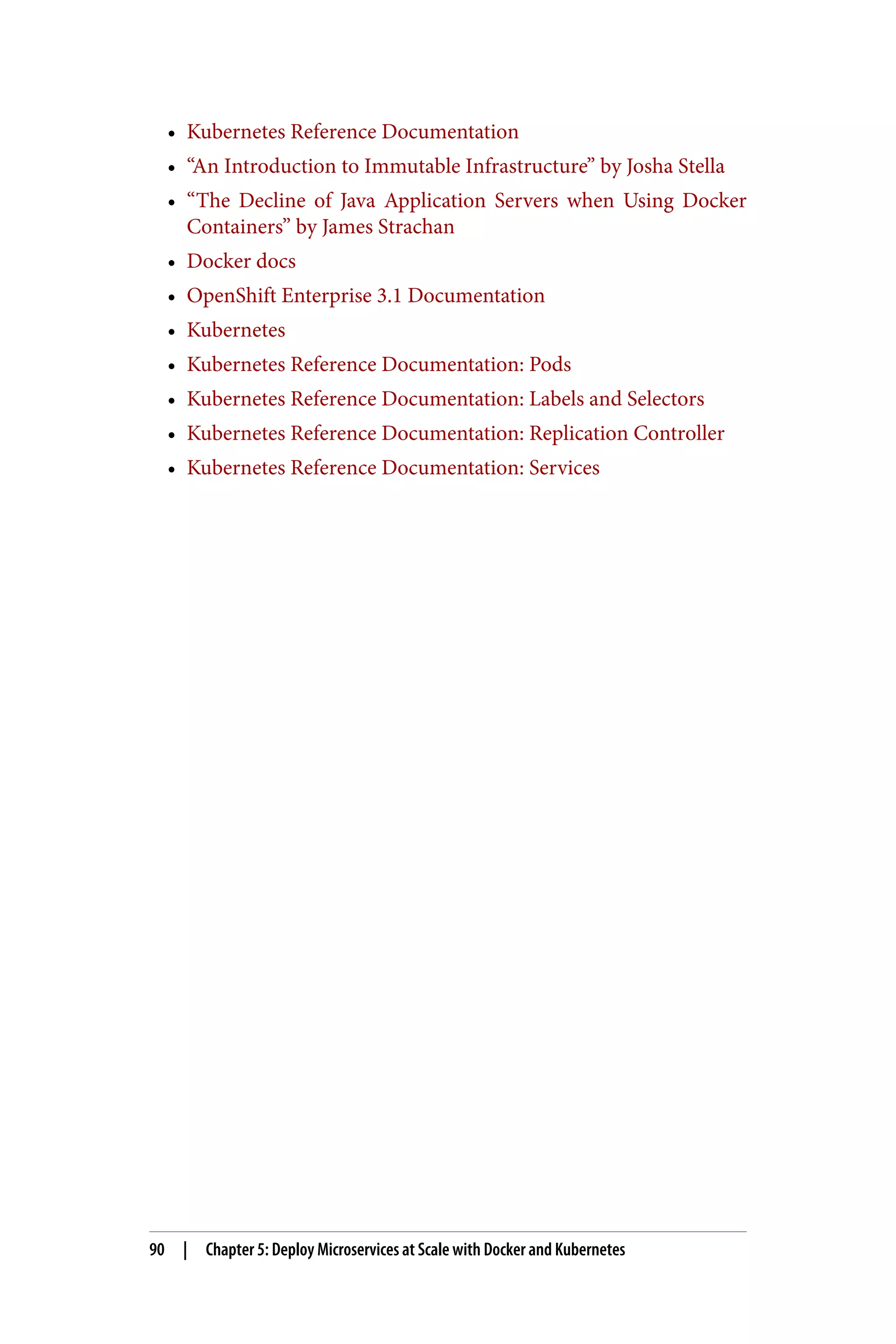
![CHAPTER 6
Hands-on Cluster Management,
Failover, and Load Balancing
In Chapter 5, we just had a quick introduction to cluster manage‐
ment, Linux containers, and cluster management. Let’s jump into
using these things to solve issues with running microservices at
scale. For reference, we’ll be using the microservice projects we
developed in Chapters 2, 3, and 4 (Spring Boot, Dropwizard, and
WildFly Swarm, respectively). The following steps can be accom‐
plished with any of the three Java frameworks.
Getting Started
To package our microservice as a Docker image and eventually
deploy it to Kubernetes, let’s navigate to our project (Spring Boot
example in this case) and return to JBoss Forge. JBoss Forge has
some plug-ins for making it easy to quickly add the Maven plug-ins
we need to use:
$ cd hola-springboot
$ forge
Now let’s install a JBoss Forge addon:
hola-springboot]$ addon-install
--coordinate io.fabric8.forge:devops,2.2.148
***SUCCESS*** Addon io.fabric8.forge:devops,2.2.148 was
installed successfully.
Now let’s add the Maven plug-ins:
91](https://image.slidesharecdn.com/microservicesforjavadevelopers-190704170017/75/Microservices-for-Java-Developers-98-2048.jpg)
![[hola-springboot]$ fabric8-setup
***SUCCESS*** Added Fabric8 Maven support with base Docker
image: fabric8/java-jboss-openjdk8-jdk:1.0.10. Added the
following Maven profiles [f8-build, f8-deploy,
f8-local-deploy] to make building the project easier,
e.g., mvn -Pf8-local-deploy
Let’s take a look at what the tooling did. If we open the pom.xml file,
we see it added some properties:
<docker.assemblyDescriptorRef>
artifact
</docker.assemblyDescriptorRef>
<docker.from>
docker.io/fabric8/java-jboss-openjdk8-jdk:1.0.10
</docker.from>
<docker.image>
fabric8/${project.artifactId}:${project.version}
</docker.image>
<docker.port.container.http>8080</docker.port.container.http>
<docker.port.container.jolokia>
8778
</docker.port.container.jolokia>
<fabric8.iconRef>icons/spring-boot</fabric8.iconRef>
<fabric8.service.containerPort>
8080
</fabric8.service.containerPort>
<fabric8.service.name>hola-springboot</fabric8.service.name>
<fabric8.service.port>80</fabric8.service.port>
<fabric8.service.type>LoadBalancer</fabric8.service.type>
It also added two Maven plug-ins: docker-maven-plugin and
fabric8-maven-plugin:
<plugin>
<groupId>io.fabric8</groupId>
<artifactId>docker-maven-plugin</artifactId>
<version>0.14.2</version>
<configuration>
<images>
<image>
<name>${docker.image}</name>
<build>
<from>${docker.from}</from>
<assembly>
<basedir>/app</basedir>
<descriptorRef>
${docker.assemblyDescriptorRef}
</descriptorRef >
</assembly>
<env>
<JAR>
92 | Chapter 6: Hands-on Cluster Management, Failover, and Load Balancing](https://image.slidesharecdn.com/microservicesforjavadevelopers-190704170017/75/Microservices-for-Java-Developers-99-2048.jpg)
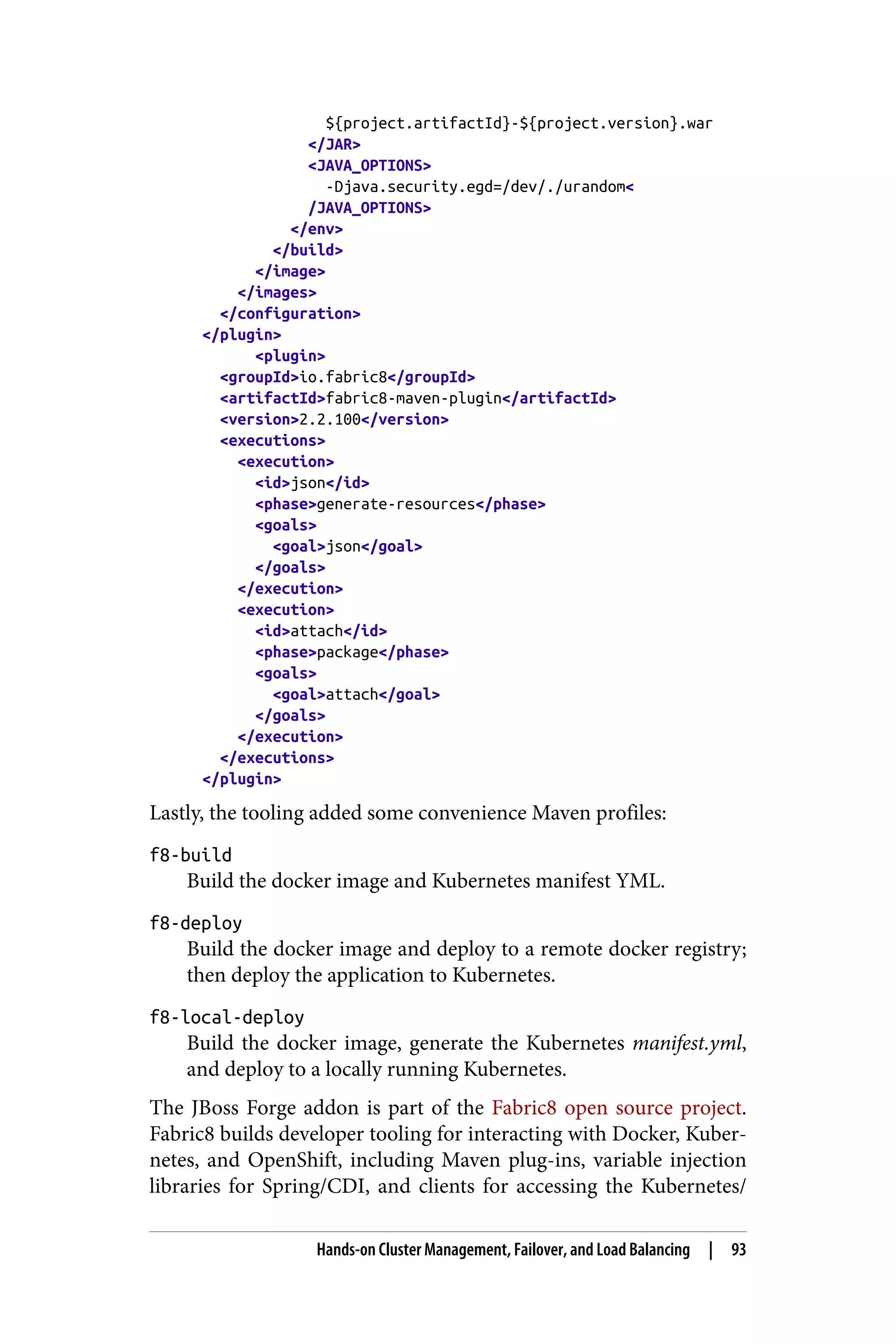
![OpenShift API. Fabric8 also builds API management, CI/CD, chaos
monkey and Kubernetes-based NetflixOSS functionality on top of
Kubernetes.
Packaging Our Microservice as a Docker Image
With the Maven plug-ins added from the previous step, all we have
to do to build the docker image is run the following Maven com‐
mand. This step, and all others related to building Docker images or
deploying to Kubernetes, assume the CDK (earlier in this chapter) is
up and running:
$ mvn -Pf8-build
[INFO] DOCKER> ... d3f157b39583 Pull complete
============= 10% ============ 20% ============
30% ============ 40% ============ 50% =============
60% ============ 70% ============ 80% ============
90% ============ 100% =
[INFO] DOCKER> ... f5a6e0d26670 Pull complete
= 100% ==
[INFO] DOCKER> ... 6d1f91fc8ac8 Pull complete
= 100% ==
[INFO] DOCKER> ... 77c58da5314d Pull complete
= 100% ==
[INFO] DOCKER> ... 1416b43aef4d Pull complete
= 100% ==
[INFO] DOCKER> ... fcc736051e6e Pull complete
[INFO] DOCKER> ... Digest: sha256:e77380a4924bb599162e3382e6443e
8aa50c0
[INFO] DOCKER> ... Downloaded image for java-jboss-openjdk8-jdk:
1.0.10
[INFO] DOCKER> [fabric8/hola-springboot:1.0] : Built image 13e72
5c3c771
[INFO]
[INFO] fabric8-maven-plugin:2.2.100:json (default-cli) @ hola-
springboot
[INFO] Configured with file: /Users/ceposta/dev/sandbox/micro
services-by-example/source/spring-boot/hola-springboot/target
/classes/kubernetes.json
[INFO] Generated env mappings: {}
[INFO] Generated port mappings: {http=ContainerPort(container
Port=8080, hostIP=null, hostPort=null, name=http, protocol=
null, additionalProperties={}), jolokia=ContainerPort(
containerPort=8778, hostIP=null, hostPort=null, name=jolokia,
protocol=null, additionalProperties={})}
[INFO] Removed 'version' label from service selector for
service ``
[INFO] Generated ports: [ServicePort(name=null, nodePort=null,
94 | Chapter 6: Hands-on Cluster Management, Failover, and Load Balancing](https://image.slidesharecdn.com/microservicesforjavadevelopers-190704170017/75/Microservices-for-Java-Developers-101-2048.jpg)
![port=80, protocol=TCP, targetPort=IntOrString(IntVal=8080,
Kind=null, StrVal=null, additionalProperties={}),
additionalProperties={})]
[INFO] Icon URL: img/icons/spring-boot.svg
[INFO] Looking at repo with directory /microservices-by-example
/.git
[INFO] Added environment annotations:
[INFO] Service hola-springboot selector: {project=hola-
springboot,
[INFO] provider=fabric8, group=com.redhat.examples}
ports: 80
[INFO] ReplicationController hola-springboot replicas: 1,
[INFO] image: fabric8/hola-springboot:1.0
[INFO] Template is now:
[INFO] Service hola-springboot selector: {project=hola-
springboot,
[INFO] provider=fabric8, group=com.redhat.examples}
ports: 80
[INFO] ReplicationController hola-springboot replicas: 1,
[INFO] image: fabric8/hola-springboot:1.0
[INFO] ------------------------------------------------------
[INFO] BUILD SUCCESS
[INFO] ------------------------------------------------------
[INFO] Total time: 04:22 min
[INFO] Finished at: 2016-03-31T15:59:58-07:00
[INFO] Final Memory: 47M/560M
[INFO] ------------------------------------------------------
Deploying to Kubernetes
If we have the Docker tooling installed, we should see that our
microservice has been packaged in a Docker container:
$ docker images
langswif01(cdk-v2 (master))$ docker images
REPOSITORY TAG IMAGE ID CREATED SIZE
fabric8/hola-springboot 1.0 13e725c3c771 3d ago 439.7 MB
We could start up the Docker container using docker run, but we
want to deploy this into a cluster and leave the management of the
microservice to Kubernetes. Let’s deploy it with the following Maven
command:
$ mvn -Pf8-local-deploy
If your environment is configured correctly (i.e., you’ve started the
CDK, installed the oc tooling, logged in with the oc login, and cre‐
ated a new project with oc new-project microservices-book),
you should see a successful build similar to this:
Hands-on Cluster Management, Failover, and Load Balancing | 95](https://image.slidesharecdn.com/microservicesforjavadevelopers-190704170017/75/Microservices-for-Java-Developers-102-2048.jpg)
![[INFO] --- fabric8-maven-plugin:apply (default-cli) @ hola-
springboot ---
[INFO] Using https://10.1.2.2:8443/ in namespace microservice-
book
[INFO] Kubernetes JSON: /Users/ceposta/dev/sandbox
[INFO] /microservices-by-example/source/spring-boot/hola-
springboot
[INFO] /target/classes/kubernetes.json
[INFO] OpenShift platform detected
[INFO] Using namespace: microservice-book
[INFO] Creating a Template from kubernetes.json namespace
[INFO] microservice-book name hola-springboot
[INFO] Created Template: target/fabric8/applyJson/microservice-
book/
[INFO] template-hola-springboot.json
[INFO] Looking at repo with directory /Users/ceposta/dev/
sandbox/
[INFO] microservices-by-example/.git
[INFO] Creating a Service from kubernetes.json namespace
[INFO] microservice-book name hola-springboot
[INFO] Created Service: target/fabric8/applyJson/microservice-
book
[INFO] /service-hola-springboot.json
[INFO] Creating a ReplicationController from kubernetes.json
namespace
[INFO] microservice-book name hola-springboot
[INFO] Created ReplicationController: target/fabric8/applyJson
[INFO] /microservice-book/replicationcontroller-hola-
springboot.json
[INFO] Creating Route microservice-book:hola-springboot host:
[INFO] -------------------------------------------------------
[INFO] BUILD SUCCESS
[INFO] -------------------------------------------------------
[INFO] Total time: 19.101 s
[INFO] Finished at: 2016-04-04T09:05:02-07:00
[INFO] Final Memory: 52M/726M
[INFO] -------------------------------------------------------
Let’s take a quick look at what the fabric8-maven-plugin plug-in
did for us.
First, Kubernetes exposes a REST API that allows us to manipulate
the cluster (what’s deployed, how many, etc.). Kubernetes follows a
“reconciliation of end state” model where you describe what you
want your deployment to look like and Kubernetes makes it happen.
This is similar to how some configuration management systems
work where you declaratively express what should be deployed and
not how it should be accomplished. When we post data to the
Kubernetes REST API, Kubernetes will reconcile what needs to hap‐
96 | Chapter 6: Hands-on Cluster Management, Failover, and Load Balancing](https://image.slidesharecdn.com/microservicesforjavadevelopers-190704170017/75/Microservices-for-Java-Developers-103-2048.jpg)
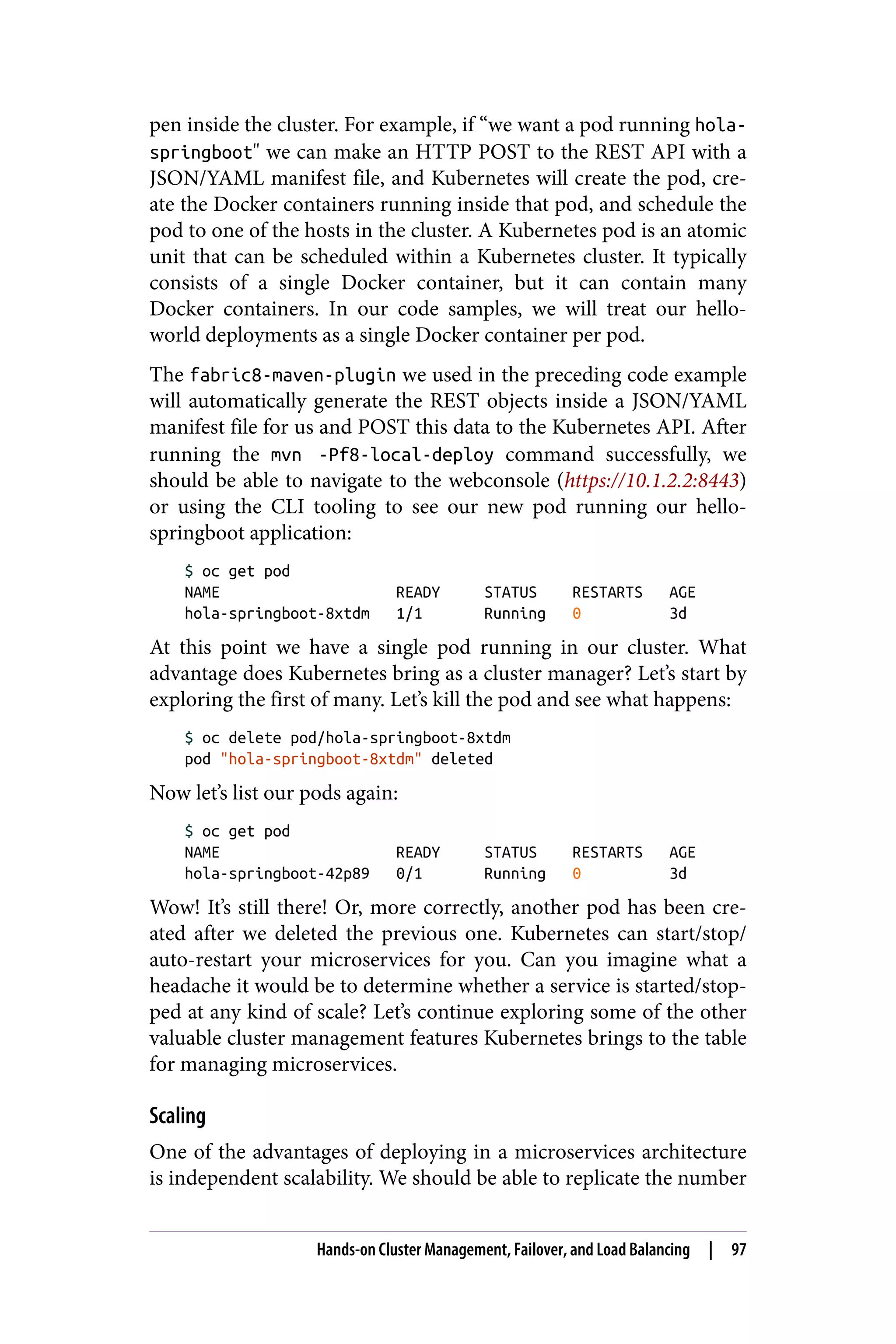
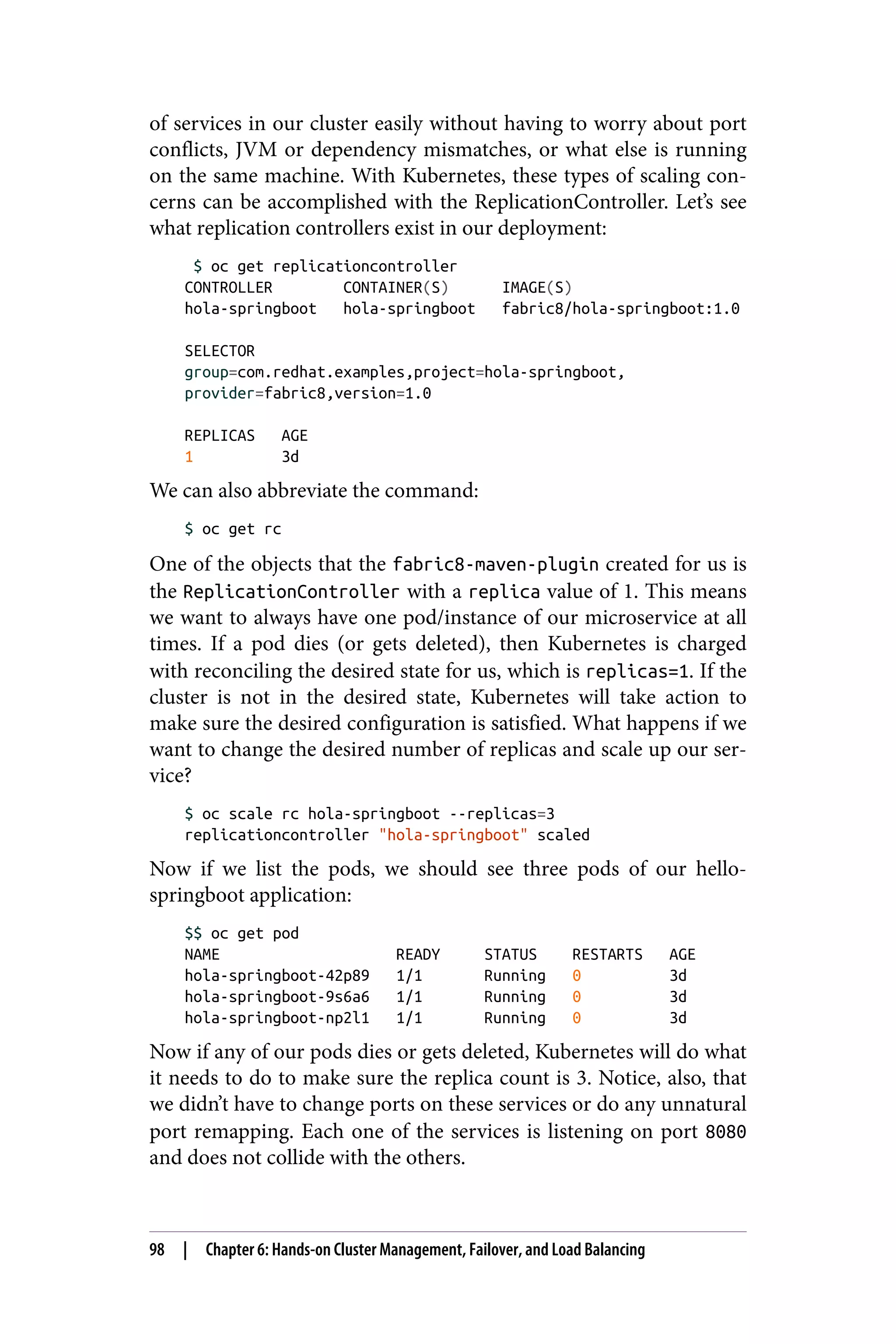
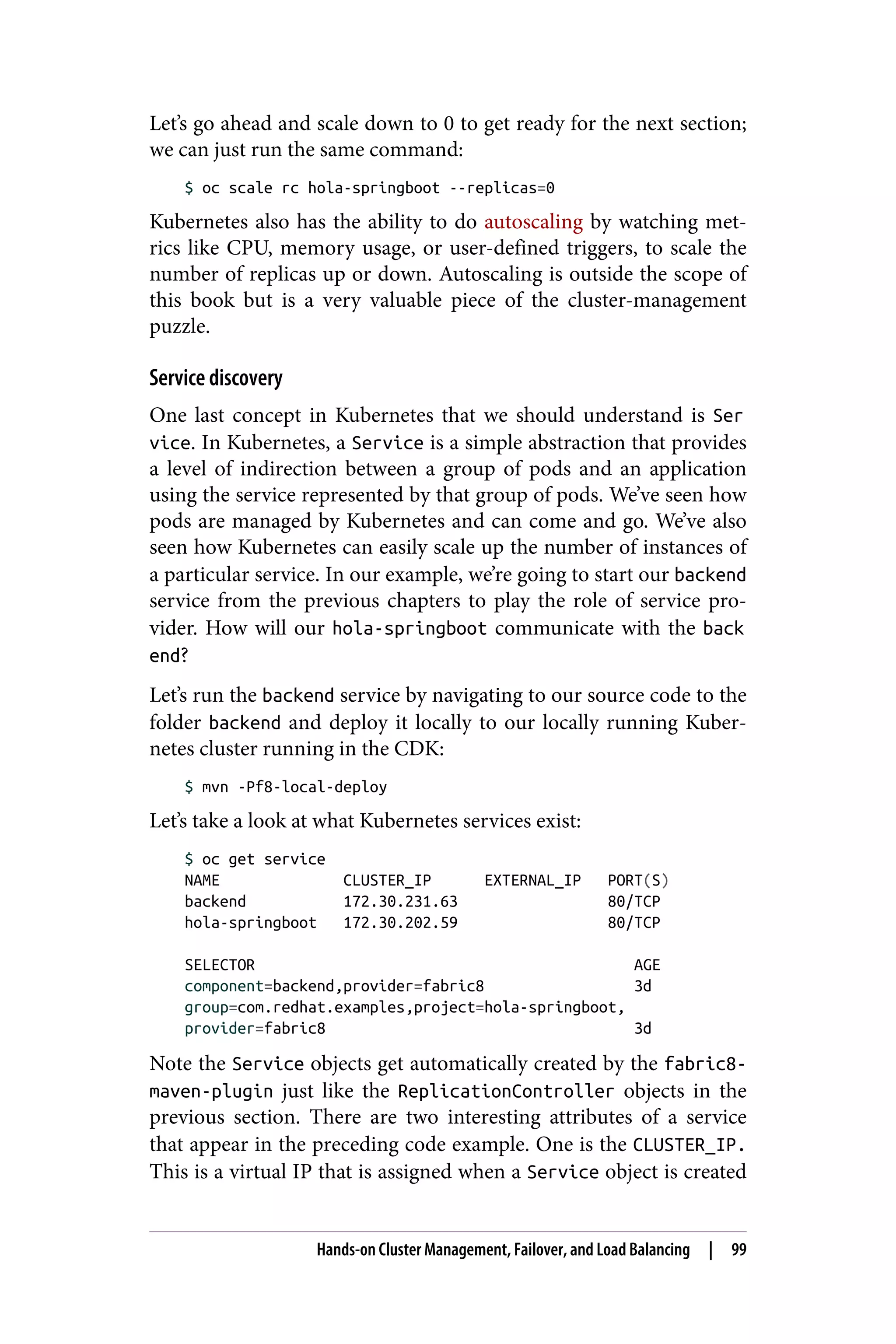
![and never goes away. It’s a single, fixed IP that is available to any
applications running within the Kubernetes cluster and can be used
to talk to backend pods. The pods are “selected” with the SELECTOR
field. Pods in Kubernetes can be “labeled” with whatever metadata
you want to apply (like “version” or “component” or “team”) and can
subsequently be used in the selector for a Service. In this example,
we’re selecting all the pods with label component=backend and pro
vider=fabric8. This means any pods that are “selected” by the
selector can be reached just by using the cluster IP. No need for
complicated distributed registries (e.g., Zookeeper, Consul, or Eur‐
eka) or anything like that. It’s all built right into Kubernetes. Cluster-
level DNS is also built into Kubernetes. Using DNS in general for
microservice service discovery can be very challenging and down‐
right painful. In Kubernetes, the cluster DNS points to the cluster
IP; and since the cluster IP is a fixed IP and doesn’t go away, there
are no issues with DNS caching and other gremlins that can pop up
with traditional DNS.
Let’s add a couple environment variables to our hola-springboot
project to use our backend service when running inside a Kuber‐
netes cluster:
<fabric8.env.GREETING_BACKENDSERVICEHOST>
backend<
/fabric8.env.GREETING_BACKENDSERVICEHOST>
<fabric8.env.GREETING_BACKENDSERVICEPORT>
80
</fabric8.env.GREETING_BACKENDSERVICEPORT>
Let’s build the Kubernetes manifest and verify we’re passing in these
environment variables to our pod. Note that Spring Boot will resolve
configuration from application.properties but can be overridden
with system properties and environment variables at runtime:
$ mvn fabric8:json
Inspect file target/classes/kubernetes.json:
"containers" : [ {
"args" : [ ],
"command" : [ ],
"env" : [ {
"name" : "GREETING_BACKENDSERVICEHOST",
"value" : "backend"
}, {
"name" : "GREETING_BACKENDSERVICEPORT",
"value" : "80"
100 | Chapter 6: Hands-on Cluster Management, Failover, and Load Balancing](https://image.slidesharecdn.com/microservicesforjavadevelopers-190704170017/75/Microservices-for-Java-Developers-107-2048.jpg)
![}, {
"name" : "KUBERNETES_NAMESPACE",
"valueFrom" : {
"fieldRef" : {
"fieldPath" : "metadata.namespace"
}
}
} ],
Let’s delete all of the pieces of the hola-springboot project and
redeploy:
$ oc delete all -l project=hola-springboot
$ mvn -Pf8-local-deploy
We should now be able to list the pods and see our hola-
springboot pod running as well as our backend service pod:
$ oc get pod
NAME READY STATUS RESTARTS AGE
backend-nk224 1/1 Running 5 3d
hola-springboot-r5ykr 1/1 Running 0 2m
Now, just to illustrate a handy debugging technique, we’re going to
set up port-forwarding between our local machine and our hola-
springboot-r5ykr pod and verify that our service is working cor‐
rectly and we can call the backend. Let’s set up portforward to port
9000 on our local machine:
$ oc port-forward -p hola-springboot-r5ykr 9000:8080
We should not be able to communicate with the pod over our local‐
host port 9000. Note this technique works great even across a
remote Kubernetes cluster, not just on our local CDK. So instead of
having to try and find which host our pod is running and how to
ssh into it, we can just use oc port-forward to expose it locally.
So now we should be able to navigate locally using our browser or a
CLI command line:
$ curl http://localhost:9000/api/hola
Hola Spring Boot de 172.17.0.9
We can see the /api/hola endpoint at http://localhost:9000 using
our port-forwarding! We also see that the /api/hola endpoint is
returning the IP address of the pod in which it’s running. Let’s call
the /api/greeting API, which is supposed to call our backend:
$ curl http://localhost:9000/api/greeting
Hola Spring Boot from cluster Backend at host: 172.17.0.5
Hands-on Cluster Management, Failover, and Load Balancing | 101](https://image.slidesharecdn.com/microservicesforjavadevelopers-190704170017/75/Microservices-for-Java-Developers-108-2048.jpg)
